By Sam Robinson |
at September 9, 2022 10:35 pm
Compared to the Alex Smith-led seven-win 2020 Washington edition that won the NFC East, Washington’s seven-win 2021 flew well under the radar. Dak Prescott‘s return predictably raised the bar in the division, which produced a historically bad collection of teams in 2020. Washington will have a third team name in four years and a sixth Week 1 starting quarterback over the past six. But coaching-staff continuity exists. And the Commanders’ receiving corps stands to be deeper than it has been since the Pierre Garcon–DeSean Jackson–Jamison Crowder period.
Of course, all eyes will be on the team’s third QB1 trade acquisition since 2018. The outcome of that deal probably determines how much longer Ron Rivera‘s staff lasts with the team.
Trades:
- Acquired QB Carson Wentz, 2022 second-round pick, 2022 seventh-rounder from Colts for 2022 second- and third-round picks and conditional 2023 Day 2 choice
After seeing its 2021 Ryan Fitzpatrick plan last all of 16 snaps, Washington needed to pivot to wild-card surprise Taylor Heinicke as a full-time starter. The Commanders held the No. 11 pick in a draft that featured an unremarkable quarterback crop. These factors likely pushed Rivera to declare the team needed a veteran. While Washington made inquiries on just about every available arm — one of those an offer of three first-round picks for Russell Wilson, who refused to waive his no-trade clause for the Commanders — the end result of the team’s QB crusade surprised many.
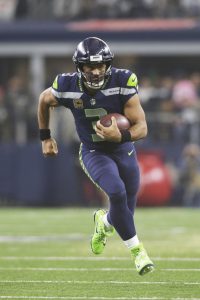 Jim Irsay had made it no secret he wanted Wentz gone, limiting Colts GM Chris Ballard’s leverage. It is not known what other teams were in the Wentz market. Despite what appeared to be a limited market, Indianapolis sent Wentz to Washington for a surprising haul. The Commanders initially offered fourth- and sixth-rounders for Wentz, but Ballard drove them to a third, a conditional third that could climb to a second, and a 2022 Round 2 pick swap that allowed the Colts to move up five spots. Similar to the terms of 2021’s Eagles-Colts Wentz deal, if the QB plays 70% of the Commanders’ snaps this year, the 2023 pick becomes a second-rounder.
Jim Irsay had made it no secret he wanted Wentz gone, limiting Colts GM Chris Ballard’s leverage. It is not known what other teams were in the Wentz market. Despite what appeared to be a limited market, Indianapolis sent Wentz to Washington for a surprising haul. The Commanders initially offered fourth- and sixth-rounders for Wentz, but Ballard drove them to a third, a conditional third that could climb to a second, and a 2022 Round 2 pick swap that allowed the Colts to move up five spots. Similar to the terms of 2021’s Eagles-Colts Wentz deal, if the QB plays 70% of the Commanders’ snaps this year, the 2023 pick becomes a second-rounder.
Wentz’s stock has undoubtedly plunged since his would-be MVP season in 2017, but there are multiple ways to look at his Colts season. On one hand, the Colts equipped him with his old offensive coordinator (Frank Reich), a strong O-line and the runaway rushing champion (Jonathan Taylor). The Colts also trotted out a receiving corps that featured Michael Pittman Jr. and, with T.Y. Hilton aging and Parris Campbell again injured, little else of consequence. Wentz, 29, still threw 27 touchdown passes, seven interceptions and rated ninth in QBR — his highest finish since slotting first in 2017.
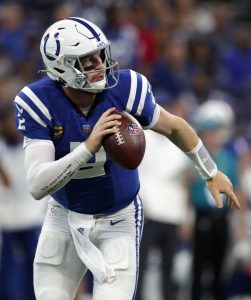 Taking issue with Wentz’s leadership, erratic play and refusal to be vaccinated against COVID-19, issues leading to a late-season Colts collapse, Irsay ordered his staff to ditch the six-year veteran — who cost Indy first- and second-round picks. Although the Commanders were high on Wentz’s arm strength and 6-foot-5 frame, he was far from their first choice. Wilson and Aaron Rodgers could not be acquired, and Washington even sent out an Andrew Luck feeler. The former Colts star appears to be content in retirement. In Wentz, however, the team probably has its best quarterback since before a pre-injury Alex Smith.
Taking issue with Wentz’s leadership, erratic play and refusal to be vaccinated against COVID-19, issues leading to a late-season Colts collapse, Irsay ordered his staff to ditch the six-year veteran — who cost Indy first- and second-round picks. Although the Commanders were high on Wentz’s arm strength and 6-foot-5 frame, he was far from their first choice. Wilson and Aaron Rodgers could not be acquired, and Washington even sent out an Andrew Luck feeler. The former Colts star appears to be content in retirement. In Wentz, however, the team probably has its best quarterback since before a pre-injury Alex Smith.
This represents Rivera’s first big swing at QB in Washington. He inherited Smith and Dwayne Haskins and passed on a trade-up for Justin Fields or Mac Jones in 2021. March’s deal included the Commanders taking on all of Wentz’s salary. Washington’s decision immediately produced a fair amount of criticism. As unpopular as Wentz has become, he does have nonguaranteed salaries ($20MM, $21MM) in 2023 and ’24. And he also fared decently (11th in QBR) with a 2019 Eagles team riddled with receiver injuries. But this Commanders setup profiles as the North Dakota State product’s last chance to be a locked-in QB1.
Depending on Curtis Samuel‘s health, the Commanders have given Wentz perhaps the best receiving corps of his career. How this season goes could well determine if Rivera has a post-2022 future in Washington. That is a lot of hope to place on a player the Eagles and Colts jettisoned in consecutive offseasons, but the Commanders were short on options. The Cousins-Bruce Allen falling out led the team’s only recent franchise-QB hope out of town, and Smith’s injury wrecked the subsequent plan. Haskins did not pan out, and Fitzpatrick was a low-end stopgap. Since Cousins’ 2018 exit, Washington has started an NFL-most 10 quarterbacks. Not much is expected of this Commanders team; Wentz silencing swaths of skeptics would change that.
Free agency additions:
- Andrew Norwell, G. Two years, $10MM. $4.7MM guaranteed.
- Trai Turner, G. One year, $3MM. $1.45MM guaranteed.
- Efe Obada, DE. One year, $1.19MM. $353K guaranteed.
- Jon Bostic, LB. One year, $1.12MM.
- David Mayo, LB. One year, $1.12MM.
Like Wentz, Washington circled to retreads at guard. The Commanders are team No. 3 for Norwell and No. 4 for Turner; each is an eight-year veteran that has history with Rivera. These signings — Norwell in March, Turner in May — reunite the Panthers’ Super Bowl 50 guard tandem. With Joey Slye at kicker and Samuel making it three ex-Carolina cogs who will start for the Commanders’ offense, Panthers North headquarters appears to have moved from Buffalo to Washington.
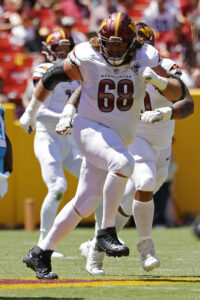 Norwell, 30, fetched a monster free agency deal from the Jaguars in 2018. That came after the Panthers prioritized Turner — via a four-year, $45MM deal — and let Norwell walk. Jacksonville did not see Norwell replicate his contract-year All-Pro season, but Pro Football Focus still gave the former UDFA top-30 grades from 2018-20. Norwell nevertheless took a pay cut after the 2020 season. Last year, Norwell dropped outside PFF’s top 40 at guard.
Norwell, 30, fetched a monster free agency deal from the Jaguars in 2018. That came after the Panthers prioritized Turner — via a four-year, $45MM deal — and let Norwell walk. Jacksonville did not see Norwell replicate his contract-year All-Pro season, but Pro Football Focus still gave the former UDFA top-30 grades from 2018-20. Norwell nevertheless took a pay cut after the 2020 season. Last year, Norwell dropped outside PFF’s top 40 at guard.
Turner’s market appeared more limited than Norwell’s. The Chargers punted on their UFA deal with the longtime Panthers starter in 2021, and the Steelers did not show interest in extending their partnership beyond one year. After the former third-round pick submitted a rough 2020, which included seven injury-induced absences, the Steelers received 17 starts from their rental guard. Turner, 29, was viewed as an upper-echelon guard for most of his Carolina tenure. Upon rejoining Rivera and OC Scott Turner in D.C., however, Turner did miss a month of training camp due to a quad injury.
While neither Turner nor Norwell at this juncture of their careers profiles as a long-term solution, Rivera’s old charges do give his current team one of the NFL’s most experienced guard duos. Norwell has 111 career starts, Turner 106. Swingman Wes Schweitzer (54 career starts; 18 with Washington) offers considerable experience as well.
Re-signings:
- Charles Leno, T. Three years, $37MM. $9MM guaranteed.
- Bobby McCain, DB. Two years, $10MM. $4.7MM guaranteed.
- J.D. McKissic, RB. Two years, $7MM. $3.65MM guaranteed.
- Cornelius Lucas, T. Two years, $6.5MM. $2.92MM guaranteed.
- Joey Slye, K. Two years, $4.2MM. $2MM guaranteed.
- Jonathan Williams, RB. One year, $1.05MM. $20K guaranteed.
Although Brandon Scherff‘s seven-year Commanders tenure is over, the team is still banking on veterans up front. Leno joins Norwell and Turner as a ninth-year veteran. Right tackle Sam Cosmi represents the team’s only rookie-deal O-line starter; the rest of the group has a combined 29 seasons’ worth of experience. Backups Schweitzer and Lucas are also veteran-contract players.
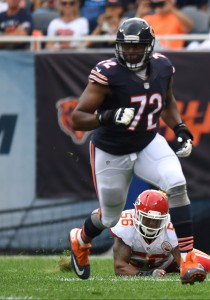 PFF’s numbers are not the end-all, be-all, but the advanced metrics site gave Leno a career-high grade and slotted him as its 12th-best tackle last season. That marked a staggering bounce-back year for the longtime Bears left tackle, whom Chicago cut shortly after the 2021 draft. Washington took a $5MM flier on Leno last year and will now look to him to be a longer-term answer. Washington had cycled through blindsides since the 2019 Trent Williams fiasco, going from Donald Penn to Lucas to Leno. The former Bears seventh-rounder started 17 Washington games and, reminding of Morgan Moses, has not missed a contest since his 2014 rookie year.
PFF’s numbers are not the end-all, be-all, but the advanced metrics site gave Leno a career-high grade and slotted him as its 12th-best tackle last season. That marked a staggering bounce-back year for the longtime Bears left tackle, whom Chicago cut shortly after the 2021 draft. Washington took a $5MM flier on Leno last year and will now look to him to be a longer-term answer. Washington had cycled through blindsides since the 2019 Trent Williams fiasco, going from Donald Penn to Lucas to Leno. The former Bears seventh-rounder started 17 Washington games and, reminding of Morgan Moses, has not missed a contest since his 2014 rookie year.
Leno now tops the Commanders’ cost-controlled O-line, which ditched Scherff’s franchise tag redux cap figure this offseason. While no Commanders blocker is attached to a top-five salary at his respective position — Leno’s comes in 18th among left tackles — Chase Roullier‘s $10.13MM-per-year deal does rank sixth among centers. Post-Scherff, the Commanders are counting on Leno and Roullier to lead the way.
Moving the number of ninth-year vets on the Commanders’ O-line to four, Lucas worked as Washington’s right and left tackle at points during his two-year tenure with the team. The Rivera-era acquisition could fill in with Washington’s 1s, as he did 15 times from 2020-21, but Leno-Cosmi is the team’s preferred tackle configuration. PFF gave Lucas and Cosmi near-identical 2021 grades, slotting each inside the top 30 at the position. Lucas, 31, has played for five teams since coming into the league as a UDFA. He should be nice depth for an O-line flooded with experience.
Read more
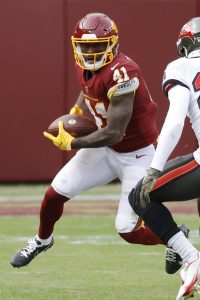 McKissic backed out of a two-year, $7MM Bills agreement to sign with his previous team. Considering where the Bills and Commanders are viewed leaguewide, that represented an interesting decision from the veteran passing-down back. Bills GM Brandon Beane was no fan of the Commanders continuing to pursue McKissic after his Bills agreement emerged, but the four-team veteran will stay put. With Brian Robinson out for a while, Antonio Gibson and McKissic stand to be the backfield’s regulars. McKissic, 29, provided a nice outlet option for Smith during his comeback year, catching 80 passes (by far the most among running backs in 2020) for 589 yards. An injury shortened McKissic’s 2021 campaign.
McKissic backed out of a two-year, $7MM Bills agreement to sign with his previous team. Considering where the Bills and Commanders are viewed leaguewide, that represented an interesting decision from the veteran passing-down back. Bills GM Brandon Beane was no fan of the Commanders continuing to pursue McKissic after his Bills agreement emerged, but the four-team veteran will stay put. With Brian Robinson out for a while, Antonio Gibson and McKissic stand to be the backfield’s regulars. McKissic, 29, provided a nice outlet option for Smith during his comeback year, catching 80 passes (by far the most among running backs in 2020) for 589 yards. An injury shortened McKissic’s 2021 campaign.
Becoming a haven for veterans whose previous teams did not prioritize them, Washington went to the retread well with McCain shortly after his Miami release. The longtime Dolphin started 16 Washington games and intercepted a career-high four passes. The 29-year-old defender is part of an experienced secondary, which features seventh-year cornerbacks William Jackson and Kendall Fuller, and has restabilized his career as a Commanders safety.
Notable losses:
- Kyle Allen, QB (nontendered as RFA)
- DeAndre Carter, WR
- Landon Collins, S (designated as post-June 1 cut)
- Jamil Douglas, OL
- Corn Elder, DB
- Deshazor Everett, S (released)
- Ryan Fitzpatrick, QB (retired)
- Ereck Flowers, G (released)
- Antonio Gandy-Golden, WR/TE (retired)
- Garrett Gilbert, QB
- D.J. Hayden (released)
- Adam Humphries, WR
- Matt Ioannidis (released)
- Darryl Roberts, CB
- Brandon Scherff, G
- Ricky Seals-Jones, TE
- Tim Settle, DT
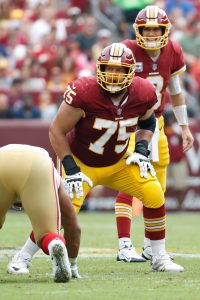 PFF graded Washington’s O-line sixth overall last season. Generally teams with upper-crust O-lines do not produce poor records, though Washington being saddled with a full season of Heinicke does differentiate its previous situation. But the best Washington O-lineman is now gone, ending another two-franchise tag saga.
PFF graded Washington’s O-line sixth overall last season. Generally teams with upper-crust O-lines do not produce poor records, though Washington being saddled with a full season of Heinicke does differentiate its previous situation. But the best Washington O-lineman is now gone, ending another two-franchise tag saga.
Scherff’s two-tag period did not produce the fireworks Cousins’ did, and his free agency run received a fraction of the interest Cousins’ generated four years ago. But it will be a tough ask for the Commanders to replace the five-time Pro Bowler. Turning 30 last December, Scherff had neither received a long-term contract nor enjoyed a free agency bid. His atypical contractual path aside, the former top-five pick delivered on Washington’s 2015 investment.
Washington is believed to have offered Scherff a deal that made him the league’s highest-paid O-lineman. Considering the second of Scherff’s franchise tags was worth $18.04MM — a salary that bettered Joe Thuney‘s then-guard-high AAV figure by more than $2MM — the Iowa product moved into a high-leverage position. His age and injury history (22 missed games since 2018) perhaps contributed to a Jaguars deal worth “only” $16.5MM on average. Scherff’s fully guaranteed money ($30MM) does not top the market, either. But a panel of anonymous NFL execs, via ESPN’s Jeremy Fowler, rated Scherff as the league’s third-best interior O-lineman this offseason. This type of talent is rarely available in free agency mid-prime, illustrating Scherff’s strange path out of Washington.
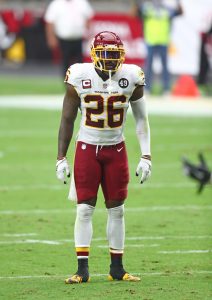 Washington began the 2020 season with Ioannidis, Settle and Ryan Kerrigan as backups. Known for the four first-round picks leading the unit, that acclaimed D-line brought rare depth as well. Ioannidis, who missed most of the playoff season due to injury, led the 2019 squad in sacks with 8.5. Settle capitalized on Ioannidis’ injury and recorded five sacks in 2020. That season undoubtedly helped him score a two-year, $14MM Bills deal. Ioannidis, who had signed a three-year extension worth $21.75MM Washington extension in 2019, was not happy about the way his D.C. exit went down but received a one-year Carolina offer to rejoin his college coach (Matt Rhule).
Washington began the 2020 season with Ioannidis, Settle and Ryan Kerrigan as backups. Known for the four first-round picks leading the unit, that acclaimed D-line brought rare depth as well. Ioannidis, who missed most of the playoff season due to injury, led the 2019 squad in sacks with 8.5. Settle capitalized on Ioannidis’ injury and recorded five sacks in 2020. That season undoubtedly helped him score a two-year, $14MM Bills deal. Ioannidis, who had signed a three-year extension worth $21.75MM Washington extension in 2019, was not happy about the way his D.C. exit went down but received a one-year Carolina offer to rejoin his college coach (Matt Rhule).
Collins, 28, came back from a 2020 Achilles tear and worked as a linebacker/safety hybrid. The Commanders wanted retain him, just not on a team-high $16.1MM cap number. Washington’s previous front office overpaid for the ex-Giants safety in 2019, with Collins (via a six-year, $84MM deal) becoming the first safety to crack the $14MM-per-year barrier. Collins did well as a first-time free agent, but the Rivera regime bailed halfway into the deal. McCain and Kamren Curl have become the team’s safety tandem. With Scherff and Collins gone, the Commanders cleared some big cap numbers off their payroll. They will be hit with $5MM-plus in dead money next year for the Collins cut, however.
Extensions and restructures:
After Josh Doctson showed he would not live up to Washington’s first-round investment, the team found a safety net in McLaurin. The 2019 third-round pick producing amid this historic stretch of quarterback instability revealed the Bruce Allen regime landed a gem on the way out. It was up to Martin Mayhew and Co. to determine McLaurin’s value, and that determination helped set a key 2022 market.
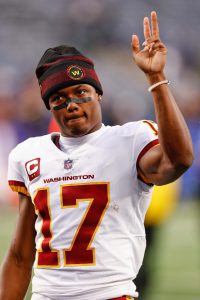 McLaurin, 27 next week, amassed 3,090 yards over his first three seasons. That came in just behind D.K. Metcalf for the most among the 2019 receiver class, and McLaurin’s 67.2 yards per game tops the higher-profile Seahawks weapon. After ditching the Commanders’ OTAs early and holding in at minicamp, McLaurin secured a deal that will both reward him for carrying Washington’s past three aerial attacks and may allow for a late-prime payday.
McLaurin, 27 next week, amassed 3,090 yards over his first three seasons. That came in just behind D.K. Metcalf for the most among the 2019 receiver class, and McLaurin’s 67.2 yards per game tops the higher-profile Seahawks weapon. After ditching the Commanders’ OTAs early and holding in at minicamp, McLaurin secured a deal that will both reward him for carrying Washington’s past three aerial attacks and may allow for a late-prime payday.
The Ohio State alum’s $23.2MM-AAV figure sits ninth among receivers, but it ranked higher at the time of signing. Washington’s extension came after Philadelphia’s $25MM-per-year A.J. Brown deal, but McLaurin’s pact did better to set the market. The Seahawks, 49ers and Steelers gave their top receivers deals in the weeks following McLaurin’s, with Metcalf and Deebo Samuel signing three-year deals that narrowly topped McLaurin’s AAV and Diontae Johnson scoring a lower-priced two-year accord.
With the Commanders’ modern receiving success coming from free agents (Jackson, Garcon, Laveranues Coles) or trade acquisitions (Santana Moss), it has been a while since the team landed a 1,000-yard talent in the draft. The franchise will bank on McLaurin, with a likely quarterback upgrade, anchoring its receiving corps through his age-30 season.
Draft:
Being unable to staff its No. 2 wideout job during McLaurin’s tenure, Washington devoted its top offseason resource in an attempt to do so. The team’s receiver interest became known pre-draft, but rather than reunite McLaurin with ex-Ohio State teammate Chris Olave at No. 11, Mayhew and Co. took a risk by moving down. The Commanders made Dotson the fifth receiver chosen, acquiring third- and fourth-round picks to help the Saints climb five spots.
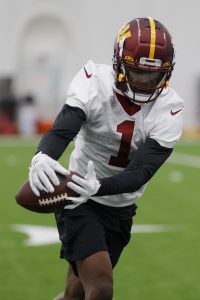 Adding a third former Buckeye receiver to the McLaurin-Samuel stable could have created a Commanders fan hub in central Ohio, but Dotson does give the team an All-Big Ten trio. Following a 1,182-yard, 12-touchdown junior season (one that did not feature bowl-game stats due to early draft prep), Dotson posted a 4.43-second 40 time at the Combine. Dotson is viewed as a quality route runner, which helped a 5-foot-10 prospect rise to the top half of the first round. The Commanders have a $20MM-plus wideout, a $10MM-plus wideout and a first-round pick invested here. The franchise needs to see non-McLaurin production this season.
Adding a third former Buckeye receiver to the McLaurin-Samuel stable could have created a Commanders fan hub in central Ohio, but Dotson does give the team an All-Big Ten trio. Following a 1,182-yard, 12-touchdown junior season (one that did not feature bowl-game stats due to early draft prep), Dotson posted a 4.43-second 40 time at the Combine. Dotson is viewed as a quality route runner, which helped a 5-foot-10 prospect rise to the top half of the first round. The Commanders have a $20MM-plus wideout, a $10MM-plus wideout and a first-round pick invested here. The franchise needs to see non-McLaurin production this season.
Passing on the Ohio State receiver triumvirate, the Commanders did expand their Alabama defensive tackle pipeline. Mathis’ arrival also could point Daron Payne out the door in 2023. Mathis is now under contract through 2025, joining Jonathan Allen in being signed long-term. Rivera said Payne was an extension candidate at the Combine, but nothing emerged on that front. Mathis’ arrival probably had something to do with that.
Washington has big contracts likely on tap for Montez Sweat and Chase Young, with the latter a better bet to cash in, and Allen already signed to a top-five D-tackle deal. The team rebuffed Payne trade inquiries this offseason and still has the option of a 2023 franchise tag. But the team is not expected to have much cap space next year (barely $8MM, though it is obviously early here); a tag would eat into that. Payne may have to land his second contract elsewhere.
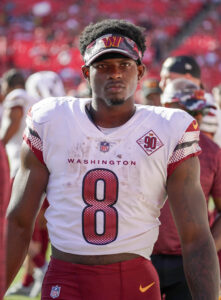 Obtained with one of the picks from the first-round trade-down, Robinson was quickly moving toward the Commanders’ RB1 role. The carjacking incident, during which Robinson sustained two gunshot wounds, changed the team’s plans. But the former Crimson Tide rusher somehow has a chance to return before the midseason point. Robinson (1,343 rushing yards, 14 touchdowns) turned his extra senior year — via the COVID-19 eligibility tweak — into a Day 2 draft landing. Robinson operated as an Alabama backup during his previous four seasons, sparing him some wear-and-tear. Whatever Robinson can provide in 2022 will be a bonus, considering the scary incident that had him hospitalized in August.
Obtained with one of the picks from the first-round trade-down, Robinson was quickly moving toward the Commanders’ RB1 role. The carjacking incident, during which Robinson sustained two gunshot wounds, changed the team’s plans. But the former Crimson Tide rusher somehow has a chance to return before the midseason point. Robinson (1,343 rushing yards, 14 touchdowns) turned his extra senior year — via the COVID-19 eligibility tweak — into a Day 2 draft landing. Robinson operated as an Alabama backup during his previous four seasons, sparing him some wear-and-tear. Whatever Robinson can provide in 2022 will be a bonus, considering the scary incident that had him hospitalized in August.
Before his junior year, Howell was a first-round prospect. He finished his underclassman seasons with a 68-14 TD-INT ratio. But after the Tar Heels’ skill-position group (featuring Javonte Williams, Michael Carter, Dazz Newsome and Commanders 2021 draftee Dyami Brown) departed, Howell’s stock plummeted in 2021. Still, the 6-1 quarterback landed in late-first-round rumors — as part of a class that mostly did not impress NFL evaluators — but waited longer than the Desmond Ridder–Malik Willis–Matt Corral crop. Landing Howell in Round 5 nevertheless represented nice value for the Commanders, who can place him on the developmental track behind Wentz and Heinicke this season.
Other:
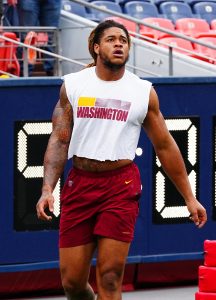 Young’s status perhaps deserves some more attention. The 2020 Defensive Rookie of the Year did not produce on that level last season, tallying just four quarterback hits and 1.5 sacks. It is certainly possible Young was playing hurt, considering the impact he made as a rookie. The ACL tear he suffered in November will lead to him being out of the mix for almost a year.
Young’s status perhaps deserves some more attention. The 2020 Defensive Rookie of the Year did not produce on that level last season, tallying just four quarterback hits and 1.5 sacks. It is certainly possible Young was playing hurt, considering the impact he made as a rookie. The ACL tear he suffered in November will lead to him being out of the mix for almost a year.
Rivera called Young’s ACL tear more severe than Logan Thomas‘. Washington’s starting tight end is questionable for Week 1, returning to regular work despite going down a few weeks after Young did. Young underwent reconstructive surgery that required a graft from his left patellar tendon, and a recent report indicated he will be out longer than the PUP-mandated four-week timetable. This absence could severely limit the Commanders’ pass rush.
Sweat can more than hold his own, but the team has 2020 seventh-rounder James Smith-Williams (2.5 sacks in two seasons) set to be Young’s primary replacement. That will be a tough ask. While the team has Sweat and its talented interior-line trio to fall back on, this D-line may not look formidable again until Young returns.
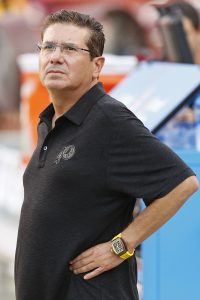 It will be interesting how the Commanders proceed with Sweat. The team’s No. 2 pass rusher is ahead of its No. 1 for an extension, timeline-wise. Saving a big 2024 payment for Young could complicate a 2023 deal with Sweat. The Raiders and Titans have two edges making north of $16MM per year, but with the salary cap’s climb restored this year, Sweat will likely be aiming higher. Only one team — the Chargers — has two edge defenders earning north of $20MM annually, but the Bolts are not responsible for the guarantees on Mack’s deal. The Bears paid those. By operating as the Commanders’ lead rusher for a chunk of this season, Sweat (21 career sacks) can raise his value ahead of contract talks.
It will be interesting how the Commanders proceed with Sweat. The team’s No. 2 pass rusher is ahead of its No. 1 for an extension, timeline-wise. Saving a big 2024 payment for Young could complicate a 2023 deal with Sweat. The Raiders and Titans have two edges making north of $16MM per year, but with the salary cap’s climb restored this year, Sweat will likely be aiming higher. Only one team — the Chargers — has two edge defenders earning north of $20MM annually, but the Bolts are not responsible for the guarantees on Mack’s deal. The Bears paid those. By operating as the Commanders’ lead rusher for a chunk of this season, Sweat (21 career sacks) can raise his value ahead of contract talks.
Even as well-regarded staffers like Rivera, Mayhew and team president Jason Wright are leading the team now, Snyder’s presence still overshadows his franchise’s football matters. Early in his third decade in charge, Snyder has become one of the least popular owners in American sports history. His 2021 offseason, which featured a $10MM fine and de facto suspension after an NFL investigation into sexual harassment allegations from 15 ex-team employees, preceded a rockier 2022. The NFL is believed to have nixed the planned written report associated with the Washington investigation.
Snyder, 57, has been in Congress’ crosshairs since late last year. The embattled owner refused to appear before the Oversight Committee alongside Roger Goodell in June. Although Snyder did later testify, he refused to do so under oath, allowing the evasion of certain questions. It does not sound like Snyder is on the verge of being voted out by his fellow owners, but his constant controversies have tripped alarms among the ranks. Washington has not made consecutive playoff berths under Snyder and has just two 10-win seasons this century.
Top 10 cap charges for 2022:
- Carson Wentz, QB: $28.3MM
- William Jackson, CB: $13.81MM
- Curtis Samuel, WR: $12.63MM
- Kendall Fuller, CB: $11.13MM
- Chase Roullier, C: $9.88MM
- Jonathan Allen, DT: $9.5MM
- Chase Young, DE: $9.43MM
- Daron Payne, DT: $8.53MM
- Charles Leno, T: $8.5MM
- Terry McLaurin, WR: $7.33MM
From 2020-21, Washington’s defense fell from third to 27th in DVOA. Young’s absence undoubtedly factored into that freefall, but the team paid up for its starting corners (Jackson and Fuller) and has first-round picks at nearly every front-seven position. The Commanders have no shot to be an NFC factor if Jack Del Rio‘s troops deliver a similar performance.
Rivera is a fixture toward the top of “first coach fired” odds, and a third straight sub-.500 season would mean five such seasons in a row for the former NFC champion HC. Quarterback luck has betrayed the popular coach since Cam Newton‘s injuries started to mount. While the Commanders can escape the Wentz contract free of charge in 2023, would the organization allow Rivera to be around by then if this QB plan fails? If made available next year, however, this job might not be the most popular for aspiring coaches.
By Ben Levine |
at September 9, 2022 5:30 pm
As a competitive team with an older roster, the Buccaneers have seen plenty of turnover in recent years. However, heading into the offseason, the team was facing the biggest departure of all: Tom Brady. The QB’s retirement and subsequent decision to unretire ended up working out for the Buccaneers, but it also highlighted how reliant the organization is on the future Hall of Famer. So, it wasn’t a huge surprise when most of the team’s offseason moves seemed to be an attempt to pacify Brady, especially with Bruce Arians stepping down as head coach in favor of Todd Bowles.
Despite these significant changes (and non-changes), the Buccaneers were able to maintain continuity this offseason, and that should set them up for another deep postseason run in 2022.
Trades:
The Buccaneers have welcomed in a number of former Patriots players since Tom Brady first joined Tampa Bay. This year, they acquired the QB’s former right guard in Shaq Mason for a fifth-round pick. This was a low price to pay for a lineman with Mason’s experience, especially a lineman who Brady trusts. Mason has missed at least one game in each of the past four seasons, but he’s been plenty productive when he’s on the field. Pro Football Focus ranked Mason fourth among 82 qualifying guards in 2021, the sixth-straight season he’s finished with a top-1o score. Mason will lead a new-look guard corps in 2022.
Notable signings:
- Russell Gage, WR. Three years, $30MM.
- Akiem Hicks, DL. One year, $10MM.
- Fred Johnson, G. One year, $1MM.
- Julio Jones, WR. One year, $6MM.
- Keanu Neal, S. One year, $1.18MM.
- Kyle Rudolph, TE. One year, $2MM.
- Logan Ryan, CB. One year, $1.12MM.
Tom Brady has never had an issue attracting wide receivers to his squad, and that was certainly the case this past offseason. The Buccaneers first stole a receiver from a division foe when they inked former Falcons wideout Russell Gage to a three-year deal. The 26-year-old has finished each of the past two seasons with 700 receiving yards, and he was expected to slide in third on the depth chart behind Mike Evans and Chris Godwin.
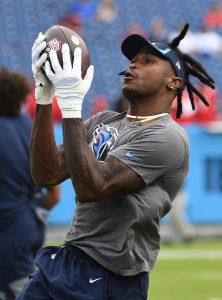 Later in the offseason, the Buccaneers managed to add another former Falcons wideout in Julio Jones. The former All-Pro receiver hasn’t compiled more than 1,000 yards since 2019, and his numbers dropped off during his only season in Tennessee in 2021, as the veteran finished with career-lows across the board (31 receptions, 434 yards, one touchdown). Still, his track record should give him the nod on the depth chart ahead of Gage. Either way, when considering Godwin’s ongoing recovery from his ACL tear, it’s clear why the organization wasn’t going to deny too much depth at the position.
Later in the offseason, the Buccaneers managed to add another former Falcons wideout in Julio Jones. The former All-Pro receiver hasn’t compiled more than 1,000 yards since 2019, and his numbers dropped off during his only season in Tennessee in 2021, as the veteran finished with career-lows across the board (31 receptions, 434 yards, one touchdown). Still, his track record should give him the nod on the depth chart ahead of Gage. Either way, when considering Godwin’s ongoing recovery from his ACL tear, it’s clear why the organization wasn’t going to deny too much depth at the position.
Elsewhere on offense, the Buccaneers needed to find at least one body to replace the departed Rob Gronkowski (retirement) and O.J. Howard (left in free agency). In came Kyle Rudolph, who should be able to soak up some of those offensive snaps. The veteran had a three-year stretch between 2016 and 2018 when he averaged more than 660 receiving yards per season, but since that time, he’s seen that number drop to 319 yards per year. Of course, the 32-year-old tight end won’t be expected to pick up a ton of yardage, and he’ll provide Brady with another big TE target (in addition to Cameron Brate) to throw to in the end zone. On the offensive line, Fred Johnson has only started eight of his 23 games, but his ability to play both tackle and guard earned him a spot on Tampa Bay’s 53-man roster.
Defensively, the team did some work to add to their defensive line when they inked Akiem Hicks to a one-year pact. The former Pro Bowler has battled injuries recently, missing 20 games over the past three seasons. His versatility makes him an asset on any defensive line, and he’ll likely see some time at defensive tackle in 2022. Regardless of his role, he’s good for at least a handful of sacks. Otherwise, the team added a few veterans to their secondary, with both Keanu Neal and Logan Ryan expected to play depth roles in 2022. After starting 14 games for the Falcons in 2020, Neal started only five of his 15 games in 2021, but he still finished the campaign with 72 tackles. Ryan, who made a name for himself as a cornerback with the Patriots, has transitioned into more of a safety role in recent years, including a 2021 campaign where he finished with a career-high 117 tackles in 15 starts for the Giants.
Notable losses:
- Antonio Brown, WR
- Alex Cappa, G
- Pierre Desir, CB
- Rob Gronkowski, TE (retired)
- O.J. Howard, TE
- Ronald Jones, RB
- Travis Jonsen, WR (waived)
- Ali Marpet, G (retired)
- Jason Pierre-Paul, LB
- Bradley Pinion, P (released)
- Ndamukong Suh, DT
- Jordan Whitehead, S
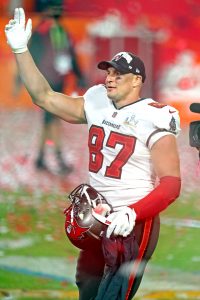 Whlle Tom Brady and his top two receivers will be back in 2022, the offense will look a bit different. The biggest loss comes at tight end, as future Hall of Famer Rob Gronkowski decided to call it a career. After returning from a brief retirement to appear in 16 games for the Bucs in 2020, Gronk once again dealt with injuries in 2021. Despite sitting out five games, the tight end still managed to finish the season with 802 receiving yards, his highest total since the 2017 season. Gronk also continued being a force in the end zone, hauling in six touchdowns. While O.J. Howard never really clicked with Brady, he’s another notable loss at the position, and the Buccaneers will be hoping some newcomers (primarily veteran Kyle Rudolph and rookie Cade Otton) can pick up some of the slack in 2022.
Whlle Tom Brady and his top two receivers will be back in 2022, the offense will look a bit different. The biggest loss comes at tight end, as future Hall of Famer Rob Gronkowski decided to call it a career. After returning from a brief retirement to appear in 16 games for the Bucs in 2020, Gronk once again dealt with injuries in 2021. Despite sitting out five games, the tight end still managed to finish the season with 802 receiving yards, his highest total since the 2017 season. Gronk also continued being a force in the end zone, hauling in six touchdowns. While O.J. Howard never really clicked with Brady, he’s another notable loss at the position, and the Buccaneers will be hoping some newcomers (primarily veteran Kyle Rudolph and rookie Cade Otton) can pick up some of the slack in 2022.
Antonio Brown‘s tenure with the Buccaneers truly came to an end during his sideline outburst in Week 17. The wideout was officially released in early January. Brown was productive in 15 games across two seasons with the Buccaneers, collecting 1,208 yards and and eight touchdowns. Tampa Bay already added Russell Gage and Julio Jones to their WRs room, and the duo should be able to replicate Brown’s production without the headache. Another notable offensive loss was in Ronald Jones, who started 25 games for Tampa Bay over the past three years. After leading the Buccaneers with 978 rushing yards and seven touchdowns in 2020, Jones found himself behind Leonard Fournette on the depth chart in 2022. The Bucs will now pair Fournette with rookie third-round pick Rachaad White.
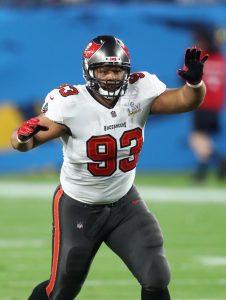 On the offensive line, Brady will have to get used to a pair of new starting offensive guards. Despite earning his first career Pro Bowl nod in 2021, Ali Marpet decided to retire after seven NFL seasons. The offensive guard started each of his 16 games in 2021, with Pro Football Focus grading him as the NFL’s seventh-best guard. Alex Cappa, who started 17 games last season, was 19th on that same list, and that’s a big reason why the former third-round pick was able to secure a $35MM deal from the Bengals. Trade acquisition Shaq Mason will slide into one of the starting guard spots, with rookie second-round pick Luke Goedeke also getting a nod.
On the offensive line, Brady will have to get used to a pair of new starting offensive guards. Despite earning his first career Pro Bowl nod in 2021, Ali Marpet decided to retire after seven NFL seasons. The offensive guard started each of his 16 games in 2021, with Pro Football Focus grading him as the NFL’s seventh-best guard. Alex Cappa, who started 17 games last season, was 19th on that same list, and that’s a big reason why the former third-round pick was able to secure a $35MM deal from the Bengals. Trade acquisition Shaq Mason will slide into one of the starting guard spots, with rookie second-round pick Luke Goedeke also getting a nod.
Defensively, the Buccaneers chose not to re-sign a pair of big-name players. Ndamukong Suh hasn’t missed a start for Tampa Bay over the past three seasons, collecting 14.5 sacks in 49 games (including six sacks in each of the past two seasons). However, he already saw a reduced role in 2021, with the defensive lineman getting into a career-low 63 percent of his team’s defensive snaps. He also didn’t earn the highest praise from Pro Football Focus, with the site ranking him 73rd among 108 qualifying interior defenders. It’s a similar story with JPP. Jason Pierre-Paul started each of his 12 games in 2021, but after averaging more than 10 sacks per season through his first three years with the organization, he was limited to only 2.5 last year. Both veterans remain free agents.
Jordan Whitehead was a fourth-round pick by the Buccaneers in 2018, and he’s started 55 of his 59 appearances since entering the NFL. That includes a 2021 campaign where he started 14 games while compiling 73 tackles, eight passes defended, and a pair of interceptions. He also graded as PFF’s 27th-best safety (among 92 qualifiers), earning him a two-year contract from the Jets.
Re-signed:
- Giovani Bernard, RB
- Carlton Davis, CB
- Leonard Fournette, RB
- Blaine Gabbert, QB
- William Gholston, DE
- Chris Godwin, WR
- Ryan Jensen, C
- Breshad Perriman, WR
- Aaron Stinnie, G
- Josh Wells, OT
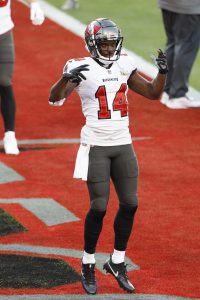 While the Buccaneers let a lot of players walk, they also made sure to maintain some continuity on both sides of the ball. The most notable re-signing was wideout Chris Godwin, who has transformed into one of the NFL’s most consistent receivers and one of Tom Brady‘s preferred targets. Despite an ACL tear that ended his 2021 season prematurely (and could end up lingering into the 2022 campaign), the organization still felt comfortable giving him a three-year deal worth $60MM, including $40MM guaranteed. Assuming Godwin fully recovers from his injury, that contract could prove to be a bargain in later years.
While the Buccaneers let a lot of players walk, they also made sure to maintain some continuity on both sides of the ball. The most notable re-signing was wideout Chris Godwin, who has transformed into one of the NFL’s most consistent receivers and one of Tom Brady‘s preferred targets. Despite an ACL tear that ended his 2021 season prematurely (and could end up lingering into the 2022 campaign), the organization still felt comfortable giving him a three-year deal worth $60MM, including $40MM guaranteed. Assuming Godwin fully recovers from his injury, that contract could prove to be a bargain in later years.
The Buccaneers also re-signed Leonard Fournette to a three-year, $21MM deal. This was a significant investment after the RB was cast off in Jacksonville, but following a so-so first season in Tampa, Fournette came into his own in 2021. The running back finished last year with 1,266 yards from scrimmage and 10 touchdowns, and he’ll continue to be an important part of Tampa Bay’s offense for the foreseeable future.
Elsewhere on offense, the team re-signed some depth pieces. Breshad Perriman‘s return to Tampa Bay during the 2021 season saw him finish with only 167 receiving yards in six games, and the veteran will provide the team with an experienced end-of-the-depth-chart piece. The same goes for veteran running back Giovani Bernard. The former Bengals pass-catcher finished his first season in Tampa Bay with only 181 offensive yards, but he’ll stick around for the time being as some extra depth. Blaine Gabbert is back for another season as Brady’s backup, with the veteran having attempted 27 passes over the past two seasons.
Read more
Ryan Jensen hasn’t missed a start for Tampa Bay since joining the organization in 2018. He inked a three-year, $39MM deal with the Buccaneers back in March, but his 2022 season was derailed by a knee injury during training camp. While the injury was described as severe, the Buccaneers still carried him to their 53-man roster before placing him on IR, keeping the door open to a potential return. For the time being, 2021 third-round pick Robert Hainsey will fill in at center. Josh Wells has seen time in 53 games over the past three seasons, and he’ll continue to serve as Tampa Bay’s primary swing tackle in 2022. Aaron Stinnie had a chance to make the roster as a backup guard, but a torn ACL will sideline him for the 2022 season.
On defense, the team brought back a pair of important pieces. Carlton Davis has started 50 of his 51 games with Tampa since being selected in the second round of the 2018 draft, although he’s missed 14 games in those four seasons. He was limited to 10 games in 2021, leading to only 39 tackles, one interception, and 11 passes defended. Even with the limited snaps, he still ranked 21st among 116 qualifiers at the position, per Pro Football Focus. The 25-year-old was brought back on a three-year, $45MM pact. William Gholston has served in a situational role for the Buccaneers, with the nine-year veteran starting 78 of his 136 career games. He started 10 of his 17 appearances in 2021, finishing with a career-high 4.5 sacks.
Draft picks:
2-33: Logan Hall, DL (Houston)
2-57: Luke Goedeke, OL (Central Michigan)
3-91: Rachaad White, RB (Arizona State)
4-106: Cade Otton, TE (Washington)
4-133: Jake Camarda, P (Georgia)
5-157: Zyon McCollum, CB (Sam Houston State)
6-218: Ko Kieft, TE (Minnesota)
7-248: Andre Anthony, DE (LSU)
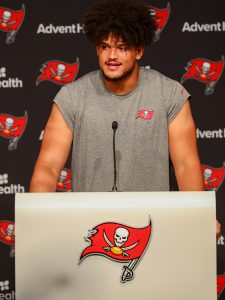 The Buccaneers ended up dealing their first-round pick for a handful of selections, including the first pick of the second round. With that selection, the organization decided to add Houston standout Logan Hall. The defensive end had a breakout campaign in 2021, finishing with six sacks and 13 tackles for loss. The return of William Gholston means the organization won’t need to lean on their top rookie, but Gholston’s age means Hall should find himself in the lineup sooner than later.
The Buccaneers ended up dealing their first-round pick for a handful of selections, including the first pick of the second round. With that selection, the organization decided to add Houston standout Logan Hall. The defensive end had a breakout campaign in 2021, finishing with six sacks and 13 tackles for loss. The return of William Gholston means the organization won’t need to lean on their top rookie, but Gholston’s age means Hall should find himself in the lineup sooner than later.
The team will be leaning on their other second-round pick. Central Michigan offensive lineman Luke Goedeke wasn’t considered a first-round prospect, but he was certainly the best of the rest, making him a solid pick for Tampa Bay at No. 57. Despite mostly playing offensive tackle in college, Goedeke will start his NFL career as an offensive guard, where he’s expected to start opposite Shaq Mason.
With their next two selections, the Buccaneers added a pair of skill players who could end up seeing roles in 2022. Rachaad White had 1,462 yards from scrimmage for Arizona State in 2021, and that performance made him the fourth RB off the board in the draft. Leonard Fournette is the only RB standing in his way on Tampa’s depth chart, and the rookie should at least see a minor role in 2022. Cade Otton was never an offensive powerhouse during his four seasons at Washington, hauling in 91 catches for 1,026 yards and nine touchdowns in 31 games. At 6-foot-5, 250 pounds, Otton has the size to play TE in the NFL, and if Cameron Brate or Kyle Rudolph struggle, the rookie could be inserted into the offense. Sixth-round tight end Ko Kieft also made the 53-man roster, and the rookie is clearly in the team’s future plans at the position.
Jake Camarda was the second punter off the board following a 2021 campaign where he earned a CFP national championship and his second-straight first-team All-SEC nod. The rookie will be Tampa Bay’s starting punter heading into the season. Zyon McCollum had 50 tackles and three interceptions during his final season at Sam Houston State, and the rookie will likely spend most of his rookie season on special teams. Seventh-round defensive end Andre Anthony was cut at the end of the preseason.
Other:
Tom Brady dealt with retirement rumblings long before he was on the Buccaneers, but the future Hall of Fame QB definitively announced his retirement shortly after the Buccaneers were eliminated from the postseason. 40 days later, he announced he was reversing his decision and returning for the 2022 campaign, helping the organization temporarily avoid the major hole they were facing at QB.
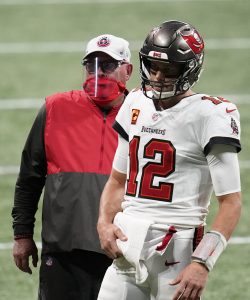 His sudden about-face was surprising, and plenty of pundits are still theorizing about Brady’s reasoning. Following the bombshell report surrounding the Dolphins’ tampering scandal with Brady and former Saints head coach Sean Payton, it seemed like the QB was still keeping an open mind when it came to potentially playing elsewhere. Further, there were whispers that Brady had grown wary of head coach Bruce Arians and was pushing for a change on Tampa Bay’s sideline. We’ll probably never know if Brady’s “retirement” was an attempt to strong-arm the organization into a trade or a coaching change, but it was certainly interesting when Arians ended up stepping down as head coach.
His sudden about-face was surprising, and plenty of pundits are still theorizing about Brady’s reasoning. Following the bombshell report surrounding the Dolphins’ tampering scandal with Brady and former Saints head coach Sean Payton, it seemed like the QB was still keeping an open mind when it came to potentially playing elsewhere. Further, there were whispers that Brady had grown wary of head coach Bruce Arians and was pushing for a change on Tampa Bay’s sideline. We’ll probably never know if Brady’s “retirement” was an attempt to strong-arm the organization into a trade or a coaching change, but it was certainly interesting when Arians ended up stepping down as head coach.
For Arians, the coach made it clear that he was prioritizing a clear succession plan for the organization, and he felt it was the right time to hand over the reigns to defensive coordinator Todd Bowles. Bowles struggled during his last head coaching stint, going 24-40 in four seasons with the Jets. However, the Buccaneers will continue to be competitive as long as Brady is on the roster, and Bowles has drawn a lot of recent praise for guiding Tampa Bay’s defense. The continuity should allow the Buccaneers to maintain their winning ways in 2022, and Brady’s opportunity to truly guide the offense (alongside OC Byron Leftwich) should placate the QB.
It was an easy choice for the Buccaneers to pick up Devin White‘s fifth-year option. After earning a second-team All-Pro nod in 2021, the linebacker followed that up with his first career Pro Bowl appearance in 2021. White finished last season with 128 tackles and 3.5 sacks, and he appears to be a primary part of Tampa Bay’s defense for years to come.
Top 10 cap charges for 2022:
- Donovan Smith, LT: $18.4MM
- Lavonte David, LB: $14.78MM
- Tom Brady, QB: $11.89MM
- Mike Evans, WR: $10.3MM
- Devin White, LB: $9.5MM
- Carlton Davis, CB: $8.33MM
- Shaquil Barrett, LB: $7.8MM
- Russell Gage, WR: $5.66MM
- Chris Godwin, WR: $5MM
- Ryan Succop, K: $4.5MM
The Buccaneers are loaded once again, and it wouldn’t shock anybody if Tom Brady and his teammates are holding the Lombardi Trophy at the end of the season. Still, this offseason showcased how fleeting a team’s contender status can be, and Tampa Bay could be facing a long rebuild whenever Brady finally decides to hang up his cleats.
By Sam Robinson |
at September 8, 2022 10:10 pm
The Cowboys followed their third NFC East title in six seasons with an offseason in which mainstays departed. Amari Cooper, La’el Collins and Randy Gregory‘s exits then preceded Tyron Smith suffering a second severe injury in three years. Although Dallas’ 2021 defensive resurgence should provide a reasonable safety net to protect against the changes that have unfolded on offense, this rather popular team is facing some questions as it attempts to become the first back-to-back NFC East champion since the early-aughts Eagles.
Trades:
- Dealt WR Amari Cooper and 2022 sixth-round pick to Browns for 2022 fifth- and sixth-rounders
This trade did not age well, but the Cowboys cannot be completely faulted for failing to predict one of the biggest positional-market booms in many years was imminent. Cooper carried a receiver-high $21MM cap hold in 2021, and the Cowboys constructed his 2020 contract to allow for post-Year 2 flexibility. Dallas took the de facto opt-out. That both generated a low-level return and, thanks to injuries the team was already battling and later encountered, Cooper going to Cleveland in a pick-swap deal began this Dallas offseason on a low note.
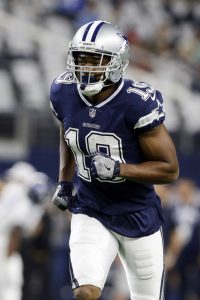 The Cowboys have a few lucrative extensions on their books — most notably the deals doled out to Dak Prescott and Ezekiel Elliott — and have needed to get out on certain players mid-prime. Byron Jones left in 2020; the team turned out to be wise not to beat out the Dolphins for him. Cooper is not positioned for immediate success, with Deshaun Watson‘s suspension leaving the Browns with their Jacoby Brissett backup plan for 11 games. But, as Michael Gallup‘s ACL rehab and James Washington‘s foot fracture leave the Cowboys without much experience at the position, Cooper’s $20MM salary would not appear too troublesome now.
The Cowboys have a few lucrative extensions on their books — most notably the deals doled out to Dak Prescott and Ezekiel Elliott — and have needed to get out on certain players mid-prime. Byron Jones left in 2020; the team turned out to be wise not to beat out the Dolphins for him. Cooper is not positioned for immediate success, with Deshaun Watson‘s suspension leaving the Browns with their Jacoby Brissett backup plan for 11 games. But, as Michael Gallup‘s ACL rehab and James Washington‘s foot fracture leave the Cowboys without much experience at the position, Cooper’s $20MM salary would not appear too troublesome now.
Cooper’s per-year salary has dropped from a top-five receiver figure — at the time of the trade — into a tie for 12th. With three nonguaranteed years left on the deal, the Cowboys had the Pro Bowl target locked into that price for the rest of his prime. Cooper’s route-running chops and big-play ability resurrected a fast-fading 2018 Cowboys season — which produced the team’s only Dak-era playoff win — and the former top-five draftee undoubtedly helped CeeDee Lamb‘s progress.
Before a modest trade sweepstakes ensued days ahead of the Davante Adams trade setting the receiver market ablaze, the Cowboys considered cutting the eighth-year veteran. But the team opening with the Buccaneers and Bengals may highlight the void the Cooper trade and Gallup injury created. And the light trade return — a shell of the hauls the Packers, Chiefs, Titans and Ravens received in their deals for admittedly better or younger performers — does not help matters. The inconsistency Cooper displayed had him well off the first tier at his position, which surely factored into the Cowboys’ decision to move on. But the five-time 1,000-yard wideout aided Prescott’s development as well. Even coming off a down 2021, Cooper will likely be missed this season.
Free agency additions:
- Anthony Barr, LB. One year, $2MM. $1.75MM guaranteed.
- James Washington, WR. One year, $1.19MM. $1.05MM guaranteed.
- Dante Fowler, DE. One year, $3MM. $1MM guaranteed.
- KaVontae Turpin, KR/PR. One year, $2.56MM.
- Brett Maher, K. Signed to practice squad on 8/31
- Jason Peters, T. Signed to practice squad on 9/5
Excepting the safety positions, Dallas should trot out 20 homegrown starters against the Bucs. UFAs filled in some gaps this year, however. The two most pivotal additions are currently on the team’s practice squad.
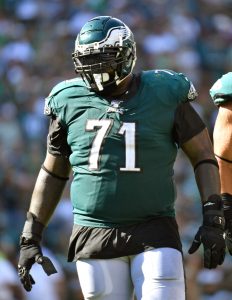 Peters’ P-squad status notwithstanding, this marks by far Dallas’ most important free agency add. Although the team is giving the likely Hall of Famer a ramp-up period, it will mark a bit of a strange turn if/when first-rounder Tyler Smith slides to left tackle for a one- or two-game period and then moves back to a position at which he has far less experience. Dallas drafted its younger Smith blocker as its left tackle of the future, and while the Tulsa product starting at two positions in his first NFL month will be odd, Peters’ presence should make that early instability worthwhile.
Peters’ P-squad status notwithstanding, this marks by far Dallas’ most important free agency add. Although the team is giving the likely Hall of Famer a ramp-up period, it will mark a bit of a strange turn if/when first-rounder Tyler Smith slides to left tackle for a one- or two-game period and then moves back to a position at which he has far less experience. Dallas drafted its younger Smith blocker as its left tackle of the future, and while the Tulsa product starting at two positions in his first NFL month will be odd, Peters’ presence should make that early instability worthwhile.
The Tyron Smith avulsion fracture dealt the Cowboys a severe blow, but it is not like the team should have expected an extended stretch of good health from the future Hall of Famer. Tyron Smith missed 14 games two seasons ago and has missed 32 in total since 2016. The other current Cowboy tackle ticketed for Canton remains a top-shelf blindsider when healthy, as his five Pro Bowls during that injury-affected stretch show, but the Cowboys have needed insurance here for years. Peters, 40, will provide it for now. But the longtime Eagle has also missed 20 regular-season games since 2017. Also when factoring in Tyler Smith’s status, the left side of Dallas’ offensive line could be touch and go this season.
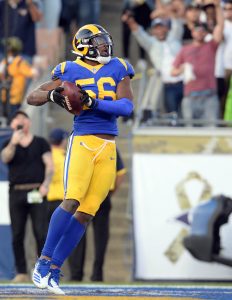 Tyron’s injury will give Peters a chance to become the fourth tackle to play an age-40 season, following Hall of Famer Jackie Slater, 20-year veteran Ray Brown (1985-2004) and Andrew Whitworth. Peters (nine Pro Bowls, two first-team All-Pro nods) performing what could be his final NFL assignment well — for perhaps the NFL’s highest-profile team — will be an obvious boon for the 19th-year veteran’s chances at a first-ballot induction.
Tyron’s injury will give Peters a chance to become the fourth tackle to play an age-40 season, following Hall of Famer Jackie Slater, 20-year veteran Ray Brown (1985-2004) and Andrew Whitworth. Peters (nine Pro Bowls, two first-team All-Pro nods) performing what could be his final NFL assignment well — for perhaps the NFL’s highest-profile team — will be an obvious boon for the 19th-year veteran’s chances at a first-ballot induction.
Peters bounced back from his eight-game 2020 with an anonymous 15-game run in Chicago, as the Ryan Pace–Matt Nagy regime’s wheels were coming off. Pro Football Focus graded Peters as a top-25 tackle last season. The Cowboys will pine for one more season on that level, as it would keep their hopes of bringing Tyler Smith along slowly. Connor McGovern, who was holding his own against the younger Smith in this summer’s left guard competition, represents a nice swingman once Peters takes over on the left side.
The Randy Gregory snafu and Von Miller derby ending in Buffalo led the Cowboys to Fowler, whose value had cratered after an uninspiring two-year Atlanta stay. Despite this being Year 8 for the former top-five pick, Fowler only turned 28 last month. He delivered intermittent production with the Jaguars and Rams, peaking with an 11.5-sack year alongside Aaron Donald — an arrangement that has catalyzed other pass rushers, including Miller — in 2019. The Falcons gave Fowler a three-year, $48MM deal in 2020. The edge rusher’s two-year output: 7.5 sacks, 16 QB hits. The Cowboys planning a rotational role for the former Dan Quinn-era Falcons pickup is more sensible than starting him, and he is still young enough to bounce back. This could be a make-or-break season for those prospects, however.
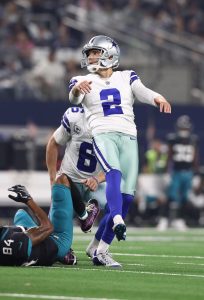 While the loose connections to Bobby Wagner generated interest, the Cowboys were not a serious contender for the future first-ballot Hall of Famer. Barr and Micah Parsons on the same defense nevertheless intrigues, though obviously not as much as it would have if Barr’s 2010s version were here. A college edge rusher, Barr transitioned to a 4-3 outside linebacker role under current Dallas assistant George Edwards in Minnesota. Parsons’ time as a rusher could open the door for more Barr looks on the second level.
While the loose connections to Bobby Wagner generated interest, the Cowboys were not a serious contender for the future first-ballot Hall of Famer. Barr and Micah Parsons on the same defense nevertheless intrigues, though obviously not as much as it would have if Barr’s 2010s version were here. A college edge rusher, Barr transitioned to a 4-3 outside linebacker role under current Dallas assistant George Edwards in Minnesota. Parsons’ time as a rusher could open the door for more Barr looks on the second level.
On a team that rosters injury-prone Leighton Vander Esch and has rookie Damone Clark potentially out for the season due to a pre-existing injury, Barr, 30, may move into position to be a regular — even as not much free agency buzz surrounding him until July. Despite not being on the level he was during his prime, the four-time Pro Bowler still graded as a top-30 PFF linebacker in 2021.
Camp struggles exposed the Cowboys’ low-key Greg Zuerlein replacement plan, and Maher — following the exists of Lirim Hajrullahu and rookie UDFA Jonathan Garibay — is back. The multi-stint CFLer remains tied to that eye-popping 60-yard field goal record, and until Justin Tucker kicks a third from that range, Maher is the only player to make three 60-plus-yarders. Of course, Dallas cut Maher late during a 2019 season in which he made a franchise-record 63-yarder but connected on fewer than 67% of his tries. After a 16-for-18 Saints showing as part of their 2021 kicker carousel, the 32-year-old specialist has a second shot in Dallas.
Re-signings:
- Michael Gallup, WR. Five years, $57.5MM. $23MM guaranteed.
- Dorance Armstrong, DE. Two years, $12MM. $6MM guaranteed.
- Jayron Kearse, S. Two years, $10MM. $5MM guaranteed.
- Bryan Anger, P. Three years, $9MM. $3.8MM guaranteed.
- Malik Hooker, S. Two years, $7MM. $2MM guaranteed.
- Leighton Vander Esch, LB. One year, $2MM. $1.75MM guaranteed.
- Noah Brown, WR. One year, $1.19MM. $153K guaranteed.
- Jake McQuaide. One year, $1.12MM.
Gallup, 26, is two years younger than Cooper. Choosing the sidekick over the more accomplished lead actor — at a near-$9MM-per-year discount — makes sense for the Cowboys. They just better be right about Gallup’s trajectory. With Cooper gone, Gallup has a clear runway to be Lamb’s wingman. The TCU product combined for 1,950 yards from 2019-20, giving the Cowboys a good indication of his capabilities. Injuries threw Gallup off track last year but also kept him within Dallas’ price range.
Read more
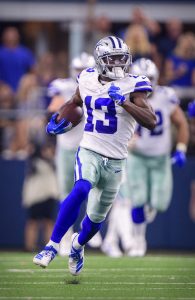 Contract-wise, this could be a steal. It satisfies the Cowboys’ desire for longer-term deals and, if Gallup returns to his pre-ACL-tear form, will age well enough this could be a pact that is one day talked about like Darren Waller‘s wildly team-friendly Raiders contract currently is. The former third-round pick could have priced himself out of the Cowboys’ range by staying healthy during his contract year, but his foot and knee maladies prevented that. Gallup tying himself to Dallas through 2026, rather than go with a shorter-term accord and attempt to cash in again as the salary cap rises, could limit his career earnings. Even as Gallup — after 2022’s receiver-market earthquake — sits as the league’s 29th-highest-paid receiver, collecting $23MM after a two-injury season should cushion the blow of potentially outplaying this contract.
Contract-wise, this could be a steal. It satisfies the Cowboys’ desire for longer-term deals and, if Gallup returns to his pre-ACL-tear form, will age well enough this could be a pact that is one day talked about like Darren Waller‘s wildly team-friendly Raiders contract currently is. The former third-round pick could have priced himself out of the Cowboys’ range by staying healthy during his contract year, but his foot and knee maladies prevented that. Gallup tying himself to Dallas through 2026, rather than go with a shorter-term accord and attempt to cash in again as the salary cap rises, could limit his career earnings. Even as Gallup — after 2022’s receiver-market earthquake — sits as the league’s 29th-highest-paid receiver, collecting $23MM after a two-injury season should cushion the blow of potentially outplaying this contract.
Although the Cowboys did not plan it this way, their defensive end strategy resembled the Gallup-over-Cooper receiver call. Gregory’s last-minute Denver defection left an edge void the team opted to fill collectively. Armstrong flashed as a pass rusher in his contract year (five sacks and 12 QB hits, both of which topped his previous three years combined). He will join Fowler and second-rounder Sam Williams in complementing DeMarcus Lawrence.
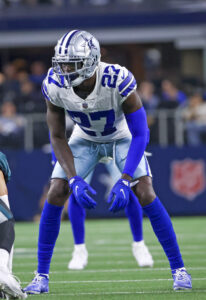 Waived by the Lions and ending up on the Ravens’ practice squad in 2020, Kearse took a low-cost Cowboys contract (one year, $2.75MM) and bettered his value. PFF slotted the former seventh-round Vikings pick as a top-15 safety, giving the Cowboys something to work with on a back line that had cycled through some middling-at-best personnel in recent years. Kearse made 101 tackles (nine for loss) and added two INTs and 10 passes defensed in 2021. The Jevon Kearse nephew was a key part of the Cowboys going from allowing a franchise-record 473 points in 2020 to ranking second in 2021 defensive DVOA.
Waived by the Lions and ending up on the Ravens’ practice squad in 2020, Kearse took a low-cost Cowboys contract (one year, $2.75MM) and bettered his value. PFF slotted the former seventh-round Vikings pick as a top-15 safety, giving the Cowboys something to work with on a back line that had cycled through some middling-at-best personnel in recent years. Kearse made 101 tackles (nine for loss) and added two INTs and 10 passes defensed in 2021. The Jevon Kearse nephew was a key part of the Cowboys going from allowing a franchise-record 473 points in 2020 to ranking second in 2021 defensive DVOA.
With Keanu Neal and Damontae Kazee on last year’s team, Hooker was less impactful compared to Kearse. But the former first-round pick — a top-30 PFF safety, albeit on 474 snaps — will be asked to do more this season. The ex-Ohio State star, who signed with the Cowboys just before their 2021 training camp, is still just 26. September will mark the two-year anniversary of the Achilles tear that ended Hooker’s Indianapolis run. A future in which the former first-round pick raises his market considerably this season exists, should Quinn harness a healthier Hooker’s talent.
Vander Esch began his career on a course similar to 2018 classmates Shaquille Leonard and Derwin James, joining each as a rookie-year Pro Bowler. Instead of joining that duo with a market-topping extension, Vander Esch saw injuries crush his value. This $2MM deal, with $1MM in incentives, represents a massive disappointment from where Vander Esch was earlier in his career. LVE’s cervical spinal stenosis condition preceded a 2019 neck injury that required surgery, and the young linebacker broke his collarbone in 2020. These issues complicated the former 140-tackle standout’s path. Vander Esch played 17 games in 2021 but logged a career-low 58% defensive snap rate. His career path is in flux.
Notable losses:
- Maurice Canady, CB
- La’el Collins, T (designated as post-June 1 cut)
- Jonathan Garibay, K (waived)
- Randy Gregory, DE
- Lirim Hajrullahu, K (waived)
- Blake Jarwin, TE (released)
- Damontae Kazee, S
- Keanu Neal, LB/S
- Ben DiNucci, QB (waived)
- Ty Nsekhe, T
- Jeremy Sprinkle, TE (released via injury settlement)
- Malik Turner, WR
- Brent Urban, DL
- Connor Williams, G
- Cedrick Wilson Jr., WR
- Greg Zuerlein, K (released)
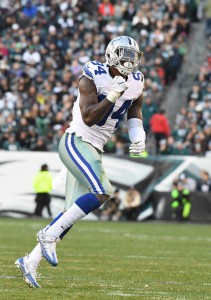 The Cowboys sticking by Gregory for nearly seven years, amid four suspensions, and observing their plan for the rest of the ex-second-rounder’s prime go awry so publicly was certainly an early offseason blow. Parsons represents envied rush assistance, as he brought frequent havoc and tantalizing potential as a part-time edge defender, but Gregory showed Pro Bowl-caliber form for a while last season. Losing him and seeing the Bills swoop in for Von Miller led the Cowboys to go with a non-star-studded path opposite Lawrence.
The Cowboys sticking by Gregory for nearly seven years, amid four suspensions, and observing their plan for the rest of the ex-second-rounder’s prime go awry so publicly was certainly an early offseason blow. Parsons represents envied rush assistance, as he brought frequent havoc and tantalizing potential as a part-time edge defender, but Gregory showed Pro Bowl-caliber form for a while last season. Losing him and seeing the Bills swoop in for Von Miller led the Cowboys to go with a non-star-studded path opposite Lawrence.
Gregory objected to language that could have seen his guarantees void in the event of even a mere fine. Gregory’s agent described that clause as an extreme rarity, and the veteran edge rusher cursed the Cowboys — whom he felt inserted the language late in the process — on his way out. Cowboys pushback indicated the team has this clause in other non-Prescott veterans’ deals, but after Gregory said he would stay if Dallas matched Denver’s five-year, $70MM offer, the damage was beyond done.
The 2011 CBA’s stricter substance-abuse policy nearly led Gregory out of the league. The extended hiatuses (a staggering 52 suspension-induced absences from 2016-20) also limited Gregory’s wear-and-tear, making the 29-year-old’s status on a $14MM-per-year deal valuable. A calf injury and a COVID-19 contraction forced Gregory to miss five more games in 2021, and two offseason surgeries followed. But the Cowboys were willing to make this bet to fortify their other D-end spot after Gregory notched six sacks, 17 QB hits and three forced fumbles last season. When the team attempted to pivot to Miller — a Dallas-area native who wanted to join his hometown team — a lowball offer derailed those talks.
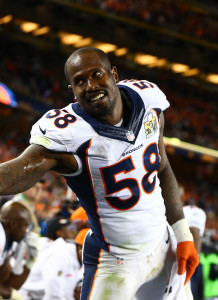 The likely first-ballot Hall of Famer said the Bills’ offer of three guaranteed years eclipsed what the Rams and Cowboys proposed. The Cowboys simply sent their Gregory terms his way, per Miller. The Rams also outflanked Dallas here, offering the former Super Bowl MVP a contract that bettered the three-year AAV on the Bills’ proposal. Miller, 33, said he would have taken less to sign with the Cowboys, “but not that much less.”
The likely first-ballot Hall of Famer said the Bills’ offer of three guaranteed years eclipsed what the Rams and Cowboys proposed. The Cowboys simply sent their Gregory terms his way, per Miller. The Rams also outflanked Dallas here, offering the former Super Bowl MVP a contract that bettered the three-year AAV on the Bills’ proposal. Miller, 33, said he would have taken less to sign with the Cowboys, “but not that much less.”
Connections to Za’Darius Smith and Jason Pierre-Paul followed, but the Cowboys stood down. They ultimately decided to save money here. This is a cost-controlled defense; Lawrence is currently the only Cowboys defender making more than $6MM on average. Parsons will certainly help the Cowboys’ pass-rushing cause, but the team passing on pairing the Defensive Rookie of the Year’s low-cost deal with a veteran Miller pact — thus creating a lethal Miller-Lawrence-Parsons troika — could be second-guessed for a while.
Terence Steele, who gained extensive experience during a 2020 season in which Collins missed, is stepping in for the talented blocker. The Cowboys did well to sign Collins — a first-round talent who saw a pre-draft controversy cause him to go undrafted — and were also correct in moving him from left guard to right tackle. Collins, 29, became one of the NFL’s best right tackles. The LSU alum had signed a five-year, $50MM extension in 2019, and PFF slotted him as a top-15 tackle in 2019 and ’21. But Collins did miss 21 games from 2020-21. Steele is also a former UDFA, but no extenuating circumstances caused him to drop to that level. The Cowboys are high on Steele, whom PFF rated outside its top 50 in both 2020 and ’21, but they appear to be taking a bit of a risk here.
Draft:
Boldly announcing the Cowboys would not pass up a need to add a prime young talent up front this year, Jerry Jones made good on that via the Smith choice. The draft’s fifth tackle taken, Smith is expected to have the aforementioned guard assignment as an NFL intro — a challenge his first-round contemporaries will not have. The Conference USA product did not play guard in college and struggled with penalties while at his natural position, committing a whopping 12 holding infractions during his final Tulsa season. But a Tyron-to-Tyler transition is expected to take place.
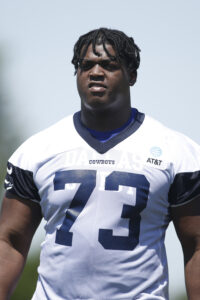 Still attached to the eight-year, $97.6MM extension he signed in 2014 — by far the oldest active NFL contract — Tyron Smith has two seasons remaining on that deal. The Cowboys can get out of the savvy contract for barely $4MM in dead money, in a post-June 1 cut scenario. But given this organization’s draft-and-extend penchant, the team doing another Tyron accord is not hard to envision. Even factoring in the 12th-year blocker’s injuries, he remains an elite player. Prescott and Elliott’s numbers with and without the All-Pro left tackle reflect it.
Still attached to the eight-year, $97.6MM extension he signed in 2014 — by far the oldest active NFL contract — Tyron Smith has two seasons remaining on that deal. The Cowboys can get out of the savvy contract for barely $4MM in dead money, in a post-June 1 cut scenario. But given this organization’s draft-and-extend penchant, the team doing another Tyron accord is not hard to envision. Even factoring in the 12th-year blocker’s injuries, he remains an elite player. Prescott and Elliott’s numbers with and without the All-Pro left tackle reflect it.
Tyler Smith showed flashes in the preseason and should be able to hold off McGovern at guard. How the youngster fares could determine the team’s 2023 Tyron plan, but the promise of the two first-rounders teaming up — which remains a possibility for December and beyond this year — may be too difficult to pass up. Tyron has a manageable 2023 cap number ($13.6MM) as well.
Williams racked up stats at the JUCO level, compiling 17.5 in 2018, and proved it translated to the SEC in 2021. Williams’ Ole Miss-record 12.5 sacks last season moved him up draft boards. Observing how the Cowboys utilize he, Fowler and Armstrong, while mixing in Parsons, will be an interesting early-season plotline on Quinn’s unit.
While Tolbert’s role is uncertain, the Cowboys could use the small-school product to contribute while Gallup and Washington are sidelined. Otherwise, low-profile receivers will flank Lamb. The 6-foot-3 target dominated at his Sun Belt program (1,474 yards, eight TDs, 18.0 YPC in 2021), but moving from that level to being an NFL regular from the start obviously represents a big leap. Players like Will Fuller and T.Y. Hilton remain available; the Cowboys will go with inexperience alongside Lamb to start the year. Tolbert being a No. 3 to Lamb and Gallup, once the latter is ready, will be a more reasonable rookie-year gig.
Extensions and restructures:
Lawrence’s thanks/no-thanks response to a Cowboys pay-cut proposal proved shrewd. The team backed down and gave its top defensive end a deal that includes $30MM fully guaranteed. This adjustment both rewarded Lawrence, whose 2019 extension was done with guarantees, and dropped his 2022 cap hit from a steep $27MM perch. Since the Cowboys turned Lawrence’s second franchise tag into a long-term extension, his production has decreased. He has not topped 6.5 sacks in a season since the extension. But PFF graded the veteran as a top-five edge rusher — in a season abbreviated by a September foot injury — in 2021. Post-Gregory, the 30-year-old D-end will be needed.
Other:
As fantasy GMs are discerning, Schultz will be a vital part of Dallas’ post-Cooper attack. Even as Gallup returns from his late-December ACL tear, the receiving corps the Cowboys hoped to trot out in 2021 — Cooper-Lamb-Gallup-Wilson — became unusable quickly due to Gallup’s setbacks. Schultz began to pick up the slack for Prescott and help the Cowboys after Jarwin’s injuries spoiled the initial Jason Witten successor’s 2020 extension. Schultz came through with an 808-yard, eight-TD 2021 and became a priority — being tagged over Gregory, whose tag would have been $17.9MM — ahead of free agency.
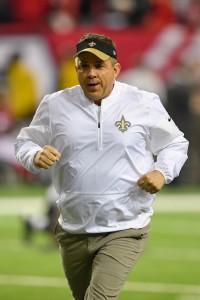 Schultz, 26, sought a shorter-term commitment, whereas the Cowboys continue to push for five- or six-year extensions. No deal transpiring means the fifth-year tight end can use Dallas’ receiver situation to his advantage and position himself for a monster 2023 free agency payday. The Bills took Dawson Knox off the 2023 market this week, and the Dolphins may be set to reduce fellow tagged tight end Mike Gesicki‘s value in Mike McDaniel‘s offense. Of course, the Cowboys can re-tag Schultz for roughly $13MM next year. The team went to the two-tag well with Lawrence and Prescott (the latter as a procedural move) recently.
Schultz, 26, sought a shorter-term commitment, whereas the Cowboys continue to push for five- or six-year extensions. No deal transpiring means the fifth-year tight end can use Dallas’ receiver situation to his advantage and position himself for a monster 2023 free agency payday. The Bills took Dawson Knox off the 2023 market this week, and the Dolphins may be set to reduce fellow tagged tight end Mike Gesicki‘s value in Mike McDaniel‘s offense. Of course, the Cowboys can re-tag Schultz for roughly $13MM next year. The team went to the two-tag well with Lawrence and Prescott (the latter as a procedural move) recently.
Frequently being asked about his support for third-year HC Mike McCarthy, Jerry Jones is not shy about sharing it. That said, the Payton prospect stands to linger. The Cowboys would have to send the Saints compensation, as Payton is under contract through 2024, but the former Dallas assistant has been an oft-rumored Jones target. A Payton confidant indicating the Super Bowl-winning coach would be interested in the Cowboys, Chargers or Dolphins (perhaps on the level this time) likely tripped the most alarms in Dallas.
McCarthy is also a Super Bowl champion HC, but Payton’s offensive acumen — which turned Drew Brees from an up-and-down Chargers passer into an all-time great as a Saint — is held in higher regard. And the Cowboys have been in a rather famous rut, at least regarding deep playoff runs, under their post-Jimmy Johnson leaders. Until McCarthy is confirmed to return, the potential Payton-Cowboys reunion will be a must-monitor coaching story.
Top 10 cap charges for 2022:
- Dak Prescott, QB: $19.73MM
- Ezekiel Elliott, RB: $18.22MM
- Tyron Smith, T: $17.51MM
- DeMarcus Lawrence, DE: $14MM
- Zack Martin, G: $12.03MM
- Dalton Schultz, TE: $10.93MM
- Anthony Brown, CB: $6.5MM
- Jourdan Lewis, CB: $4.64MM
- Michael Gallup, WR: $4.53MM
- Micah Parsons, LB: $3.88MM
The Commanders and Giants’ statuses look to again give the Cowboys an advantage, though the Eagles have improved their roster in many places. The Cowboys ranked first in DVOA last season, but the unraveling against the 49ers ended a 26th straight season shy of the NFC championship game. Among NFC teams, only the Detroit and Washington match that streak. Prescott’s four-year, $160MM extension will produce a major cap spike — to $49.13MM — in 2023; two void years are already on the deal to spread out the cap hit. That matter adds to 2022’s importance.
But the losses of three impact starters, along with the Smith injury, has inserted more doubt into the Cowboys’ 2022 equation. The team’s Jerry–Stephen Jones front office setup is not going anywhere, adding an unnecessary hurdle — at least compared to the franchises with quality traditional GMs — annually. Will this year’s Cowboys team surprise skeptics with a deep playoff run? If not, Jerry Jones will hear calls to bail on his current HC much quicker than he did Jason Garrett.
By Ely Allen |
at September 8, 2022 6:30 pm
As one of five NFL franchises entering last year with a new head coach and one of two who replaced their general manager as well, the Falcons saw middling results to start the Arthur Smith-Terry Fontenot era. At 7-10 in 2021, they surpassed the accomplishments of two of those other franchises, with the Jets finishing 4-13 and the Lions finishing 3-13-1, but failed to reach a winning record like the other two (9-8 Chargers and Eagles teams).
In Year 2 under Smith and Fontenot, though, it appears that it is time for a reset. The team moved on from former MVP quarterback Matt Ryan and toward a new path to success. Although the NFC does not appear quite as daunting as the deep AFC, this still looks to be a bit of a rebuilding year for the Falcons.
Trades:
From a team identity standpoint, Ryan’s departure cannot be overstated. The star out of Boston College has been the face of the franchise ever since he completed his first-ever NFL pass attempt for a 62-yard touchdown to wide receiver Michael Jenkins back in 2008. For 14 years, Ryan ensured the Falcons had an answer behind center, starting 222 of a possible 225 regular-season games. That start total tops Steve Bartkowski‘s previous Falcons QB standard by 101.
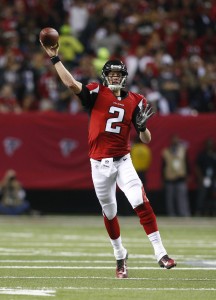 The franchise’s only MVP winner, Ryan obviously holds countless franchise records. The former No. 3 overall pick performed admirably through Atlanta’s low seasons as well as its highs. Injuries and a lack of surrounding talent have limited his win totals over the years, but the resilient quarterback still managed to win 120 games over his 14 seasons. Ryan’s MVP season fueled his team to Super Bowl LI. He threw 38 touchdown passes to just seven interceptions en route to a league-leading marks in quarterback rating (117.1) and QBR (79.6) that year. Perhaps a perfect display of Ryan’s consistency amid his team’s shortcomings: two years later, Ryan nearly matched his MVP output with 35 TD passes and seven INTs. The team’s record that year: 7-9.
The franchise’s only MVP winner, Ryan obviously holds countless franchise records. The former No. 3 overall pick performed admirably through Atlanta’s low seasons as well as its highs. Injuries and a lack of surrounding talent have limited his win totals over the years, but the resilient quarterback still managed to win 120 games over his 14 seasons. Ryan’s MVP season fueled his team to Super Bowl LI. He threw 38 touchdown passes to just seven interceptions en route to a league-leading marks in quarterback rating (117.1) and QBR (79.6) that year. Perhaps a perfect display of Ryan’s consistency amid his team’s shortcomings: two years later, Ryan nearly matched his MVP output with 35 TD passes and seven INTs. The team’s record that year: 7-9.
Going into the 2021 season, talk had already begun surrounding Ryan’s future. Many posited it would be wise to trade away the veteran quarterback to build up trade assets to replace him, but owner Arthur Blank insisted that Ryan would remain on the team for 2021. The team eventually restructured Ryan’s contract to lower his cap hit for last year, effectively making him even more difficult to deal in the future.
Early this offseason, Smith made his preference known by claiming he wished for Ryan to remain on the team in 2022. But reports soon surfaced that a succession plan was being discussed. Rumors ran rampant, claiming Ryan was unlikely to get traded and could get his contract restructured once more. Finally, the rumors came to an end when news leaked that Ryan was headed to Indianapolis. As a result of that aforementioned restructure, this trade stuck the Falcons with an NFL-record $40MM in dead money.
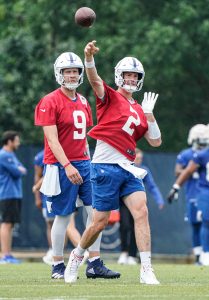 Now, the Falcons are staring at two possibilities concerning this season at quarterback. It could be territory the team has not traversed for most of the 21st century. Excluding a transitionary 2007 season that saw games started by quarterbacks Joey Harrington, Chris Redman, and Byron Leftwich, the Falcons have gone into 19 of their previous 20 seasons knowing that either Michael Vick or Ryan would be their starter. Atlanta will hope that 2022 is another transitory situation that will lead to the next long-tenured quarterback in red and black.
Now, the Falcons are staring at two possibilities concerning this season at quarterback. It could be territory the team has not traversed for most of the 21st century. Excluding a transitionary 2007 season that saw games started by quarterbacks Joey Harrington, Chris Redman, and Byron Leftwich, the Falcons have gone into 19 of their previous 20 seasons knowing that either Michael Vick or Ryan would be their starter. Atlanta will hope that 2022 is another transitory situation that will lead to the next long-tenured quarterback in red and black.
Another Falcons trade took place in the weeks after the draft, bringing in a new receiving target for Ryan’s replacement. Edwards, a 2020 third-round pick, took a big step forward in his sophomore season, partially due to the departure of teammate Henry Ruggs. With no Calvin Ridley and rookie first-round pick Drake London easing himself into the NFL after a college injury and a minor preseason malady, Edwards has an opportunity to see extensive time. Pitts is likely to hog most of the targets, as London and Edwards are brought up to speed, but the door is wide open for Edwards to become a regular Falcons contributor in his third season. Two years remain on his rookie contract.
Free agency additions:
- Marcus Mariota, QB. Two years, $18.75MM. $6.75MM guaranteed.
- Casey Hayward, CB. Two years, $11MM. $6MM guaranteed.
- Lorenzo Carter, OLB. One year, $3.5MM. $2MM guaranteed.
- Germain Ifedi, RT. One year, $1.19MM. $1.05MM guaranteed.
- Elijah Wilkinson, OL. One year, $1.13MM. $987.5K guaranteed.
- Rashaan Evans, LB. One year, $1.75MM. $500K guaranteed.
- Damien Williams, RB. One year, $1.62MM. $500K guaranteed.
- Damiere Byrd, WR. One year, $1.19MM. $400K guaranteed.
- Anthony Firkser, TE. One year, $1.19MM. $300K guaranteed.
- Dean Marlowe, S. One year, $1.19MM. $300K guaranteed.
- Vincent Taylor, DT. One year, $1.19MM. $275K guaranteed.
- Mike Ford, CB. One year, $1.19MM. $152.5K guaranteed.
- Beau Brinkley, LS. One year, $1.12MM.
- Bradley Pinion, P. One year, $1.12MM.
- KhaDarel Hodge, WR. One year, $1.07MM.
- Nick Kwiatkoski, LB. One year, $1.04MM.
- MyCole Pruitt, TE. One year, $1.04MM.
- Cameron Batson, WR. One year, $965K.
- Teez Tabor, CB. One year, $965K.
- Henry Black, S. One year, $895K.
- Darrion Daniels, DT. One year, $825K.
- Jalen Dalton, DT. One year, $705K.
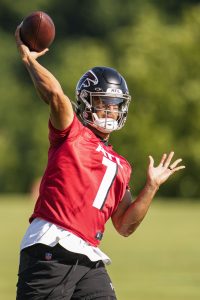 Once again, the biggest headline here comes at quarterback. The Falcons reunited Mariota with Smith, the Titans’ offensive coordinator during the former No. 2 overall pick’s last season in Tennessee. The team signed the 28-year-old on the same day it traded away Ryan. The sequence of transactions made it clear that Mariota was brought in to be Ryan’s successor. The intention came to fruition when Mariota was named the team’s starting quarterback two weeks before the preseason.
Once again, the biggest headline here comes at quarterback. The Falcons reunited Mariota with Smith, the Titans’ offensive coordinator during the former No. 2 overall pick’s last season in Tennessee. The team signed the 28-year-old on the same day it traded away Ryan. The sequence of transactions made it clear that Mariota was brought in to be Ryan’s successor. The intention came to fruition when Mariota was named the team’s starting quarterback two weeks before the preseason.
Atlanta also used its free agency money to bring in some immediate help on defense. The team signed Hayward and Carter four days apart, solidifying starters at corner and outside linebacker, respectively. Hayward’s best years came during his time with the Chargers when, over a two-season period (2016-17), he racked up 11 interceptions and an incredible 42 passes defensed. While 11th-year veteran has not been able to recreate that production since, he remains a reliable outside cornerback — whom Pro Football Focus slotted as a top-15 player at the position last season — who will immediately stand in opposite AJ Terrell.
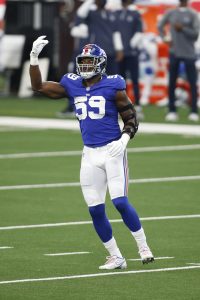 Carter is a younger defender who delivered decent production when healthy over his four years in New York. The former Giants third-round pick is expected to start alongside fellow free agent addition Evans and Mykal Walker. Evans was brought in to compete with and potentially replace Deion Jones. The latter’s IR stay, which comes after an offseason shoulder surgery, has tabled that matter until at least October. Evans was a full-time starter for much of his rookie contract after being drafted in the first round by Tennessee. As Mariota is reuniting with Smith on offense, Evans is linking back up with ex-Titans defensive coordinator Dean Pees.
Carter is a younger defender who delivered decent production when healthy over his four years in New York. The former Giants third-round pick is expected to start alongside fellow free agent addition Evans and Mykal Walker. Evans was brought in to compete with and potentially replace Deion Jones. The latter’s IR stay, which comes after an offseason shoulder surgery, has tabled that matter until at least October. Evans was a full-time starter for much of his rookie contract after being drafted in the first round by Tennessee. As Mariota is reuniting with Smith on offense, Evans is linking back up with ex-Titans defensive coordinator Dean Pees.
On offense, the Falcons added some depth. Williams is set to reprise his usual role as a No. 2 running back, this time behind Patterson. Williams’ presence as a veteran backup rusher should be advantageous for the development of rookie Tyler Allgeier. Atlanta also brought in some strong backup pieces for the offensive line. Ifedi will be a solid substitute for tackles Jake Matthews and Kaleb McGary, if needed. A swingman in Denver and a backup in Chicago, Wilkinson was on the verge of supplanting Jalen Mayfield at guard during camp. Mayfield, however, will begin the season on injured reserve.
Re-signings:
- Younghoe Koo, K. Five years, $24.25MM. $8MM guaranteed.
- Cordarrelle Patterson, WR/RB. Two years, $10.5MM. $5MM guaranteed.
- Erik Harris, S. One year, $1.27MM. $1.05MM guaranteed.
- Isaiah Oliver, CB. One year, $2.39MM. $530K guaranteed.
- Anthony Rush, NT. One year, $1.3MM. $165K guaranteed.
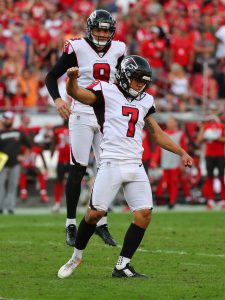 Atlanta has experience in long-term relationships with kickers. The team enjoyed 11 strong years out of place kicker Matt Bryant and nine years with punter Matt Bosher, moving on from both in 2019. That year brought Koo’s Falcons introduction. Koo joined the team in Week 10 and, after converting 23 of his 26 field goal attempts, never relinquished the kicking job.
Atlanta has experience in long-term relationships with kickers. The team enjoyed 11 strong years out of place kicker Matt Bryant and nine years with punter Matt Bosher, moving on from both in 2019. That year brought Koo’s Falcons introduction. Koo joined the team in Week 10 and, after converting 23 of his 26 field goal attempts, never relinquished the kicking job.
Over the next two seasons, Koo improved on his three misses from 2019 and charted a course to the top of the NFL’s accuracy list. Koo converted 64 of 68 field goal attempts from 2020-21, earning Pro Bowl acclaim in 2020. His 2020s conversion rate of 94.12% tops the NFL. This accuracy led to a nice extension, which made Koo the league’s third-highest-paid kicker. In a time when kickers are on the shortest of leashes, this long-term commitment shows a good amount of faith in the South Korean-American kicker.
The Falcons brought in Patterson last year on a one-year deal to supplement the receivers room and solidify the return game. Little did they know they were signing their starting running back. Over the first eight years of his career, Patterson enjoyed fairly limited success as a receiver with immense success in the return game. Patterson has been named a first- or second-team All-Pro kick returner in all but three seasons of his career and made four Pro Bowls. Tied with Josh Cribbs and Leon Washington for the most kick-return touchdowns in NFL history (eight), Patterson added another dimension to his game in Atlanta. The Falcons will see if he can replicate that effort.
Read more
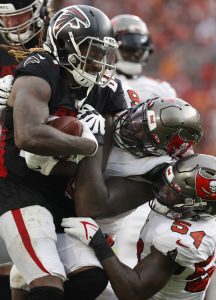 In one year with the Falcons, Patterson nearly doubled his career carries and nearly tripled his best single-season rushing output. Despite his increased role as a rusher (153 carries, 648 yards, six touchdowns), Patterson also put up career numbers as a receiver. He tied a career high in receptions (52) and set a career-best mark in receiving yards (548) and touchdown receptions (five). While Patterson’s age made this a rather odd breakout, his career as a returner and gadget player limited the tread on his tires. The Falcons can also punt on this deal after one season, should their 31-year-old back fall off his 2021 pace.
In one year with the Falcons, Patterson nearly doubled his career carries and nearly tripled his best single-season rushing output. Despite his increased role as a rusher (153 carries, 648 yards, six touchdowns), Patterson also put up career numbers as a receiver. He tied a career high in receptions (52) and set a career-best mark in receiving yards (548) and touchdown receptions (five). While Patterson’s age made this a rather odd breakout, his career as a returner and gadget player limited the tread on his tires. The Falcons can also punt on this deal after one season, should their 31-year-old back fall off his 2021 pace.
Atlanta was able to bring back a few defensive contributors in Harris, Oliver, and Rush, all of whom have started games for the team in recent years. Harris started every 2021 game for Atlanta at strong safety, before a torn pectoral muscle shelved him for last season’s final four games. He is set to start the year as a backup, with the Falcons lining up the younger Jaylinn Hawkins and Richie Grant at the safety spots.
After starting for much of his second and third seasons, Oliver saw his contract year cut short when he suffered a knee injury in Week 4. The Falcons are giving him another opportunity to earn a new contract, but his new platform year will not start on time. The team placed the former second-round pick on IR last week, sidelining him for at least four games. The Falcons signed Rush to their practice squad last year when he was cut from the Titans. He was eventually promoted to the active roster and started six games near the end of the season for Atlanta. After earning his first career starts with his seventh NFL team in three years, Rush is expected to start at defensive tackle for the Falcons to begin the year.
Notable losses:
- Jonathan Bullard, DT
- Brandon Copeland, OLB
- Mike Davis, RB (released)
- Tyeler Davison, DT (released)
- Dante Fowler, OLB (released)
- Russell Gage, WR
- Matt Gono, RT
- Duron Harmon, S
- Josh Harris, LS
- Hayden Hurst, TE
- A.J. McCarron, QB
- Steven Means, OLB
- Fabian Moreau, CB
- Thomas Morstead, P
- Foyesade Oluokun, LB
- Josh Rosen, QB
- Tajae Sharpe, WR
- Kendall Sheffield, CB
- Lee Smith, TE (retired)
- Jason Spriggs, OT
- Shawn Williams, S
The Falcons have commenced what may be viewed as a rebuild. Any rebuild is going to see a change of the guard, and a notable talent exodus took place in Atlanta this offseason. In addition to the Ryan trade, the team allowed McCarron and Rosen to follow the starter out of town. McCarron’s time in a Falcons uniform was limited to the preseason; a torn ACL led to the ex-Bengals backup missing the 2021 campaign. Atlanta has since refilled the room with Mariota and third-round rookie Desmond Ridder, with Feleipe Franks being the lone holdover. 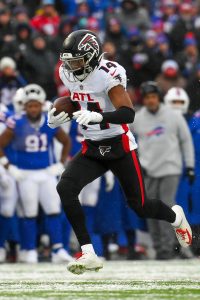
Both of Koo’s specialty mates are gone as well. The departures of Morstead and Harris led to the additions of Pinion and Brinkley. Morstead spent 12 seasons in New Orleans and arrived just partway through last season, but Harris had spent his entire 10-year career in Atlanta, earning his first Pro Bowl nod last year. The Chargers added have since added Harris as their long snapper.
Some of the defensive additions above look much more necessary with the departure of starters like Davison, Fowler, Harmon, Means, and Moreau. Rush should step up now to replace Davison in starting alongside Grady Jarrett, Carter should be able to make up for the loss of Fowler and Means in the pass rush, and Hayward will lessen the loss of Moreau immediately.
The offensive weapons that departed should, for the most part, be replaceable; they were mostly in backup roles with the team. Hurst will be the hardest to replace, but his talents became far less necessary with the quick emergence of Pitts. The Falcons will hope that Williams and Allgeier will be able to replace the production of the team’s second-leading rusher from last year, Davis, who departed for Baltimore in free agency.
Gage’s departure may hit harder; he had risen to a key place in Atlanta’s aerial pecking order. As Ridley’s surprising midseason departure left Ryan without both his standout starters, following the Julio Jones trade, Gage became his No. 1 wideout. After a 770-yard season, Gage received a three-year, $30MM offer to join the Buccaneers, keying a full-on Falcons reboot at the receiver position.
Draft:
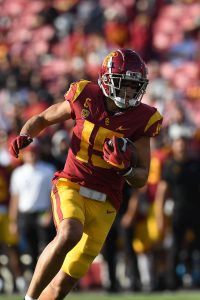 The Falcons approached the 2022 draft with a rebuild in mind but still were able to utilize their picks to fill some recent holes.
The Falcons approached the 2022 draft with a rebuild in mind but still were able to utilize their picks to fill some recent holes.
Many considered London the best wide receiver in the draft. Using a top-10 pick on a receiver for the first time since 2011’s Jones trade-up, the Falcons concurred. It says a lot about London’s abilities that he was the first receiver off the board at No. 8 overall; an ankle injury forced the 6-foot-5 weapon to miss the last few games of his final season at USC. Before his injury, London led the nation in receiving yards, contested catches, and missed tackles. He should be perfectly set to make up for the production lost via Gage’s departure and Ridley’s suspension. London should pair well with Pitts for years in the future.
Trades helped Atlanta to double down on pass rushers on Day 2. The team traded its original second-round pick, along with a fourth-rounder, to move up five spots and select Ebiketie. Fontenot utilized the extra third-round pick acquired in the Ryan trade to select Malone. After transferring from Temple, Ebiketie led the Nittany Lions with 9.5 sacks, more than tripling the production of the team’s next-closest defender. Malone’s best season came in 2019, when he racked up 11.0 sacks as a junior, but the five-year Hilltopper was able to produce 32.5 sacks and 59 tackles for loss during a career that included an extra year of eligibility due to COVID-19.
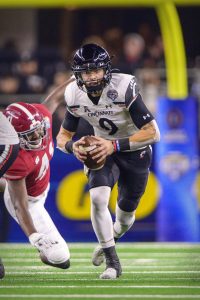 Aside from that early draft commotion, the weekend went fairly according to plan. The Falcons used the additional second-round pick acquired in last year’s Jones trade to add some young linebacker talent in Andersen. They also selected the second quarterback of the draft in the third round, adding Cincinnati’s Ridder. Mariota was named Atlanta’s starter, but Ridder could, and should, be viewed as the team’s future at quarterback. Given the Falcons’ status as a rebuilding squad, it would not surprise to see Ridder make several 2022 starts.
Aside from that early draft commotion, the weekend went fairly according to plan. The Falcons used the additional second-round pick acquired in last year’s Jones trade to add some young linebacker talent in Andersen. They also selected the second quarterback of the draft in the third round, adding Cincinnati’s Ridder. Mariota was named Atlanta’s starter, but Ridder could, and should, be viewed as the team’s future at quarterback. Given the Falcons’ status as a rebuilding squad, it would not surprise to see Ridder make several 2022 starts.
In the later rounds, the Falcons took a few stabs on offense. In the fifth round, they nabbed 2021’s Division I-FBS rushing touchdowns leader (Allgeier). As a fourth-year sophomore, Allgeier finished third in the nation with 1,606 rushing yards to go along with 23 touchdowns. With Patterson a rare 10th-year running back and Williams having not enjoyed a regular role since 2019, a path to Allgeier earning a notable playing time as a rookie may not be particularly daunting.
Three of the 13 Falcons undrafted free agents ended up surviving the final roster cuts last week. Wide receiver Jared Bernhardt made headlines by making the 53-man roster despite only playing the sport for one year. Bernhardt was a lacrosse player at Maryland for five seasons, earning the Tewaaraton Award for the nation’s best collegiate lacrosse player. He left the Terrapins as a graduate transfer to start at quarterback for Ferris State and led the Bulldogs to a 14-0 season that included a Division II championship. The Falcons also kept rookie UDFAs in defensive tackle Timmy Horne (NC State) and linebacker Nate Landman (Colorado).
Extensions and restructures:
Atlanta brought back two of its big men on three-year extensions. Despite the Falcons jettisoning many pieces from their Super Bowl LI core in recent years, the Fontenot regime re-signed two of those cogs to third contracts.
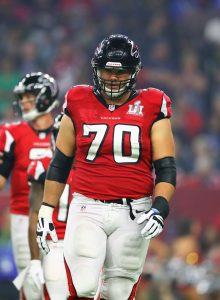 Jarrett, 29, has been a Falcon since arriving as a 2015 fifth-round pick and, after completing his rookie season, has been a mainstay in the middle of the Atlanta defense. He improved year after year until, in 2019, he made his first Pro Bowl with a 7.5-sack season. Jarrett’s production has dipped in recent years, but he is still an important piece of Atlanta’s front seven and should continue to hassle opposing quarterbacks going into his eighth season.
Jarrett, 29, has been a Falcon since arriving as a 2015 fifth-round pick and, after completing his rookie season, has been a mainstay in the middle of the Atlanta defense. He improved year after year until, in 2019, he made his first Pro Bowl with a 7.5-sack season. Jarrett’s production has dipped in recent years, but he is still an important piece of Atlanta’s front seven and should continue to hassle opposing quarterbacks going into his eighth season.
Matthews is another career-long Falcon, playing in Atlanta one year longer than Jarrett. Matthews, 30, has been one of the NFL’s most dependable tackles. Besides the second game of his rookie season, Matthews has started in every possible game of his career without fail. The blindside blocker even earned a Pro Bowl in 2018, triggering his first contract extension — a five-year, $72.5MM pact. The left tackle market has climbed in recent years, producing a few $20MM-AAV players. Matthews did not see his second Falcons extension land quite on that level, but he did receive a substantial raise. The former first-rounder’s $18.5MM average salary ranks fifth among left tackles.
Other:
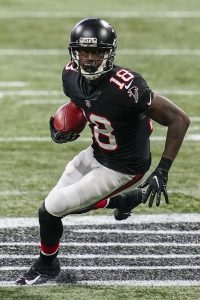 One of the toughest absences the Falcons will have to deal with is that of their top wide receiver. Ridley made headlines in March after it was announced that he had wagered $1,500 betting on NFL games. The betting reportedly occurred “during a five-day period in November 2021,” a span in which it has been determined that Ridley was away from the team after being placed on the non-football injury list.
One of the toughest absences the Falcons will have to deal with is that of their top wide receiver. Ridley made headlines in March after it was announced that he had wagered $1,500 betting on NFL games. The betting reportedly occurred “during a five-day period in November 2021,” a span in which it has been determined that Ridley was away from the team after being placed on the non-football injury list.
The 2018 first-round pick was placed on the NFI list due to personal matters and mental health, and rumors were starting to emerge linking him to trade possibilities. It was reported that the wagers consisted of parlay bets with some including the Falcons to win. As a result of the activity, the NFL suspended Ridley for at least the 2022 season.
Ridley’s 1,374 receiving yards and nine touchdowns in 2020, as Jones battled hamstring trouble, looked to move him closer to a Falcons extension. But the 2021 NFI absence and offseason suspension cloud his future with the franchise. Rather than hit free agency after five years, Ridley’s rookie contract will toll to 2023. Considering the Falcons were close to trading him to the Eagles — before it was known he would be banned for 2022 — it does not appear Ridley’s $11.12MM fifth-year option salary is firmly in Atlanta’s plans for 2023. In his absence, Mariota will have to rely on Pitts, Patterson, London, Edwards, and Olamide Zaccheaus to be on the other end of his passes.
After having the 14th and 31st overall picks of the 2019 NFL Draft, the Falcons had two decisions to make in terms of fifth-year options this past offseason. Atlanta had used the picks on Lindstrom and McGary, respectively, relying on both players as starters on the offensive line ever since. Back in May, the Falcons divided the pair, timeline-wise, by keeping Lindstrom through 2023 but turning McGary’s 2022 season into a contract year. Neither decision was necessarily a surprise. Lindstrom has improved with each year of play in the league, while McGary has struggled to find the same upwards trajectory.
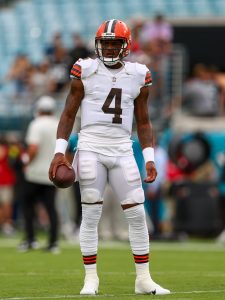 The Browns have taken heat for their Watson acquisition, largely due to the guarantee record ($230MM) the team set to convince him to change his mind on returning home. The embattled Texans quarterback was believed to be on the cusp of waiving his no-trade clause for the Falcons, who had shopped Ryan before knowing Watson’s decision. But most in the Falcons organization assumed Watson was Atlanta-bound.
The Browns have taken heat for their Watson acquisition, largely due to the guarantee record ($230MM) the team set to convince him to change his mind on returning home. The embattled Texans quarterback was believed to be on the cusp of waiving his no-trade clause for the Falcons, who had shopped Ryan before knowing Watson’s decision. But most in the Falcons organization assumed Watson was Atlanta-bound.
The Pro Bowl quarterback had also begun contacting free agents — Leonard Fournette and Jarvis Landry among them — to see about teaming with him in Georgia. Jadeveon Clowney also said he likely would have followed Watson to Atlanta, rather than re-signing with Cleveland. The Browns’ monster guarantee proposal did not only change the game for the AFC North franchise; it altered the Falcons’ plan.
While Ryan still would have been out of the picture, Watson would have changed the Falcons’ rebuild plan. The team, which also joined the Saints and Panthers in being a Watson finalist, was prepared to part with the historic trade haul (three first-round picks and change) to land the quarterback. The Falcons were not comfortable with the guarantee figure the Browns offered and stood down. This keeps the Falcons’ future draft arsenals intact and allowed them to largely evade the Watson-generated criticism avalanche that has come the Browns’ way. It also leaves the Falcons without a surefire long-term quarterback answer, though the team will soon begin seeing if Ridder can be that player. Still, Atlanta’s Watson interest led to the point it became a significant NFL what-if sequence.
Top 10 cap charges for 2022:
- Jake Matthews, LT: $15.19MM
- Grady Jarrett, DT: $12.93MM
- Kyle Pitts, TE: $7.48MM
- Chris Lindstrom, G: $4.68MM
- Marcus Mariota, QB: $4.25MM
- Casey Hayward, CB: $4MM
- Drake London, WR: $3.92MM
- AJ Terrell, CB: $3.9MM
- Kaleb McGary, RT: $3.27MM
- Younghoe Koo, K: $3MM
Selling the face of the franchise sets the Falcons up for a rebuild, but the additions made through the draft and free agency seem to indicate Fontenot and Smith are aiming for quite a quick rebuild. The offense is littered with young talent in Ridder, Allgeier, London, and Pitts. All the holes on defense created by departures were filled with capable, productive veterans.
If the youthful skill-position nucleus can develop quickly (as we’ve seen often in the NFL, lately) behind an experienced offensive line, a veteran defense, and a strong core on special teams, Atlanta’s rebuild could be finished in a year or two. For now, though, fans will have some new faces to get used to and, in a year that isn’t likely to bring much success, can try to pinpoint the next few moves necessary to urge this team toward long-term success.
By Sam Robinson |
at September 7, 2022 10:05 pm
After a late-season turnaround nearly produced a second Super Bowl trip in three years, the 49ers saw trade rumors overshadow their offseason. Two chapters of Jimmy Garoppolo trade talks emerged — before and after a March shoulder surgery that changed the equation — and Deebo Samuel sent out a request to be moved. As San Francisco gears up for its sixth Kyle Shanahan season, Samuel and Garoppolo are back in the fold. The 49ers are once again expected to be a Super Bowl contender, but their quarterback variable hovers as one of the NFC’s top wild cards.
Extensions and restructures:
One of many teams forced to navigate a rapidly changing wide receiver market this offseason, the 49ers negotiated perhaps the most obstacles en route to their extension. Samuel requested a trade in April, and reasons from his backfield usage to a desire to no longer live in California surfaced. In the end, the All-Pro’s demands might have been simpler. Money talked. But it took a while for the parties to find a resolution.
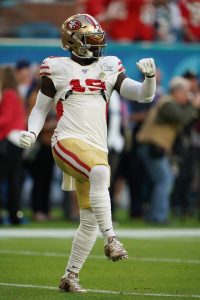 When Samuel fired off his trade request, no member of the talented sect of Day 2 receiver draftees from the 2019 class had landed extensions. The 49ers’ initial offer was believed to have come in south of $19MM per year. As Davante Adams and Tyreek Hill were resetting the market — an effort that trickled down to the lot of fourth-year receiver extension candidates — a line of disgruntled pass catchers formed. Samuel was connected to a $25MM-per-year demand weeks before A.J. Brown secured that payout after a trade, but the 49ers held firm to protect their star receiving talent.
When Samuel fired off his trade request, no member of the talented sect of Day 2 receiver draftees from the 2019 class had landed extensions. The 49ers’ initial offer was believed to have come in south of $19MM per year. As Davante Adams and Tyreek Hill were resetting the market — an effort that trickled down to the lot of fourth-year receiver extension candidates — a line of disgruntled pass catchers formed. Samuel was connected to a $25MM-per-year demand weeks before A.J. Brown secured that payout after a trade, but the 49ers held firm to protect their star receiving talent.
Multiple offers involving first-round picks were rumored to have come in for Samuel. The Jets, who were connected to just about every receiver trade rumor ahead of the draft, offered their No. 10 overall pick. But New York’s proposal would have involved San Francisco’s second-round pick coming back, limiting the offer’s appeal. The Jets then chose Ohio State’s Garrett Wilson, and the 49ers exited the draft without coming too close to trading Samuel. While the former South Carolina standout proceeded with the en vogue hold-in at both minicamp and to start training camp, he cashed in on a deal quite similar to the ones given to Terry McLaurin and D.K. Metcalf.
The Eagles and Commanders set the market for the young, extension-seeking wideouts. Samuel’s $23.85MM-per-year contract checks in eighth at his official position, just south of Metcalf. But the 49ers gave their top receiver $10MM more in fully guaranteed money. Incentives are also tied to his backfield usage. Shanahan said Samuel concerns over his occasional work as a running back were not a factor during the negotiations, but the contract does include a $650K bonus for each 380-yard rushing season and a $150K bump for every slate in which Samuel rushes for at least three touchdowns.
During a season in which Samuel led the NFL in yards per catch — an 18.2-yard figure buoyed by the unique playmaker’s perennially lofty YAC-per-reception number (10.4 in 2021) — he accumulated 365 rushing yards and eight rushing TDs. The latter number is miles ahead of where a traditional modern wideout has gone; no other post-merger receiver has tallied more than four rushing scores in a season. Prior to helping the 49ers eke out a playoff win in Dallas, Samuel became the only player in NFL history to compile 1,400-plus receiving yards and 300-plus rushing yards in a season. Samuel, 26, will not carry a cap number north of $10MM until 2023, helping the 49ers with their roster-construction efforts going forward.
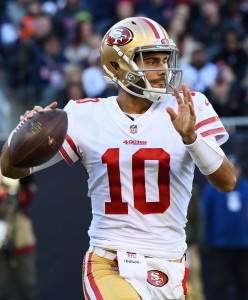 When the 49ers finally extended Samuel, they still had Garoppolo’s $26.9MM cap number atop their payroll. But that number has since dropped below $14MM, giving the team much-needed flexibility entering the season. Although it took nearly the full offseason for the 49ers to find a solution, their creative Garoppolo plan may prove beneficial in more ways than one.
When the 49ers finally extended Samuel, they still had Garoppolo’s $26.9MM cap number atop their payroll. But that number has since dropped below $14MM, giving the team much-needed flexibility entering the season. Although it took nearly the full offseason for the 49ers to find a solution, their creative Garoppolo plan may prove beneficial in more ways than one.
Immediately after the NFC championship game, 49ers brass confirmed their intention to trade Garoppolo. The franchise that had gotten two second-round picks from the Chiefs for Alex Smith in 2013 floated a Day 2 pick as the early asking price. Garoppolo, 30, undergoing thumb surgery in February did not hijack his market; his unexpected March shoulder operation did. The 49ers were talking to multiple teams on Garoppolo at the Combine, but after news of the shoulder procedure emerged just before the 2022 league year began, QB-needy franchises moved on rather than wait for Garoppolo to recover.
The Broncos, Browns, Commanders and Colts traded for starting QBs; the Steelers used a first-round pick on one. The Falcons and Saints turned to free agency to fill their needs. When the dust settled, the Panthers and Seahawks loomed as the only logical players here. Leery about Garoppolo’s injury history, the Panthers went with Baker Mayfield. Intra-divisional QB trades are rare but not unprecedented, as deals involving Donovan McNabb (2010), Drew Bledsoe (2002) and Jeff Kemp (traded from the Rams to the 49ers in 1986) have shown. But the Seahawks, curiously, were not interested in trading for another QB after taking current backup Drew Lock in the Russell Wilson deal.
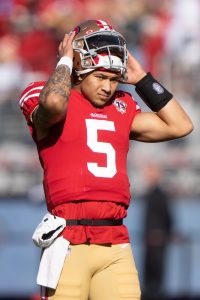 Seattle was rumored to be lingering as a free agency destination, and Cleveland — with Deshaun Watson‘s suspension increased to 11 games — did not get aggressive on Garoppolo to overtake Jacoby Brissett. This led to an outcome the 49ers teased but ultimately did not anticipate happening. Garoppolo’s $24.2MM base salary dropped to $6.5MM, with an incentive package allowing his reworked contract to max out at $15.45MM. Considering the incentives are tied to Garoppolo playing, his return for a sixth 49ers season invites questions about Trey Lance.
Seattle was rumored to be lingering as a free agency destination, and Cleveland — with Deshaun Watson‘s suspension increased to 11 games — did not get aggressive on Garoppolo to overtake Jacoby Brissett. This led to an outcome the 49ers teased but ultimately did not anticipate happening. Garoppolo’s $24.2MM base salary dropped to $6.5MM, with an incentive package allowing his reworked contract to max out at $15.45MM. Considering the incentives are tied to Garoppolo playing, his return for a sixth 49ers season invites questions about Trey Lance.
The 49ers have oozed positivity on their prized prospect throughout the offseason, and Shanahan communicated to his new starter the potential plan for Garoppolo staying. But Lance has thrown 389 in-game passes since his high school graduation. He went through an uneven rookie year — one in which he did not threaten Garoppolo’s job security, even as the starter encountered multifront injury trouble — but a finger injury is believed to have been responsible for some of Lance’s early rockiness. But the Shanahan-Mac Jones pre-draft connection has not completely receded. And Lance now has a two-time NFC championship game starter healthy, following a four-month rehab process, and with money tied to his 2022 playing time.
This does not bring the skill level the Joe Montana–Steve Young controversies of the late 1980s did, but Lance-Garoppolo should generate considerable intrigue given the talent the 49ers’ roster holds. A high-ceiling but raw prospect will attempt to hold off a high-floor veteran who has two top-13 QBR finishes (and a slew of injuries) as a 49er.
This 11th-hour compromise’s potential effect on Lance’s development notwithstanding, Garoppolo staying protects the 49ers against the ex-Division I-FCS star not being capable of leading a Super Bowl contender just yet. Barring Lance showing he is more than ready to take over early in the season, and the 49ers reopening Garoppolo trade talks (with a contract now easier to move), Garoppolo (33-14 as a 49ers starter) stands to hover. Ahead of his 2023 free agency, Garoppolo’s usage will easily provide one of the NFL’s top storylines.
Free agency additions:
- Charvarius Ward, CB. Three years, $42MM. $18.1MM guaranteed.
- George Odum, S. Three years, $5.7MM. $3.04MM guaranteed.
- Ray-Ray McCloud, WR. Two years, $4MM. $2.79MM guaranteed.
- Hassan Ridgeway, DL. One year, $1.8MM. $1MM guaranteed.
- Kerry Hyder, DE. One year, $1.5MM. $750K guaranteed.
- Tyler Kroft, TE. One year, $1.22MM. $25K guaranteed.
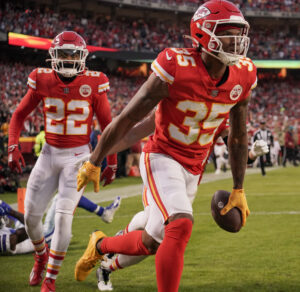 Cooper Kupp and Odell Beckham Jr. carved up the 49ers’ secondary during the Rams’ NFC title game triumph, which reversed the Shanahan-over-Sean McVay trend that had formed in this rivalry. And Ward’s contract is the biggest cornerback deal the 49ers have authorized under the Shanahan-Lynch regime. The 49ers entered 2021 light at corner; their 2022 outlook is a bit rosier after poaching Ward from the Chiefs.
Cooper Kupp and Odell Beckham Jr. carved up the 49ers’ secondary during the Rams’ NFC title game triumph, which reversed the Shanahan-over-Sean McVay trend that had formed in this rivalry. And Ward’s contract is the biggest cornerback deal the 49ers have authorized under the Shanahan-Lynch regime. The 49ers entered 2021 light at corner; their 2022 outlook is a bit rosier after poaching Ward from the Chiefs.
While San Francisco did spend a bit for Richard Sherman in 2018, Kansas City has not devoted notable funds to this position in ages. That led Ward out of Missouri.
A former Cowboys UDFA that landed with the Chiefs via a 2018 trade for guard Parker Ehinger, Ward emerged as a Chiefs starter for three seasons. He notched career-best marks in completion percentage allowed and passer rating as the closest defender in 2019 and delivered his best yards-per-target number in 2021. Pro Football Focus viewed 2021 as Ward’s best season, slotting him as a top-25 corner.
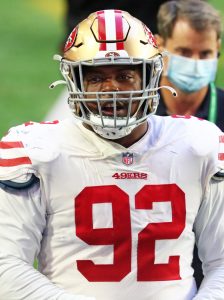 Ward’s struggles against Ja’Marr Chase became late-season highlight fodder, but he was one of the top corners on the market. Ward, 26, fetched the second-most money among UFA corners this offseason — behind only J.C. Jackson — and will be expected to anchor the 49ers’ coverage corps. Playing on a defense that houses Nick Bosa, Arik Armstead and Fred Warner stands to help Ward succeed in doing so.
Ward’s struggles against Ja’Marr Chase became late-season highlight fodder, but he was one of the top corners on the market. Ward, 26, fetched the second-most money among UFA corners this offseason — behind only J.C. Jackson — and will be expected to anchor the 49ers’ coverage corps. Playing on a defense that houses Nick Bosa, Arik Armstead and Fred Warner stands to help Ward succeed in doing so.
San Francisco adding Hyder for just $1.5MM could be a key move for its defensive line. Hyder, 31, led the 2020 49ers with 8.5 sacks. That came without Bosa drawing double-teams, with the Pro Bowler going down early that year. The former Lions UDFA struggled in his one Seahawks season, but the 49ers are set to deploy Hyder as a rotational rusher on a deep D-line. Hyder joins Samson Ebukam, midseason trade acquisition Charles Omenihu and second-round pick Drake Jackson as Bosa edge sidekicks.
Re-signings:
- Jeff Wilson, RB. One year, $1.09MM. $430K guaranteed.
- Maurice Hurst, DT. One year, $1.09MM
- Jake Brendel, C. One year, $1.04MM
- Jason Verrett, CB. One year, $1.04MM
- Jordan Willis, DE. One year, $1.04MM
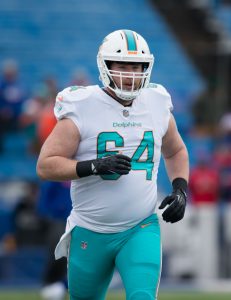 The 49ers were able to bring back some key depth pieces and/or unexpected starters at league-minimum prices. Although Hurst is out for the season and Verrett has a strong case as the NFL’s most injury-prone player (he is on the team’s reserve/PUP list to start the season), the other returning role players figure to see frequent time.
The 49ers were able to bring back some key depth pieces and/or unexpected starters at league-minimum prices. Although Hurst is out for the season and Verrett has a strong case as the NFL’s most injury-prone player (he is on the team’s reserve/PUP list to start the season), the other returning role players figure to see frequent time.
A 2021 afterthought, Brendel is now a key figure for a 49ers line that is set to be light on interior experience. The 49ers resisted calls to sign a veteran to replace Alex Mack; they are simply promoting Mack’s seldom-used backup. A former UDFA who was with 49ers O-line coach Chris Foerster in Miami, Brendel played six offensive snaps last season. The seventh-year veteran has three career starts. The 49ers tried two-year right guard Daniel Brunskill at center early in camp, but the team prefers the veteran as its interior swingman. Considering what the team is trying at guard, its insistence to use the soon-to-be 30-year-old Brendel as its pivot represents part of a dicey O-line strategy as Lance settles in.
Better known in MLB circles as the player that ignited Tommy Pham’s bizarre fantasy-spurred slap of Joc Pederson, Wilson looks again to be the 49ers’ top backup. The team has used third-round picks on backs in each of the past two years, but The Athletic’s Matt Barrows notes Wilson’s grip on the No. 2 RB job remains firm.
Read more
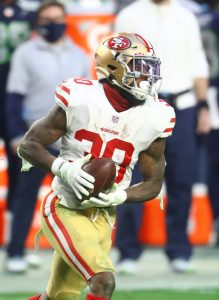 Wilson, who has signed low-cost 49ers deals in each of the past two offseasons, was better in 2020 — when he averaged 4.8 yards per carry and posted a 183-yard Week 16 outing in Arizona — but missed half of last season due to a foot injury. After a smoother offseason, Wilson should be back as a quality reserve behind the oft-injured Elijah Mitchell.
Wilson, who has signed low-cost 49ers deals in each of the past two offseasons, was better in 2020 — when he averaged 4.8 yards per carry and posted a 183-yard Week 16 outing in Arizona — but missed half of last season due to a foot injury. After a smoother offseason, Wilson should be back as a quality reserve behind the oft-injured Elijah Mitchell.
The two seasons in which Verrett has logged heavy participation — 2015 and ’20 — have ended with a Pro Bowl (2015) and a top-10 Pro Football Focus grade (2020). In every other season, injuries have wrecked the former first-round corner’s years. Verrett has torn both ACLs and an Achilles during his pro career, but the 49ers continue to value the former Chargers draftee. Verrett, 31, is finishing up rehab from his second ACL tear and has made it past one game in just one of the past five seasons. 2022 likely profiles as the veteran cover man’s last chance.
Anything the TCU alum contributes this year should be considered a bonus, but Verrett as a backup option behind Ward and Emmanuel Moseley gives the 49ers quality — albeit unreliable — depth. Both Verrett and starting safety Jimmie Ward are out of the mix to start the year. The elder of the 49ers’ two DB Wards will miss at least four games due to a hamstring injury sending him to IR.
Notable losses:
- Tom Compton, OL
- Darqueze Dennard, CB (released)
- Dee Ford, DE (released)
- Jamycal Hasty, RB (waived)
- D.J. Jones, DT
- Arden Key, DE
- Alex Mack, C (retired)
- Raheem Mostert, RB
- Josh Norman, CB
- Mohamed Sanu, WR
- Trey Sermon, RB (waived)
- Nate Sudfeld, QB (released)
- Jaquiski Tartt, S
- Laken Tomlinson, G
- K’Waun Williams, CB
A host of talent departed the Bay Area this year. The most notable changes came up front. Three of the 49ers’ five O-line starters from last season’s stretch run are gone, leaving an unusual plan in place — for a contending team, at least.
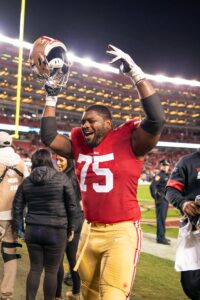 The 49ers generated great value from their 2017 trade with the Lions, which sent Tomlinson to San Francisco for a 2019 fifth-round pick. A former first-round pick, Tomlinson, turned his career around with the 49ers. He started 80 games for the 49ers from 2017-21, missing just one contest. Tomlinson, who had signed an extension to stay in San Francisco during the 2018 offseason. His Jets deal (three years, $40MM) to reunite with ex-49ers assistant Mike LaFleur is far more lucrative.
The 49ers generated great value from their 2017 trade with the Lions, which sent Tomlinson to San Francisco for a 2019 fifth-round pick. A former first-round pick, Tomlinson, turned his career around with the 49ers. He started 80 games for the 49ers from 2017-21, missing just one contest. Tomlinson, who had signed an extension to stay in San Francisco during the 2018 offseason. His Jets deal (three years, $40MM) to reunite with ex-49ers assistant Mike LaFleur is far more lucrative.
Preparing for the possibility Tomlinson would leave, the 49ers used a second-round pick on Aaron Banks last year. Banks essentially redshirted as a rookie, playing just five offensive snaps. The 49ers had seen enough Banks growth to declare him ready to start late last season, but the Notre Dame product is ready to go now. Banks received almost all the first-team left guard reps this offseason but submitted an up-and-down preseason.
McGlinchey’s 2021 replacement — Compton — signed with the Broncos. While the fifth-year starter returned from his season-ending quadriceps tear to play in San Francisco’s first preseason game, he experienced knee pain in the August opener and missed multiple weeks. The interior-line inexperience means the 49ers probably need McGlinchey to stay on the field more than they did last season. A healthy season would behoove McGlinchey as well; he is in a contract year. Considering how light the 49ers’ expenses are in the middle of their line, their right tackle profiles as an extension candidate.
The 49ers pursued O-line trades before cutdown day and have been proactive here under Shanahan (as the additions of Tomlinson, Mack and Trent Williams showed). But waiver claim Blake Hance (eight Browns starts in 2021, at both left and right tackle) looks to be the only reinforcement coming — for now.
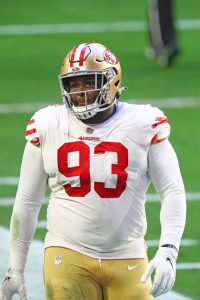 Mack’s reunion with Shanahan, his 2016 OC in Atlanta, went well. The decorated center started all 20 49ers games, graded as PFF’s No. 12 center and helped Mitchell break through despite his status as a sixth-round rookie. The 49ers restructured the 13-year veteran’s contract this summer, as retirement loomed. The move created some cap space and offered Mack a parting gift.
Mack’s reunion with Shanahan, his 2016 OC in Atlanta, went well. The decorated center started all 20 49ers games, graded as PFF’s No. 12 center and helped Mitchell break through despite his status as a sixth-round rookie. The 49ers restructured the 13-year veteran’s contract this summer, as retirement loomed. The move created some cap space and offered Mack a parting gift.
Jones joins Compton in Denver, signing a three-year, $30MM deal. The former fifth-round pick had emerged as one of the NFL’s ascending defensive tackles during his contract year in San Francisco. He became a handful for interior O-linemen down the stretch, helping the Javon Kinlaw-less 49ers front wreak havoc at points as they made a belated playoff push. Kinlaw has not justified his first-round draft status yet, but he is healthy again and ready to team with Armstead.
Williams served as the 49ers’ slot corner for five seasons; he also trekked to Denver. Williams, 31, had been the 49ers’ most consistent corner presence during his midcareer stay. Tartt’s dropped INT gimme proved an NFC championship turning point, but the former second-rounder still signed three 49ers contracts and gave the team 64 starts.
A rumor indicating conversations about a Mostert extension surfaced before free agency, but the injury-prone speedster followed Mike McDaniel to Miami. The Shanahan-era 49ers tried veteran deals for Jerick McKinnon and Tevin Coleman, but this offense hummed loudest when Mostert was healthy. The 220 yards Mostert amassed during his 2019 NFC title game demolition of the Packers remain a championship-round record — by a cool 26-yard margin. Only Eric Dickerson has rushed for more yards in a playoff game. But Mostert, 30, ran into rampant injury trouble in the two seasons since; he missed 24 games since 2020. Mostert rising from special-teamer to valuable back may well have nudged the 49ers further against paying for backfield help. It has been all draft picks since Coleman and McKinnon came off the books.
Regarding payments, Ford might be the biggest Lynch-era misfire. The 49ers sent a second-round pick to the Chiefs for a player who already had injury concerns. After authorizing a five-year, $85.5MM contract that protected the 49ers initially, the team restructured it to make Ford tougher to cut. Ford encountered a few major maladies — most notably a concerning neck issue — and missed 31 games as a 49er. Despite being released three years after the trade occurred, the former first-round pick will count more than $14MM in dead-money charges in 2022 and ’23 combined.
Draft:
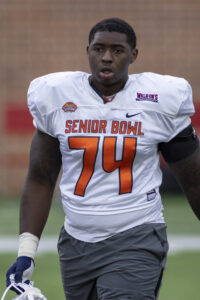 The Lance trade cost the 49ers their 2022 and ’23 first-rounders, placing added importance on the team’s Day 2 and Day 3 picks. Going into Week 1, San Francisco’s Day 3 lot this year has beaten its Day 2 choices to the punch for regular roles.
The Lance trade cost the 49ers their 2022 and ’23 first-rounders, placing added importance on the team’s Day 2 and Day 3 picks. Going into Week 1, San Francisco’s Day 3 lot this year has beaten its Day 2 choices to the punch for regular roles.
Burford seized the right guard job during camp. Considering Brunskill’s durability (33 straight starts at right guard), this offensive line’s lack of seasoning and Burford being the No. 134 overall pick out of a non-Power 5 program, this makes for one of the bigger surprises for any team’s O-line to start the season. Burford spent his final two years at the Conference USA school, where he was the program’s first four-star recruit, mostly playing left tackle. But he was the Roadrunners’ primary left guard as a sophomore. While Brunskill reclaiming his role would not surprise, it is Burford’s to start the season.
Womack’s emergence, which crested with a two-interception preseason debut, led to Dennard’s release. The 49ers will replace Williams, their five-year slot defender, with a fifth-rounder from the Mid-American Conference. While Womack goes 5-foot-9, the 49ers eyed the Toledo alum for hits reach (32-inch arm length) and ball skills (21 pass breakups as a senior).
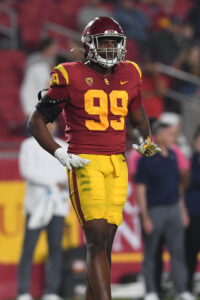 The path appears clear for Jackson (25 tackles for loss in three USC years) to be Bosa’s long-term complement, but for now, the 49ers have depth they can afford to break him in slowly. Bolstered by position coach Kris Kocurek, the 49ers have produced excellent D-line play. Evaluation-wise, this regime has not been as good. Misses on Ford, No. 3 overall pick Solomon Thomas and, thus far, Kinlaw have hurt. Bosa would fly in the face of this stance, and he has helped cover for these mistakes. But Bosa was closer to an open-and-shut No. 2 pick. Like Thomas and Armstead, Jackson worked at both D-end and inside during camp.
The path appears clear for Jackson (25 tackles for loss in three USC years) to be Bosa’s long-term complement, but for now, the 49ers have depth they can afford to break him in slowly. Bolstered by position coach Kris Kocurek, the 49ers have produced excellent D-line play. Evaluation-wise, this regime has not been as good. Misses on Ford, No. 3 overall pick Solomon Thomas and, thus far, Kinlaw have hurt. Bosa would fly in the face of this stance, and he has helped cover for these mistakes. But Bosa was closer to an open-and-shut No. 2 pick. Like Thomas and Armstead, Jackson worked at both D-end and inside during camp.
Gray’s 4.33-second 40 speed enthralled the 49ers, who now have an interesting weapon behind Samuel, Brandon Aiyuk and Jauan Jennings, while Davis-Price helped bump Trey Sermon off the roster. The 49ers had hoped to keep Sermon on their practice squad, but the 2021 third-rounder is now an Eagle. Davis-Price, the latest in a recent run of LSU-developed backs, totaled 1,003 rushing yards as a junior. He is the team’s third-string back for now, though an offseason report indicated this pick was a bit of an olive branch to Samuel, who saw backfield injuries lead him to more time at the most punishing skill position.
Other:
Some notable near-misses emerged during the winter. Amazon’s offer would have dwarfed Lynch’s GM salary and returned the Hall of Famer to a career field in which he has spent more time. Lynch worked for FOX for nearly a decade, but he has paired well with Shanahan, overseeing much of the team’s defensive moves as the play-calling HC oversees the offense.
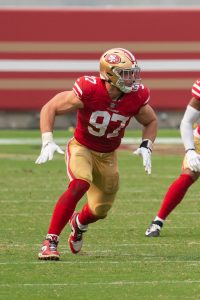 Months before Garoppolo’s 2017 San Francisco arrival, Lynch famously asked Bill Belichick if he would be open to trading Brady to the 49ers. While Derek Carr looks to have indeed been “that mother******,” Brady had the 49ers on his radar in 2020. And it looks like the all-time great was interested in his hometown team again this year. The 49ers were not even Brady’s top 2022 what-if. The Dolphins — as a stiff penalty confirmed — made an aggressive (and impermissible) pursuit for the then-retired QB. Then-Buccaneers HC Bruce Arians said Tampa Bay would not trade Brady’s rights if he wanted to come out of retirement and play elsewhere. Brady, then, returned to the team that held his rights, clearing the road for Lance. With Garoppolo a 2023 free agent, does Brady resurface on the 49ers’ radar as a soon-to-be 46-year-old next year?
Months before Garoppolo’s 2017 San Francisco arrival, Lynch famously asked Bill Belichick if he would be open to trading Brady to the 49ers. While Derek Carr looks to have indeed been “that mother******,” Brady had the 49ers on his radar in 2020. And it looks like the all-time great was interested in his hometown team again this year. The 49ers were not even Brady’s top 2022 what-if. The Dolphins — as a stiff penalty confirmed — made an aggressive (and impermissible) pursuit for the then-retired QB. Then-Buccaneers HC Bruce Arians said Tampa Bay would not trade Brady’s rights if he wanted to come out of retirement and play elsewhere. Brady, then, returned to the team that held his rights, clearing the road for Lance. With Garoppolo a 2023 free agent, does Brady resurface on the 49ers’ radar as a soon-to-be 46-year-old next year?
Both Griese and Lynn played for Mike Shanahan in Denver, but while Lynn has risen to a head-coaching position and been a coordinator with two teams, this will be Griese’s first coaching gig. ESPN’s continued tinkering with its Monday Night Football booth led Griese, whose playing career also overlapped with Kyle Shanahan‘s time as a Buccaneers quality control staffer, back to the league. Entering the summer, as Garoppolo was on the trade block, he and Griese had not spoken. This new hire, then, represents an interesting wrinkle as Garoppolo returns. The Lions made Lynn an OC one-and-done this year; Dan Campbell stripped the ex-Chargers HC of play-calling duties midseason.
Lynch has confirmed Bosa will be a 49er for as long as he is (probably longer), but with Samuel’s rookie contract not having a fifth-year option, the 2019 second-rounder took priority over a player with two years of control remaining. Bosa bounced back from his 2020 ACL tear with a second Pro Bowl season. Health-permitting, the former No. 2 overall pick looks like the player with the best chance of joining Aaron Donald in the $30MM-per-year defender club come 2023.
Top 10 cap charges for 2022:
- Trent Williams, T: $14.03MM
- Jimmy Garoppolo, QB: $13.99MM
- Jimmie Ward, S: $12.94MM
- Mike McGlinchey, T: $10.88MM
- Nick Bosa, DE: $10.81MM
- Arik Armstead, DT: $9.58MM
- Samson Ebukam, DE: $8.25MM
- Fred Warner, LB: $8.13MM
- Trey Lance, QB: $7.75MM
- George Kittle, TE: $7.39MM
Unless Lance silences his skeptics with a strong start to his QB1 career, quarterback questions will surround the 49ers. San Francisco’s green interior O-line also figures to come up often. But the team has a strong infrastructure, backed by a top-tier play caller and one of the league’s deepest collections of All-Pros (Samuel, Kittle, Williams, Bosa and Warner).
Although more experienced 49ers teams have tried and failed to push Shanahan’s operation to a championship, the NFC is not as deep as the AFC. It will be tough to keep San Francisco out of the playoffs. Who will be the quarterback when that time comes?
By Adam La Rose |
at September 5, 2022 10:04 pm
The Saints began the post-Drew Brees era in 2021, a season which included mixed results. New Orleans’ defense stood out as one of the best units in the NFL, but its offense struggled down the stretch in particular, leaving the team outside of the playoff picture. The absence of wideout Michael Thomas was exacerbated by the midseason loss of Brees’ successor, Jameis Winston (leading to a league-worst passing attack), and the questions surrounding their respective futures clouded the onset of the offseason.
More headlines were made when Sean Payton, the only coach to lead the franchise to a Super Bowl, stepped away from the team. A number of changes among the coaching staff were therefore necessary; likewise, another offseason of the salary cap gymnastics general manager Mickey Loomis has become known for were required to manufacture roster flexibility. Given the moves made in that regard, some notable names have arrived, leading to renewed optimism for a postseason run. Will the franchise’s handling of new and old obstacles return them to contender status?
Free agent additions:
- Tyrann Mathieu, S. Three years, $27MM. $18MM guaranteed.
- Marcus Maye, S. Three years, $22.5MM. $14.5MM guaranteed.
- Jarvis Landry, WR. One year, $3MM. $3MM guaranteed.
- Andy Dalton, QB. One year, $3MM. $3MM guaranteed.
- Daniel Sorensen, S. One year, $1.27MM. $500K guaranteed.
- Kentavius Street, DE. One year, $1.27MM. $300K guaranteed.
- Nick Martin, C. One year, $1.19MM. $153K guaranteed. (Signed to practice squad 8/31).
- Eric Wilson, LB. One year, $1.04MM. (Signed to practice squad 8/31).
- Josh Andrews, OL. One year, $1.04MM. (Signed to practice squad 8/31).
- Taco Charlton, DE. One year, $1.04MM. (Signed to practice squad 8/31).
- J.P. Holtz, TE. One year, $965K. (Signed to practice squad 8/31).
With limited finances to work with, it is unsurprising that only two multiyear deals were handed out. Likewise, the 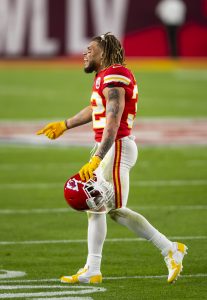 fact that they each went to safeties comes as little shock, with both starting spots needing to be filled. Mathieu spent much more time on the free agent market than his pedigree would have suggested, but he will still manage to reach the eight-figure-per-year mark with his hometown team should he maximize the pact’s incentives. The LSU alum and New Orleans native drew interest from teams like the Rams, Steelers and Eagles, but the Saints had long been considered his eventual landing spot in the buildup to his signing.
fact that they each went to safeties comes as little shock, with both starting spots needing to be filled. Mathieu spent much more time on the free agent market than his pedigree would have suggested, but he will still manage to reach the eight-figure-per-year mark with his hometown team should he maximize the pact’s incentives. The LSU alum and New Orleans native drew interest from teams like the Rams, Steelers and Eagles, but the Saints had long been considered his eventual landing spot in the buildup to his signing.
During a highly productive three-year stint in Kansas City, Mathieu increased his Pro Bowl and All-Pro appearance totals twice each, and was a key member (both in terms of on-the-field effectiveness as well as leadership and communication) of their Super Bowl LIV-winning team. The Chiefs declined to offer the 30-year-old a new deal, however, turning to the younger Justin Reid in free agency. The Honey Badger’s consistent ball production and PFF grades during recent years point to a fall-off being unlikely during at least the early part of the contract, meaning that the backend of the Saints’ defense could be in line for more of what Kansas City’s has enjoyed during its run of AFC dominance.
Maye comes with more concerns from an availability standpoint but should give New Orleans a great deal of versatility and playmaking in the secondary. Ending his Jets tenure on the franchise tag, the 29-year-old was limited to just six games last season due to a torn Achilles. It was widely assumed that the injury – along with legal troubles, which may already be an issue in New Orleans – would mark the end of his time in New York, but a new contract was deemed a possibility at the onset of free agency. Ultimately, though, the Jets pivoted to Jordan Whitehead, leaving the Saints with a new tandem at safety which has the potential to prove the team’s investment in them worthwhile.
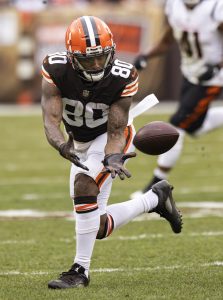 Just as was the case with Mathieu, the Landry signing represented a homecoming. The LSU product’s deal also features incentives which can double its value; even in that event, the contract would fall well short of the $20MM per year he was once reported to be seeking. Still, the one-year pact gives Landry a chance to move forward from an injury-riddled final year with the Browns, re-establishing his worth as a dependable slot receiver. He will face notable competition for targets, but the former Pro Bowler (if healthy) could be in line for a productive season, and a resultant financial windfall.
Just as was the case with Mathieu, the Landry signing represented a homecoming. The LSU product’s deal also features incentives which can double its value; even in that event, the contract would fall well short of the $20MM per year he was once reported to be seeking. Still, the one-year pact gives Landry a chance to move forward from an injury-riddled final year with the Browns, re-establishing his worth as a dependable slot receiver. He will face notable competition for targets, but the former Pro Bowler (if healthy) could be in line for a productive season, and a resultant financial windfall.
Given their lack of established pass catchers aside from Amari Cooper, a reunion with the Browns was considered a possibility for Landry, even after they released him. Only in the days before the 29-year-old signed with the Saints did it become clear that Cleveland was fully committed to other options. Landry brings significant pedigree and a veteran presence to what was one of the league’s worst position groups last season, and could be a central figure in its 2022 ascension.
If things go according to plan, Dalton will not play nearly as large of a role as Landry despite the similarities in their contracts. Should Winston suffer a setback in his recovery, or find himself sidelined again, the 34-year-old would give the Saints a more capable insurance option than most. Bouncing around to three teams in as many seasons, the longtime Bengals starter has seen significant playing time since becoming a backup. His performances and win-loss record over that span suggests the team would be far better equipped to handle a repeat of last season’s injury troubles than the 2021 version.
Re-signings:
- Jameis Winston, QB. Two years, $28MM. $15.2MM guaranteed.
- P.J. Williams, S. One year, $2.54MM. $2.54MM guaranteed.
- Tre’Quan Smith, WR. Two years, $6MM. $2MM guaranteed.
- Carl Granderson, DE. Two years, $5.27MM. $240K guaranteed.
- Dwayne Washington, RB. One year, $1.19MM. $53K guaranteed.
- Ethan Greenidge, T. One year, $1MM. $100K guaranteed.
- Albert Huggins, DT. One year, $895K.
- Juwan Johnson, TE. One year, $895K.
- Christian Ringo, DL (signed to practice squad 9/1)
Winston’s injury and free agent status left the Saints with a complicated situation at the quarterback position. The fact that Taysom Hill permanently transitioned to tight end, and the team’s cap challenges seemingly left them without many options. One of those, of course, was simply a reunion with Winston. The team’s 5-2 record with him as the starter prior to his ACL tear was due, in part, to his impressive 14:3 touchdown-to-interception ratio. To little surprise, then, Loomis confirmed in before the onset of free agency that a third contract with the former No. 1 pick was a distinct possibility. 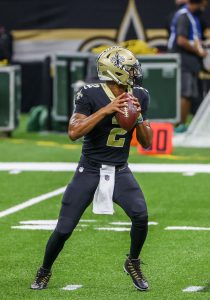
However, the Saints carved out enough cap space to enter the QB market which dominated the NFL landscape this spring. That made them a player for Deshaun Watson. Barely one week after the news of a Winston reunion still being on the table, New Orleans made Houston an offer to acquire the embattled signal-caller. The Saints were joined in pursuing Watson by the Panthers and Falcons, and it seemed all but assured at one point that he was headed somewhere in the NFC South. The Browns emerged as the team willing to make the biggest contract offer – a five-year, $230MM fully guaranteed contract – to move the Saints from a reported Watson finalist to a team needing to pivot back to Winston.
The 28-year-old has made steady progress rehabbing his knee throughout the offseason. Winston’s appearance in the team’s preseason finale was another encouraging sign that he will be fully recovered in time for the 2022 campaign. Smith will also return as a familiar face in the passing game, though the former third-round pick’s underwhelming performance with an increased role last season led, no doubt, to his modest deal and the team’s emphasis on upgrading the WR corps.
On defense, Williams and Granderson are each in line to continue playing important rotational roles. The former has proven himself to be a versatile member of the secondary by filling a number of positions, while the latter earned a significantly more lucrative deal than his ERFA status required. Once again facing a limited budget for re-signings, the Saints keeping both in the fold at their respective rates could prove fruitful if they are forced into starting roles.
Read more
Notable losses:
- Kwon Alexander, LB
- Kiko Alonso, LB (retired)
- Terron Armstead, T
- Caleb Benenoch, OL
- Blake Bortles, QB (released)
- James Carpenter, OL
- Ken Crawley, CB
- Jalen Dalton, DL
- Garrett Griffin, TE
- Jeff Heath, S
- Jalyn Holmes, DL
- Lil’Jordan Humphrey, WR
- Malcolm Jenkins, S (retired)
- Brett Maher, K
- Jordan Miller, CB
- Jordan Mills, T
- Ty Montgomery, RB
- Craig Robertson, LB (retired)
- Trevor Siemian, QB
- Kenny Stills, WR
- Marcus Williams, S
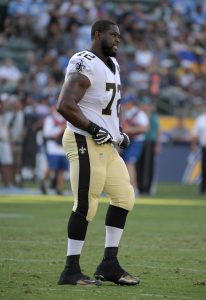 Armstead was rightfully ranked as one of, if not the top free agents in this year’s class; left tackles of his caliber rarely hit the open market. Given the Saints’ financial situation, though, it was inevitable that a new deal would not be viable for the three-time Pro Bowler. His age (31) and injury history (including nine missed games in 2021), on the other hand, left New Orleans in need of a replacement at some point in the short- to intermediate-term future anyway.
Armstead was rightfully ranked as one of, if not the top free agents in this year’s class; left tackles of his caliber rarely hit the open market. Given the Saints’ financial situation, though, it was inevitable that a new deal would not be viable for the three-time Pro Bowler. His age (31) and injury history (including nine missed games in 2021), on the other hand, left New Orleans in need of a replacement at some point in the short- to intermediate-term future anyway.
Miami quickly emerged as a team actively pursuing Armstead and represented a logical destination when he ultimately signed there. The $75MM commitment made by the Dolphins – including substantial guarantees – demonstrated not only their edge over almost every other team in terms of spending power, but their desperate need to upgrade up front. Armstead will give the Dolphins a true Laremy Tunsil successor and help solidify what was arguably the league’s worst offensive line in 2021.
Williams’ departure was likewise a significant loss on defense, but one which was unsurprising. The 26-year-old played on the franchise tag last season, adding another pair of interceptions to his overall tally of 15, and setting new career-highs in terms of coverage statistics. That made him one of several benefactors of the upward safety market from this offseason, landing a $14MM-per-year contract in Baltimore. Given the Saints’ cap complications, a deal of similar value keeping him in New Orleans was simply unfeasible.
Williams’ emerging presence as one of the league’s top ball hawks will be difficult to replace, in spite of the new 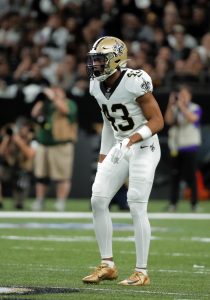 investments made at the position in free agency. Nonetheless, the shorter-term deals given to Mathieu and Maye could see the team use more differentiated looks in the secondary. The fact that their new additions carry only a slightly higher financial burden than Williams alone should also provide a cost-effective tandem on the backend, albeit one once again lacking one of the team’s most accomplished veterans.
investments made at the position in free agency. Nonetheless, the shorter-term deals given to Mathieu and Maye could see the team use more differentiated looks in the secondary. The fact that their new additions carry only a slightly higher financial burden than Williams alone should also provide a cost-effective tandem on the backend, albeit one once again lacking one of the team’s most accomplished veterans.
Jenkins’ retirement marked the second time he left the Saints without his consistent playmaking. Upon his announcement, new head coach Dennis Allen echoed the sentiments expressed by his predecessor, Sean Payton, with respect to Jenkins’ contributions to the franchise. The three-time Pro Bowler remained an every-down starter in his second stint in New Orleans, providing similar production to his five years spent with the team to begin his career and the six spent with the Eagles. Mathieu represents one of the few replacement options capable of filling the 34-year-old’s leadership void.
Alexander proved to be an effective trade acquisition midway through the 2020 campaign. A starter for 15 of the 19 games he appeared in with the Saints, his deal with the Jets proves the degree to which his sizable 49ers contract was a mistake. It also leaves New Orleans with a hole in its linebacking corps with respect to Demario Davis compliments, however, especially given their short-lived reunion with Alonso.
Draft picks:
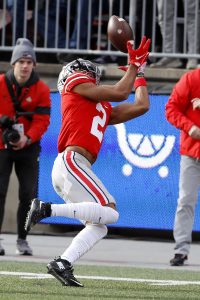 Their aggressiveness in the buildup to Olave’s and Penning’s selections speak to how the Saints held the pair in high regard. In the former’s case, a trade up of five spots made him the third wideout off the board. Olave never put up the kind of numbers one might expect given that draft slot, though his final season with the Buckeyes was his most productive. Olave also led the team in receiving during the two years prior and was a consistent contributor in an offense featuring significant competition for targets.
Their aggressiveness in the buildup to Olave’s and Penning’s selections speak to how the Saints held the pair in high regard. In the former’s case, a trade up of five spots made him the third wideout off the board. Olave never put up the kind of numbers one might expect given that draft slot, though his final season with the Buckeyes was his most productive. Olave also led the team in receiving during the two years prior and was a consistent contributor in an offense featuring significant competition for targets.
At 6-foot-1, 190 pounds, Olave can operate both outside and in the slot, something which should increase his effectiveness particularly early on in his career. Slated to serve as a starter alongside Thomas and Landry, Olave could soon emerge as a trusted target given the long-term uncertainty surrounding the accomplished veterans. Expectations will be high considering the team’s investment in him (as opposed to a number other similarly rated pass catchers who were available), but he should be a significant contributor to the team’s passing attack for years to come.
Penning’s career path was far different than Olave’s in college. Early on, at least, the same will likely be true in the NFL. The FCS product earned an invite to the Senior Bowl with his dominant play against lower-level competition. Penning’s performance during the all-star week confirmed his status as a first-round prospect, landing him within the Saints’ range after their sizable trade with the Eagles which was finalized three weeks before the draft. 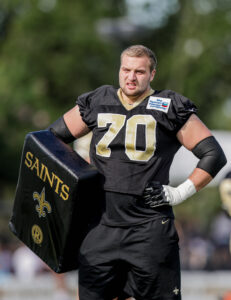
That swap gave New Orleans the extra first-rounder necessary to land Penning (albeit at the expense of its top choice next year and a second-rounder in 2024). The 6-7, 320-pounder established a reputation for himself in the buildup to the draft for his mean streak and physicality. Those qualities give him upside in the run game in particular, but his need for technical refinement left veteran James Hurst as the expected starter to begin Penning’s career. That will be the case out of necessity now, after the latter suffered a foot injury which will keep him sidelined indefinitely to start the campaign. Still, Penning has the upside to replace Armstead as a franchise-caliber blindside blocker should he reach his potential.
Taylor adds another layer of versatility to the Saints’ secondary. After racking up a career-best 60 tackles in his final college season, he showed an ability to play in the slot during training camp. At 6-foot, 193 pounds, the former Volunteer could also line up on the perimeter, giving New Orleans plenty of options in that regard to pair with Marshon Lattimore. Taylor can provide the team with years of cost-controlled play on the backend – along with 2021 third-rounder Paulson Adebo – something which will help counterbalance their financial commitments to a number of veterans.
Extensions and restructures:
- Extended CB Bradley Roby with three year, $10.5MM contract
- Reworked LB Demario Davis’ deal, including one-year extension
- Restructured WR Michael Thomas’ and RT Ryan Ramczyk’s deals, creating $26.22MM in cap space
- Restructured LG Andrus Peat’s pact, converting $8MM into signing bonus and creating $6MM in cap space
- Restructured DEs Cam Jordan’s and Tanoh Kpassagnon’s contracts, creating $12.25MM in cap space
- Restructured RB Alvin Kamara’s contract, converting $10.47MM into signing bonus and creating $8.37MM in cap space
- Restructured CB Marshon Lattimore’s deal, converting $23MM into signing bonus and creating $18.45MM in cap space
- Restructured DE Marcus Davenport’s contract, converting $8.5MM into signing bonus and creating $6.8MM in cap space
- Restructured LT James Hurst and DT David Onyemata’s pacts, creating $7.02MM in cap room
- Restructured TE Taysom Hill’s, LB Demario Davis’ and S Malcolm Jenkins’ deals, creating $17.2MM in cap space
Entering the offseason roughly $75MM in the red for the second straight year, it was obvious that a slew of moves such as these would be necessary. March was dominated by the Saints’ efforts to shed 2022 cap charges, with nine of the team’s top 10 figures being affected. The goal of not only cap compliance, but also the flexibility to make a few noteworthy additions was met, though there will of course be consequences down the road.
The fact that nearly every player listed also went through this process in 2021 leaves the Saints with a number of sideways cap charges beginning in 2023. Thomas represents one such example; he will account for more than $28.2MM on New Orleans’ books next year as things stand. That would fall within the range of market value at his position, given the explosion in receiver salaries this year, should he return to his elite form this season. Signs are pointing toward that being the case, which would alleviate concerns about his long-term future from both a performance and financial perspective.
Trades:
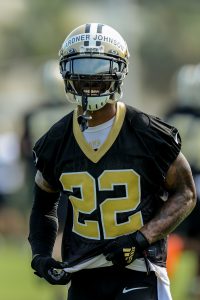 Gardner-Johnson quickly established himself as an invaluable member of the Saints’ defense. The 2019 fourth-rounder was a full-time starter for the past two seasons, proving an effective and productive slot corner. His 112 tackles, four interceptions and 20 pass deflections over that span speak to his abilities both in the run and pass game, though his NFL tenure has of course also included confrontations with teammates and opponents alike. Finances, though, are at the heart of his change of scenery.
Gardner-Johnson quickly established himself as an invaluable member of the Saints’ defense. The 2019 fourth-rounder was a full-time starter for the past two seasons, proving an effective and productive slot corner. His 112 tackles, four interceptions and 20 pass deflections over that span speak to his abilities both in the run and pass game, though his NFL tenure has of course also included confrontations with teammates and opponents alike. Finances, though, are at the heart of his change of scenery.
The Florida alum skipped voluntary workouts in the spring and joined a number of extension-eligible players by staging hold-ins during training camp. The parties remained far apart in contract talks, leading to the team’s decision to move on via trade rather than seeing the 24-year-old depart in free agency next March.
New Orleans will have a number of replacement options given its stable of hybrid defenders, though the move represents a notable loss for the unit. Gardner-Johnson, meanwhile, will reportedly switch to safety in Philadelphia, something which could boost his market value while filling a void in the Eagles’ secondary.
Other:
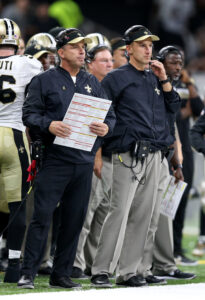 A Saints Watson acquisition likely would have been the only story which could outrank that of Payton’s departure in terms of significance. The 58-year-old was instrumental in the franchise’s Super Bowl title and teamed with Brees to lead the team to 13 consecutive seasons (discounting the 2012 campaign, when he was suspended) with a top-10 total offense. The Saints’ performance in that department slipped over the past two years, but the new Fox broadcaster will be sorely missed as one of the league’s top offensive minds.
A Saints Watson acquisition likely would have been the only story which could outrank that of Payton’s departure in terms of significance. The 58-year-old was instrumental in the franchise’s Super Bowl title and teamed with Brees to lead the team to 13 consecutive seasons (discounting the 2012 campaign, when he was suspended) with a top-10 total offense. The Saints’ performance in that department slipped over the past two years, but the new Fox broadcaster will be sorely missed as one of the league’s top offensive minds.
Payton currently sits in a tie for 21st on the all-time HC wins list and could resume has ascent starting in 2023. He has made clear his desire to coach again and would no doubt have a number of suitors upon his return. Among the teams most frequently connected to him are the Cowboys and Dolphins; a deal sending him to the latter was rumored to be in place as a result of the tampering scandal for which Miami has since been severely disciplined. In any event, Payton’s name will be central to next year’s coaching cycle.
Allen, 49, will be a notably different coach leading the staff, though his extensive history with the franchise should ensure a greater deal of stability than most coaching changes. The team’s defensive coordinator since 2015, Allen was quickly named as the favorite to succeed Payton. The appointment will mark his first HC gig since a Raiders tenure which lasted less than three seasons and resulted in an 8-28 record. Far more will be expected this time around, and his continued work with the defense should give the unit an opportunity to remain in the top five in scoring for a fourth consecutive season.
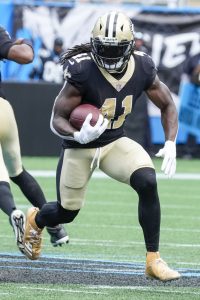 Internal promotions will keep the defensive staff intact with Richard and Nielson. The former, like Allen, has DC experience (with the Seahawks). Richard was a candidate to head elsewhere under the same title during the coaching cycle. Nielsen is receiving a new, significant role for the second consecutive year; he was named assistant head coach in 2021. That title has now been given to special teams coordinator Darren Rizzi, further illustrating the by-committee approach the Saints are employing to replace Payton.
Internal promotions will keep the defensive staff intact with Richard and Nielson. The former, like Allen, has DC experience (with the Seahawks). Richard was a candidate to head elsewhere under the same title during the coaching cycle. Nielsen is receiving a new, significant role for the second consecutive year; he was named assistant head coach in 2021. That title has now been given to special teams coordinator Darren Rizzi, further illustrating the by-committee approach the Saints are employing to replace Payton.
Carmichael’s expected role changed in a matter of days given the return of Marrone to the staff. The NFL’s longest-tenured offensive coordinator, Carmichael was thought to be moving to a different position – even reportedly requesting to do so – on the team’s staff while the coach he succeeded as OC in 2009 was brought back into the NFL. Instead, the 50-year-old will guide the offense on gamedays, something he has yet to do on a full-time basis. Marrone’s past with the Saints, along with his HC stints in Buffalo and Jacksonville, will give the unit another experienced voice as the team enters its first campaign without at least one of Payton or Brees since 2005.
A violent altercation in Las Vegas during Pro Bowl weekend led to Kamara facing battery-related charges, leaving him at risk of suspension. Delays in the court proceedings regarding his case have opened the door to the five-time Pro Bowler being eligible to at least start the campaign without issue; the same may remain true until 2023. In spite of the team’s upgraded pass-catching corps, Kamara still projects as the focal point of the offense, so any absence would be a significant blow to their playoff chances.
Top 10 cap charges for 2022:
- Michael Thomas, WR: $13.05MM
- Cam Jordan, DE: $12.43MM
- Marshon Lattimore, CB: $9MM
- Ryan Ramczyk, T: $8.48MM
- Andrus Peat, G: $7.67MM
- David Onyemata, DT: $6.75MM
- Alvin Kamara, RB: $6.13MM
- Demario Davis, LB: $5.9MM
- Wil Lutz, K: $5.57MM
- Taysom Hill, TE: $5.13MM
In spite of the numerous challenges faced at the start of the offseason, along with more than $33MM in dead money, the Saints are now mid-pack in terms of 2022 cap space. Things are set to be much different next year, however, as the team is a projected league-worst $58MM over the cap. Every name among their top 10 2022 cap charges is under contract for the 2023 campaign, but restructures have led to major spikes in their respective financial burdens on future rosters. Loomis will need to be creative once again next spring to keep the team competitive.
Life without Payton will require adjustments, just as the 2021 season did in Brees’ absence. Familiar faces on the sidelines should nevertheless help a veteran-laden team incorporate the new pieces to the puzzle which give this roster significant upside, particularly in the passing game on both sides of the ball. In an NFC which – with a few exceptions – is lacking in heavyweights, the Saints can reasonably be expected to compete for a playoff spot. If the offense takes the step forward it is capable of doing on paper, a postseason run should not be out of the question.
By Sam Robinson |
at September 5, 2022 8:00 pm
The runaway headline kingpins of the 2022 offseason, the Browns will enter the season with a fully revamped quarterback room and a much higher profile. If everything goes according to plan, the first part of this equation would give Cleveland a franchise-caliber passer to fill a void that has existed for decades.
Of course, little has gone according to plan since the Browns traded for and extended Deshaun Watson. And the cost of that move rises exponentially after 2022. After one of the most controversial transactions in NFL history, this is the franchise’s identity. And it will take a bit before the on-field chapters of this much-discussed saga begin.
Trades:
Browns vilification should not come merely for acquiring Watson via trade. They joined three other teams — the Falcons, Panthers and Saints — in being prepared to pay the historic cost. Teams beyond the four finalists pursued Watson as well. If it had just been the trade the Browns made, the blowback probably does not reach the place it did. Cleveland’s 11th-hour contract proposal to outflank NFC South destinations Watson preferred, along with the comments from the key principals involved, led this process to a messy place.
 Watson signed a $39MM-per-year deal with the Texans in August 2020. Although that contract seems like it was authorized a decade ago, its extension years were set to begin in 2022. Watson played one season on what was a top-five QB contract over its first two years. Amid the early parts of a scandal that saw criminal and civil cases come from more than two dozen women accusing Watson of sexual misconduct and/or sexual assault during massage therapy sessions, the Texans then made him a 17-game healthy scratch. Despite Watson’s turmoil, quarterbacks of this caliber squarely in their primes are almost never available. Teams acted accordingly, and the Browns one-upped the field.
Watson signed a $39MM-per-year deal with the Texans in August 2020. Although that contract seems like it was authorized a decade ago, its extension years were set to begin in 2022. Watson played one season on what was a top-five QB contract over its first two years. Amid the early parts of a scandal that saw criminal and civil cases come from more than two dozen women accusing Watson of sexual misconduct and/or sexual assault during massage therapy sessions, the Texans then made him a 17-game healthy scratch. Despite Watson’s turmoil, quarterbacks of this caliber squarely in their primes are almost never available. Teams acted accordingly, and the Browns one-upped the field.
It is unclear what the NFC South franchises were offering, money-wise, during the March sweepstakes. But the Browns’ decision to authorize the five-year, $230MM fully guaranteed deal to a player in Watson’s position has made Jimmy and Dee Haslam personas non grata among NFL ownership while producing endless criticism of the franchise. Four years remained on Watson’s Texans-constructed deal. His third NFL contract is the most player-friendly pact in league history. Even after Russell Wilson‘s $49MM-per-year Broncos deal came to pass, Watson’s deal still tops the league in fully guaranteed money by more than $100MM.
Cleveland will not have its starter available until Week 13. Watson’s suspension, after an NFL appeal and settlement with the NFLPA that avoided a court battle, was longer than the one the Browns envisioned upon acquiring him but not as lengthy as the league initially sought. This will leave a roster that has some strong position groups vulnerable during the Watson contract’s most conducive year to winning.
The league-minimum salary the Browns arranged — to the NFL and the other teams’ dismay, leading to the $5MM fine — to minimize Watson’s financial punishment created a $9.4MM 2022 cap number. Loading up a playoff-caliber roster around that, regardless of the rust the former first-round pick might show, made sense. But Watson’s first full season will come when his cap hit spikes to never-before-seen territory. Watson’s cap numbers from 2023-26: $54.99MM. The NFL has never seen even a $45MM cap hit. No Super Bowl champion has carried a quarterback cap figure north of $25MM. Building around Watson’s salaries will be a challenge for Browns GM Andrew Berry, whom Jimmy Haslam said concocted the idea for the fully guaranteed deal.
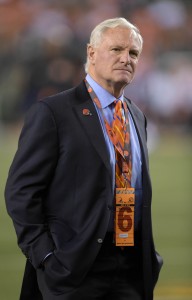 The ire coming at the Browns from most of the NFL universe aside, Watson is probably still a top-10 quarterback or close to it. His three full seasons produced 13th-, seventh- and 12th-place QBR rankings. The Browns, who passed on the Clemson star two regimes ago by trading out of the No. 12 slot to send him to Houston, will upgrade from Baker Mayfield. Watson, 27 next week, led the NFL in passing yards two years ago and lifted flawed Texans teams to back-to-back playoff brackets.
The ire coming at the Browns from most of the NFL universe aside, Watson is probably still a top-10 quarterback or close to it. His three full seasons produced 13th-, seventh- and 12th-place QBR rankings. The Browns, who passed on the Clemson star two regimes ago by trading out of the No. 12 slot to send him to Houston, will upgrade from Baker Mayfield. Watson, 27 next week, led the NFL in passing yards two years ago and lifted flawed Texans teams to back-to-back playoff brackets.
But the dual-threat talent will have missed 28 games since his last Texans appearance. And the vitriol directed at the quarterback and the team — largely for the lack of remorse Watson has shown, cresting with a defiant press conference that contradicted the language that appeared in his official post-settlement statement — may last a while. While two grand juries did not bring forth charges, NFL disciplinary officer Sue Robinson ruled Watson committed nonviolent sexual assault and engaged in predatory behavior. He settled suits with 23 women. The Browns are banking on the waves of negative PR eventually washing away. But Watson being rewarded with a lavish outlier contract and residing as the Browns’ new cornerstone player will likely tie this organization to the scandal for the foreseeable future.
The emergences of Joe Burrow and Justin Herbert and Wilson’s AFC arrival will also increase the degree of difficulty for the Watson-era Browns. Considering the extensions Wilson and Kyler Murray signed, it would shock if Burrow or Herbert landed fully guaranteed deals. That will make Bengals and Chargers’ paths to building contenders around those eventual extensions a bit easier. The Browns trading their 2023 and ’24 first-round picks creates more hurdles and continues an interesting pattern with Watson-led teams. The Texans were without first-rounders in 2018 (via the first Watson trade) and from 2020-21 (the Laremy Tunsil deal) during their star QB’s stay. As the Browns aim to construct a championship team around a record-setting QB contract, this will be one of the more interesting roster-building experiments in NFL history.
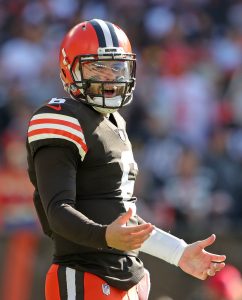 Mayfield’s on-field work in Cleveland produced wild inconsistency, leading to the franchise’s desperate play for Watson. The Browns’ radical trade/extension sequence ended Mayfield’s four-year Cleveland tenure, though the former playoff starter needed to wait almost three months for the cord cut. Panthers GM Scott Fitterer said his team’s Mayfield offer was better during the draft, but the Browns were not ready to pay as much of the quarterback’s contract as they ended up paying. Cleveland took on $10.5MM in dead money to collect a conditional 2024 Day 3 pick.
Mayfield’s on-field work in Cleveland produced wild inconsistency, leading to the franchise’s desperate play for Watson. The Browns’ radical trade/extension sequence ended Mayfield’s four-year Cleveland tenure, though the former playoff starter needed to wait almost three months for the cord cut. Panthers GM Scott Fitterer said his team’s Mayfield offer was better during the draft, but the Browns were not ready to pay as much of the quarterback’s contract as they ended up paying. Cleveland took on $10.5MM in dead money to collect a conditional 2024 Day 3 pick.
Mayfield’s highs did generate considerable optimism. His second-place Offensive Rookie of the Year finish delivered promise ahead of 2019, but that led to the decision to promote Freddie Kitchens, who oversaw the Heisman winner’s ensuing nosedive. Stefanski restored Mayfield, who thrived behind a top-tier offensive line and one of the 21st century’s best backfield duos. The Browns snapped an 18-year playoff drought and had the eventual AFC champion Chiefs on the ropes. But the perpetually clunky Mayfield-Odell Beckham Jr. fit led to a 2021 fissure. Mayfield playing through his shoulder injury ended up throwing him off the extension track and sealed his fate with the Browns.
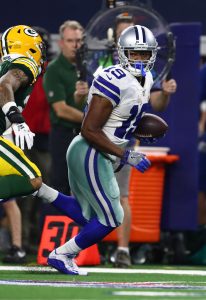 Still, the juxtaposition of the “adult in the room” comment regarding Mayfield and the Watson acquisition displayed an alarming lack of self-awareness, and the Browns’ instability under the Haslams (six GMs, six full-time HCs since the owners’ 2012 arrival, 52-108-1 record) does not instill much confidence in their decision-making. Berry and Stefanski have thus far proven to be good hires. Berry not forcing the issue with a 2021 Mayfield extension proved to be the right call. Both will be thrust into a new spotlight, with Stefanski going from 2020 Coach of the Year to a leader that will be forced to keep answering Watson-related questions and make his offense work with Jacoby Brissett for 11 games.
Still, the juxtaposition of the “adult in the room” comment regarding Mayfield and the Watson acquisition displayed an alarming lack of self-awareness, and the Browns’ instability under the Haslams (six GMs, six full-time HCs since the owners’ 2012 arrival, 52-108-1 record) does not instill much confidence in their decision-making. Berry and Stefanski have thus far proven to be good hires. Berry not forcing the issue with a 2021 Mayfield extension proved to be the right call. Both will be thrust into a new spotlight, with Stefanski going from 2020 Coach of the Year to a leader that will be forced to keep answering Watson-related questions and make his offense work with Jacoby Brissett for 11 games.
The Browns did well to acquire Cooper for two Day 3 picks. Trading for Cooper just before the receiver dam broke, the timing here worked out nicely for the Browns. Cooper’s $20MM-per-year contract looks much friendlier than it did in early March. He is signed through 2024; the 2023 and ’24 salaries are nonguaranteed. The former top-five pick’s contract ranked as the receiver market’s third-richest at the time of the trade. It now sits in a tie for 12th.
Cooper’s deal will take the place of Beckham’s atop the Browns’ skill-position payroll. Although Cleveland’s OBJ swap bombed, the team will try again with a player carrying a longer sample size of production — albeit with a lower ceiling than Beckham brought in 2019. Cooper, 28, is a four-time Pro Bowler and one of the NFL’s best route runners. He turned around a fading 2018 Cowboys season, rebounding from the slump that plagued his final Raiders months. Not having Watson for much of this season does run the risk of wasting a prime Cooper year, with 2023 being Year 9 for the ex-Alabama star. But the Browns’ Brissett-run offense will depend on Cooper, with question marks at every other pass-catching spot.
Free agency additions:
- Jacoby Brissett, QB. One year, $4.65MM. $4.5MM guaranteed.
- Jakeem Grant, WR/KR/PR. Three years, $10MM. $3.04MM guaranteed.
- Taven Bryan, DT. One year, $4MM. $3.25MM guaranteed.
- Corey Bojorquez, P. Two years, $3.38MM. $1.5MM guaranteed.
- Ethan Pocic, OL. One year, $1.19MM. $1.05MM guaranteed.
- Stephen Weatherly, DE. One year, $1.2MM. $650K guaranteed.
- Joshua Dobbs, QB. One year, $1.19MM.
- Joe Haeg, OL.
- Jesse James, TE.
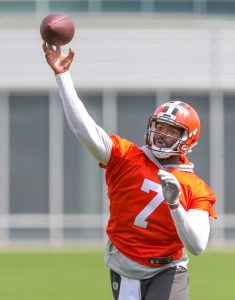 This is oddly the most time Brissett has had to prepare for a QB1 season. The Colts acquired him from the Patriots in September 2017, as Andrew Luck‘s mysterious shoulder injury led to a full-season absence. Brissett started 15 games that year. In 2019, Brissett became the Colts’ belated answer after Luck’s shocking late-summer retirement. With the Browns knowing Watson would be suspended, Stefanski has had months to prepare his fill-in starter.
This is oddly the most time Brissett has had to prepare for a QB1 season. The Colts acquired him from the Patriots in September 2017, as Andrew Luck‘s mysterious shoulder injury led to a full-season absence. Brissett started 15 games that year. In 2019, Brissett became the Colts’ belated answer after Luck’s shocking late-summer retirement. With the Browns knowing Watson would be suspended, Stefanski has had months to prepare his fill-in starter.
The Browns chose Brissett, 29, over their incumbent backup (Keenum) who had been with Stefanski for three seasons. They also passed on parting with a draft pick for Jimmy Garoppolo. Selecting this path probably deserved more attention, but the Watson drama understandably overshadowed the Brissett decision. If Trey Lance starts the season off well and Brissett does not, would the Browns circle back to Garoppolo before the Nov. 1 deadline?
Playing a careful style, Brissett fared better in 2019 than he did with a less talented Colts squad two years prior. He threw 18 touchdown passes and six interceptions during a 7-9 Indianapolis season. Last year, however, Brissett averaged an eye-opening 5.7 yards per attempt as the Dolphins’ offense — save for Jaylen Waddle, who still showed the dangers of PPR scoring during much of his time with Brissett — sputtered. That said, Pro Football Focus graded Miami’s O-line as the NFL’s worst last season. While a hole now exists at center, the Browns have one of the best. Their Nick Chubb–Kareem Hunt (feat. D’Ernest Johnson) ground game will also provide Brissett with far more help than Miami’s 30th-ranked rushing attack did last season.
The Brissett-Dobbs depth chart could sink the Browns’ season, with the Watson ban forcing him to miss midseason tilts against the Chargers, Patriots, Bengals, Ravens, Dolphins, Bills and Buccaneers. Dobbs has attempted 17 passes in five seasons. But Brissett has 37 career starts, creating possibly a higher floor than what a downtrodden Mayfield offered in 2021.
Read more
Pocic is the next man up after the Tretter release and Nick Harris season-ending knee injury; the ex-Seahawk has made 24 starts since 2020. PFF liked Pocic’s 2021 work better than his 2020 performance, slotting him 15th among centers. He has some acclaimed blockers alongside him. Grant’s Achilles tear represents a bad break for the electric return man. The former Dolphins and Bears standout, a 2021 Pro Bowler, could have aided Brissett and Co. in field position.
Re-signings:
Clowney, 29, said Watson’s decision to waive his no-trade clause for Cleveland played a big role in convincing him to return. He had prepared to sign with the Falcons if Watson had chosen them. Although Clowney and Watson will not share the field much this season, the carrot of a full season from the ex-Texans quarterback in 2023 could convince Clowney to come back again. The former No. 1 overall pick is now in Year 9; he has yet to land a long-term veteran deal.
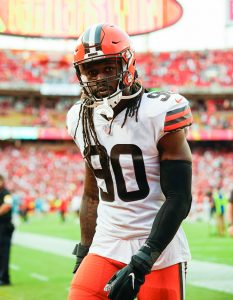 The ex-South Carolina super-prospect went from his rookie salaries to the fifth-year option to being a tag-and-trade player to one-year pacts with the Titans and Browns. Clowney’s health history has prevented the kind of lucrative multiyear guarantees that have gone to players of his ilk, but he is not exactly lacking in funds. This season will bump him north of $80MM in career earnings. Clowney, who combined for three sacks in Seattle and Tennessee, ripped off nine opposite Myles Garrett last season. With a suspect defensive tackle depth chart, the Browns need the versatile defender to repeat that performance.
The ex-South Carolina super-prospect went from his rookie salaries to the fifth-year option to being a tag-and-trade player to one-year pacts with the Titans and Browns. Clowney’s health history has prevented the kind of lucrative multiyear guarantees that have gone to players of his ilk, but he is not exactly lacking in funds. This season will bump him north of $80MM in career earnings. Clowney, who combined for three sacks in Seattle and Tennessee, ripped off nine opposite Myles Garrett last season. With a suspect defensive tackle depth chart, the Browns need the versatile defender to repeat that performance.
PFF graded Walker as a top-20 off-ball linebacker last season, and the Browns will keep this year-to-year partnership going. The former Shaquille Leonard Colts sidekick will team with Jeremiah Owusu-Koramoah to form one of the NFL’s better three-down linebacking tandems. With the exception of its defensive tackle spots, the Browns’ defense is sound on all three levels.
Harrison coming back brings experience, at least, and Browns DC Joe Woods plans to deploy another healthy dose of three-safety looks. Though, Harrison was charged with allowing six touchdown passes last season. The former Jaguars starter does have 40 starts under his belt.
Hubbard supplies solid depth up front. He has enjoyed an interesting Browns career. Signed to be the team’s right tackle in 2018, Hubbard could not stick at that spot but continued to stay on the same page with the Berry regime, which reworked the John Dorsey-era signing’s deal in 2020. Despite a September triceps injury that knocked Hubbard out for the season, the ex-Steelers starter is back. With starter Jack Conklin finishing up a recovery from one of the toughest injuries to surmount — a patellar tendon tear — and uncertain to start the season on time, players like Hubbard, Haeg and rookie-contract backup James Hudson come into focus.
Notable losses:
- Dustin Colquitt, P
- Rashard Higgins, WR
- Austin Hooper, TE (released)
- Malik Jackson, DT
- Andy Janovich, FB (released)
- Blake Hance, OL (waived)
- Jarvis Landry, WR (released)
- Malik McDowell, DT (nontendered as ERFA)
- Takk McKinley, DE
- Nick Mullens, QB
- Malcolm Smith, LB
- M.J. Stewart, S
- Ryan Switzer, WR (retired)
- J.C. Tretter, C (released, then retired)
 More consistent than Beckham, Landry became Mayfield’s go-to target during the team’s playoff run. His short-range space creation would seemingly have meshed with Brissett’s style, and while the Browns were connected to bringing Landry back for a fifth season even after cutting him, the sides parted ways. Landry was better in Miami than he was in Cleveland, but the ex-Dolphins slot unveiled more dimensions to his game with the Browns and added two more Pro Bowls to his resume.
More consistent than Beckham, Landry became Mayfield’s go-to target during the team’s playoff run. His short-range space creation would seemingly have meshed with Brissett’s style, and while the Browns were connected to bringing Landry back for a fifth season even after cutting him, the sides parted ways. Landry was better in Miami than he was in Cleveland, but the ex-Dolphins slot unveiled more dimensions to his game with the Browns and added two more Pro Bowls to his resume.
Landry’s Saints signing stands to help Jameis Winston reacclimate after his ACL tear; Cleveland has pivoted to younger pass catchers.
Signed during Berry’s stay under former front office boss Sashi Brown, Tretter more than delivered on that 2017 commitment. The Packers draftee became one of the NFL’s top centers with the Browns, never missing a game due to injury in five seasons. The ironman blocker contributed to Chubb’s rise and formed perhaps the NFL’s best interior O-line troika in between Joel Bitonio and Wyatt Teller. Tretter, 31, became the NFLPA president during his Browns tenure. He said that job played a part in his earlier-than-expected retirement. The Browns have some big shoes to fill here.
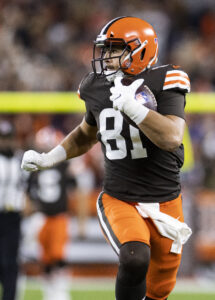 The Browns’ D-tackle Maliks did not catch on anywhere else. Jackson, a starter on the Broncos’ dominant 2015 Super Bowl defense and part of the Jaguars’ “Sacksonville” D-line armada, only registered a half-sack as a Brown. The Browns ditched McDowell after one season. The former Seahawks third-round pick was arrested in January, being accused of exposing himself in public, resisting arrest with violence, and battery on a law enforcement officer. PFF rated neither Jackson nor McDowell inside the top 90 at D-tackle last season. Their exits do cloud the position, with ex-Jackson Jacksonville teammate Taven Bryan in line to start despite underperforming as a Jags first-rounder. Third-year cog Jordan Elliott (four career starts) will move from rotation player to first-stringer.
The Browns’ D-tackle Maliks did not catch on anywhere else. Jackson, a starter on the Broncos’ dominant 2015 Super Bowl defense and part of the Jaguars’ “Sacksonville” D-line armada, only registered a half-sack as a Brown. The Browns ditched McDowell after one season. The former Seahawks third-round pick was arrested in January, being accused of exposing himself in public, resisting arrest with violence, and battery on a law enforcement officer. PFF rated neither Jackson nor McDowell inside the top 90 at D-tackle last season. Their exits do cloud the position, with ex-Jackson Jacksonville teammate Taven Bryan in line to start despite underperforming as a Jags first-rounder. Third-year cog Jordan Elliott (four career starts) will move from rotation player to first-stringer.
Hooper’s designation as a post-June 1 cut created $9.5MM in cap space. The team currently leads the league — by a substantial margin — with $38MM-plus in cap space. The Browns gave Hooper a then-tight end record $10.5MM-per-year deal in 2020, but the ex-Falcon never lived up to it. Despite a rumor connecting the parties, the Browns are not believed to have shown interest in using some of that cap room on Ndamukong Suh. Given what Watson’s contract will do to the Browns’ payroll in 2023, it makes sense for the team to roll over as much cap space from 2022 as possible.
Draft:
Partners on two Watson trades and the Brock Osweiler NBA-style salary dump, the Browns and Texans linked up on another swap that provided more Day 2 capital for Cleveland. Moving down 24 spots to give Houston John Metchie draft real estate, Cleveland nabbed a new slot cornerback and a few rookies that could be asked to contribute immediately. After four years of Mayfield’s rookie deal allowed the Browns to add veterans, the Watson-era payroll will require Berry and Co. to hit on Day 2 draft picks.
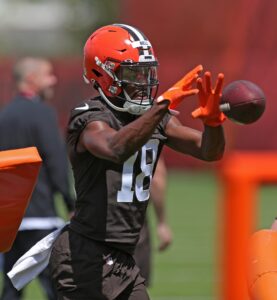 A slot cornerback option, Emerson — whose arrival sent Troy Hill back to Los Angeles — will fill in behind the Browns’ experienced Denzel Ward–Greg Newsome–Greedy Williams trio. Wright will be expected to work in behind Garrett and Clowney. Winfrey and Bell may have clearer avenues to starting gigs, due to the uncertainty at their respective positions.
A slot cornerback option, Emerson — whose arrival sent Troy Hill back to Los Angeles — will fill in behind the Browns’ experienced Denzel Ward–Greg Newsome–Greedy Williams trio. Wright will be expected to work in behind Garrett and Clowney. Winfrey and Bell may have clearer avenues to starting gigs, due to the uncertainty at their respective positions.
A Rondale Moore teammate at Purdue, Bell was the steadier presence — due to Moore’s injury trouble and early West Lafayette exit — and dropped a 1,286-yard season and earned an All-American nod in his Boilermakers finale. The 205-pound target may have a bigger role than some first- or second-round receiver draftees, being set to play alongside Cooper and Donovan Peoples-Jones. Bell overcame an offseason foot stress fracture to secure this standing.
The Browns used a different primary kicker in each of the past eight seasons. The team was interested in standout Bengals rookie Evan McPherson last year and made sure to land its kicker on Day 3 this time around. York is the highest-drafted kicker since the Buccaneers’ Roberto Aguayo second-round selection six years ago. This will be a weather transition for York, a Dallas-area native who spent three years in Baton Rouge.
Extensions and restructures:
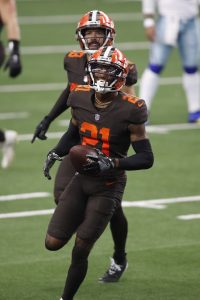 Extension agreements rounded out Cleveland’s busy offseason. The other of Dorsey’s 2018 top-five picks, Ward, is now signed through 2027. That proved to be the easier call. Njoku’s resume would not suggest he was in line to become one of the league’s highest-paid tight ends, but neither did Hooper’s at the time. Circumstances benefited another Browns tight end.
Extension agreements rounded out Cleveland’s busy offseason. The other of Dorsey’s 2018 top-five picks, Ward, is now signed through 2027. That proved to be the easier call. Njoku’s resume would not suggest he was in line to become one of the league’s highest-paid tight ends, but neither did Hooper’s at the time. Circumstances benefited another Browns tight end.
After injuries and COVID-19 limited Ward during the first three years of his career, the Cleveland-area native put together a strong season to vault him into position for a record-setting deal. After Marlon Humphrey, Tre’Davious White and Jalen Ramsey broke the ice formation atop the cornerback market, Ward and Jaire Alexander joined Ramsey in the $20MM-per-year club. While Alexander agreed to the Packers’ style of no guarantees beyond Year 1, the Browns gave Ward a market-topping $44.5MM fully guaranteed.
The Ohio State alum setting career-best marks in terms of yards per target (5.6) and yards per completion (8.8) led PFF to tab him a top-15 corner. Ward, 25, may not quite be on Ramsey’s level, but he is the best homegrown Browns corner in ages. He and Garrett are locked in to anchor Cleveland’s 2020s defenses.
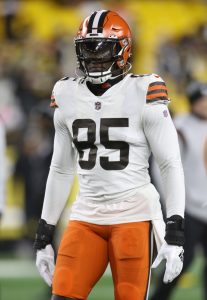 The Browns’ $13.7MM-per-year Njoku contract is a bet on the former first-rounder’s potential with Watson. Still, Njoku’s five-year sample makes it odd he bounded into position to be franchise-tagged and secure such a payout. Njoku has one 500-plus-yard season; it came back in 2018. The ex-Miami Hurricane requested a trade after the Hooper signing, then backed off and declared he sought a long-term northeast Ohio future. The Browns greenlit that and added two void years to the extension for cap purposes.
The Browns’ $13.7MM-per-year Njoku contract is a bet on the former first-rounder’s potential with Watson. Still, Njoku’s five-year sample makes it odd he bounded into position to be franchise-tagged and secure such a payout. Njoku has one 500-plus-yard season; it came back in 2018. The ex-Miami Hurricane requested a trade after the Hooper signing, then backed off and declared he sought a long-term northeast Ohio future. The Browns greenlit that and added two void years to the extension for cap purposes.
Njoku’s $17MM fully guaranteed would have given the Browns an easier time bailing on a contract for a still-unproven player, but the void years increase the dead-cap hit further down the line. Cleveland is committed to the 26-year-old pass catcher through at least 2023, with a 2024 release costing north of $13MM in dead money. The Cowboys’ negotiations with their tagged tight end (Dalton Schultz) were probably impacted by a player with inferior stats scoring a deal nearly $3MM north of the tag price and becoming the league’s fifth-highest-paid tight end.
Other:
In the time since Hunt signed his two-year, $13MM extension (September 2020), the running back market changed. Days after Hunt’s deal, the Vikings and Saints gave their top backs (Dalvin Cook, Alvin Kamara) big-ticket extensions. The Packers followed suit with Aaron Jones in March 2021. The Browns then gave Chubb a deal worth double Hunt’s salary. Players who lack Hunt’s talent and accolades have also surpassed him in the months since, pushing the 2017 rushing champion’s deal to 15th among running backs. Going into his age-28 season, time is running out for Hunt to cash in.
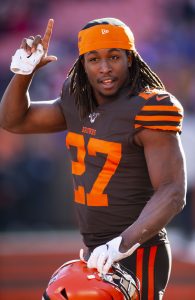 Hunt was coming off an abbreviated season when he reupped with his hometown team; his 2018 assault on a woman at a Cleveland hotel undoubtedly affected his price. The Browns’ Chubb-Hunt backfield drives their offense, and its importance figures to increase with Brissett. The Browns lacking much pass-catching certainty is another reason they have surely prioritized keeping Hunt, the team’s receiving back. Even with D’Ernest Johnson back in the fold, this all points to Hunt playing out his contract. Hunt’s presence also keeps Chubb’s mileage manageable. While that will keep annoying fantasy GMs, Chubb remaining a top-tier back in 2023 is suddenly a key Browns matter considering their Watson-adjusted timeline.
Hunt was coming off an abbreviated season when he reupped with his hometown team; his 2018 assault on a woman at a Cleveland hotel undoubtedly affected his price. The Browns’ Chubb-Hunt backfield drives their offense, and its importance figures to increase with Brissett. The Browns lacking much pass-catching certainty is another reason they have surely prioritized keeping Hunt, the team’s receiving back. Even with D’Ernest Johnson back in the fold, this all points to Hunt playing out his contract. Hunt’s presence also keeps Chubb’s mileage manageable. While that will keep annoying fantasy GMs, Chubb remaining a top-tier back in 2023 is suddenly a key Browns matter considering their Watson-adjusted timeline.
To secure a worthwhile deal as a 2023 free agent, Hunt will need to stay healthy this year. He did not do so in 2021, missing nine games. Next year’s free agency class also could create a buyer’s market at running back — not that it ever veers heavily toward sellers anymore. Ahead of Week 1, Saquon Barkley, Josh Jacobs, David Montgomery, Damien Harris and Miles Sanders join Hunt in entering contract years. So many younger, starter-caliber options included here will undoubtedly impact Hunt’s quest to be paid a deal commensurate with his abilities.
Adofo-Mensah was with the Browns for just two years, and one of the interviewees he beat out for the Vikings’ top front office job joined Berry. Raiche’s vault up the front office ladder represents a major story within the NFL executive ranks. The young exec was a CFL assistant GM in her 20s and has only been in the NFL since 2019. Teams may view Raiche as needing more experience before making her a GM finalist, but this Cleveland position profiles as a potential launching pad for the NFL to have its first female GM in nearly 40 years. The ex-Berry Eagles coworker and Cook — a seventh-year Browns staffer who interviewed for Minnesota and Chicago’s GM gigs — will be tasked with helping Berry build a roster around Watson’s unique contract. How that goes will probably determine how quickly Raiche and/or Cook can land a GM position elsewhere.
Top 10 cap charges for 2022:
- Myles Garrett, DE: $12.96MM
- Jack Conklin, T: $11MM
- Deshaun Watson, QB: $9.4MM
- John Johnson, S: $7.75MM
- Joel Bitonio, G: $6.66MM
- Kareem Hunt, RB: $6.25MM
- Jedrick Wills, T: $5.37MM
- Nick Chubb, RB: $5.21MM
- Denzel Ward, CB: $5.04MM
- Amari Cooper, WR: $4.9MM
In a tough AFC, the Browns missing their top quarterback for 11 games could make this a lost season. Cleveland’s nucleus received too much hype in 2019, not enough in 2020 and entered 2021 spearheading a squad viewed as a surefire AFC contender — only to take a major step back. The Garrett-, Ward-, Chubb- and Bitonio-led crew’s big-picture relevance possibly being on hold until 2023 would add to the list of oddities surrounding this franchise.
The Browns, who created a contract that also keeps Watson’s guarantees intact despite the suspension, have made an unprecedented commitment to a player embroiled in one of the biggest scandals in modern NFL history. The volume of accusations against Watson and his comments since being acquired make the former national championship-winning QB an atypical franchise centerpiece. How this polarizing partnership unfolds on and off the field will define the Haslams’ ownership tenure and the Berry-Stefanski regime. For better or worse, Watson is the Browns’ future.
By Rory Parks |
at September 4, 2022 10:30 pm
The Lions may not compete for a playoff spot in 2022, but they will hope to show signs of improvement in Year 2 of the Brad Holmes/Dan Campbell partnership. The club did not make a play for a franchise quarterback in a draft class widely considered weak at the position, instead opting to focus on other areas of need while giving 2021 trade acquisition Jared Goff another year under center.
However, Holmes did make one major draft-day splash, moving up 20 spots from No. 32 overall to No. 12 overall to nab Alabama wide receiver Jameson Williams. While Williams, who tore his ACL in the 2022 College Football Playoff National Championship Game, is not expected to see game action until the middle of the season, Detroit clearly sees him as a foundational piece of its offense in the long term.
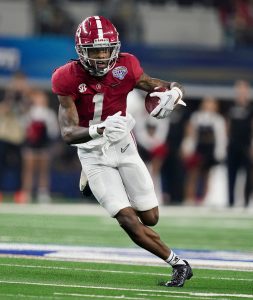
Aidan Hutchinson, meanwhile, will be asked to make an impact right away. The No. 2 overall pick from the University of Michigan, Hutchinson was a menace to collegiate offenses in 2021, racking up 14 sacks, 16.5 tackles for loss, and a pair of forced fumbles in his final year with the Wolverines. That performance made the Michigan native a Heisman Trophy candidate as well as a candidate to be the first player taken in this year’s draft. While he fell just short of both honors, he has been penciled into a starting DE job since Holmes turned in the card for him, and he should provide a jolt to a defense that posted the third-fewest sacks in the league in 2021.
As might be expected for a rebuilding outfit, the Lions did not make many notable free agent acquisitions. They will hope that their young talent proves itself to be the core of a future contender, a core than can be supplemented with more outside help — including, perhaps, a new quarterback — in 2023.
Trades:
- Traded pick nos. 32, 34, and 66 to Vikings for pick nos. 12 and 46; selected Williams with no. 12 pick, selected DE Josh Paschal with No. 46 pick.
Just as they largely avoided making any major moves in free agency, the Lions did not pull the trigger on any notable trades other than the draft-day transaction that netted them the opportunity to draft Williams. The club’s 3-13-1 record in 2021 gave it the No. 2 overall selection, and it had acquired the No. 32 overall pick from the Super Bowl champion Rams as part of last year’s Matthew Stafford/Goff trade. Los Angeles’ championship victory stuck Detroit with the lowest possible first-round choice, and Holmes was not content to wait until the bottom of the round to land another possible difference-maker after picking Hutchinson.
Instead, he catapulted up the board to take Williams, whose ACL tear is obviously a concern but whose delayed start to the 2022 campaign was not a major deterrent for a team that does not have realistic postseason expectations this year. Williams had a breakout performance in 2021 after transferring from Ohio State to Alabama, finishing with 79 catches for 1,572 yards and 15 touchdowns, earning him a First Team All-American nod.
A strong route runner with good hands and dangerous speed, it is easy to see the appeal in Williams, who could perhaps add weight to his 179-lb frame but who has the size (6-2) and length to make the most of his tools. Though he will need to improve against press coverage and in making contested catches, Williams will pair with 2021 draftee Amon-Ra St. Brown to form an intriguing tandem at or near the top of Detroit’s future WR depth charts.
Because of his team’s defensive struggles in 2021 — the Lions surrendered 27.5 points per game last season, the second-worst mark in the NFL — it was not surprising to see Holmes continue to fortify that side of the ball even after the Hutchinson selection. Paschal, who was selected with the other pick acquired in the trade-up for Williams, may not provide a significant lift in the edge rush department, though he should always be stout against the run and can be effective as an interior rusher in sub-packages. In his final season at Kentucky, he produced five sacks and 15 tackles for loss, earning Second Team All-SEC acclaim for his efforts.
Like Williams, Paschal will need to wait a bit to make his professional debut. During spring workouts, Paschal aggravated a core injury that he initially sustained in college, and he was forced to undergo offseason surgery. He was recently placed on the reserve/PUP list, so he will miss at least the first four games of the regular season.
Notable free agency additions:
- Chris Board, LB. One year, $2MM. $1MM guaranteed.
- Isaiah Buggs, DL. One year, $965K.
- DJ Chark, WR. One year, $10MM. Fully-guaranteed.
- Jarrad Davis, LB. One year, $1.04MM. Released 8/29/22. Signed to practice squad 8/31/22.
- DeShon Elliott, S. One year, $965K.
- Devin Funchess, TE. One year, $1.04MM. Released 8/30/22.
- Garrett Griffin, TE. One year, $965K. Released 8/15/22. Signed to practice squad 8/31/22.
- Mike Hughes, CB. One year, $3.5MM. $1MM guaranteed.
- Kendall Lamm, OL. One year, $1.12MM. Released 8/30/22.
- Nate Sudfeld, QB. One year, $1.04MM.
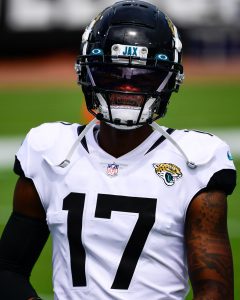 Chark’s contract was far and away the biggest commitment that the Lions made to an outside free agent this offseason, and his signing, combined with the Williams selection and the re-signing of fellow wideout Josh Reynolds, demonstrated a clear organizational desire to stockpile skill-position talent (at one point this offseason, the team was rumored to be interested in swinging a trade for 49ers star Deebo Samuel). With Chark, St. Brown, Reynolds, tight end T.J. Hockenson, and (eventually) Williams on the field — to say nothing of a quality offensive line and a competent 1-2 punch of D’Andre Swift and Jamaal Williams in the backfield — the offense should be well-positioned to improve on its poor yards-per-game (322.6) and points-per-game (19.1) numbers in 2022.
Chark’s contract was far and away the biggest commitment that the Lions made to an outside free agent this offseason, and his signing, combined with the Williams selection and the re-signing of fellow wideout Josh Reynolds, demonstrated a clear organizational desire to stockpile skill-position talent (at one point this offseason, the team was rumored to be interested in swinging a trade for 49ers star Deebo Samuel). With Chark, St. Brown, Reynolds, tight end T.J. Hockenson, and (eventually) Williams on the field — to say nothing of a quality offensive line and a competent 1-2 punch of D’Andre Swift and Jamaal Williams in the backfield — the offense should be well-positioned to improve on its poor yards-per-game (322.6) and points-per-game (19.1) numbers in 2022.
A fractured ankle limited Chark to just four games in 2021, his final season with the Jaguars, and he missed time in 2020 as well. In 2019, however, he earned a Pro Bowl nod after authoring a 73/1,008/8 line, and he still has youth on his side (he will turn 26 in September). A 6-4 receiver with legitimate big-play ability, a strong display in the Motor City could put Chark in line to take advantage of the exploding WR market next offseason, though much of his success will of course depend on the rapport he develops with Goff and whether he can shake the health issues that have hampered him over the past several years.
Holmes made a few modest FA signings to bolster his defense, though one of those (Davis) was recently cut and added to the taxi squad. Davis, whom the Lions selected in the first round of the 2017 draft, was a full-time starter over his first three years in the league before seeing his playing time cut dramatically in 2020, the fourth and final year of his rookie deal. He appeared in nine games (five starts) with another defensively-challenged club, the Jets, in 2021, and reunited with the Lions in March.
Given that Detroit’s LB corps is presently comprised of options that are generally underwhelming (Alex Anzalone) or unproven (2021 fourth-rounder Derrick Barnes and sixth-round rookie Malcolm Rodriguez), it would not be surprising to see Davis promoted to the active roster at some point. On the other hand, Davis has never really lived up to his first-round billing despite strong tackle numbers in the first several years of his career, and the fact that he could not crack a 53-man roster that is so light on linebacker talent is telling.
Read more
Board, on the other hand, made the roster and is presently penciled in as a starter alongside Anzalone. The Ravens signed the North Dakota State product as a UDFA in 2018, and he instantly became a key member of the club’s special teams unit. He eventually earned more burn on the defensive side of the ball, appearing in 25% of Baltimore’s defensive snaps in 2020 and 33% in 2021. That increased playing time was largely a function of the Ravens’ own second-level struggles; Pro Football Focus graded Board as an average-to-below-average performer in terms of run defense, pass defense, and coverage in 2021, so he is unlikely to offer the boost that the Lions really need. At present, the team’s LB collection appears to be the weakest position group on the roster.
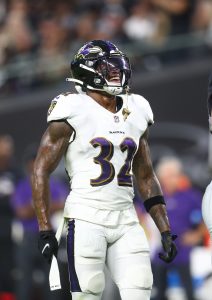 In an effort to improve the team’s secondary, Holmes added another ex-Raven in safety DeShon Elliott. Elliott, a 2018 sixth-rounder, has always had the potential to be at least a competent starter at the NFL level, but injuries have marred his young career. He missed all of his rookie season due to a fractured forearm, and he appeared in only six games in 2019 thanks to a knee injury. He finally suited up for a full slate of contests in 2020, and he played reasonably well, grading out as a plus-defender in coverage and against the run in the eyes of PFF. He was enjoying a similar performance last year before a biceps and pectoral injury suffered in Week 8 knocked him out for the rest of the campaign.
In an effort to improve the team’s secondary, Holmes added another ex-Raven in safety DeShon Elliott. Elliott, a 2018 sixth-rounder, has always had the potential to be at least a competent starter at the NFL level, but injuries have marred his young career. He missed all of his rookie season due to a fractured forearm, and he appeared in only six games in 2019 thanks to a knee injury. He finally suited up for a full slate of contests in 2020, and he played reasonably well, grading out as a plus-defender in coverage and against the run in the eyes of PFF. He was enjoying a similar performance last year before a biceps and pectoral injury suffered in Week 8 knocked him out for the rest of the campaign.
A big hitter who has enough speed to adequately patrol the back end of a defense, Elliott would have been in line for a much larger payday if not for the injury concerns. If he can stay healthy in 2022 while producing at the level he appears capable of, he could pull down a multi-year pact in 2023. His addition moved Will Harris, a 17-game safety starter in 2021, to cornerback, and Harris is expected to line up both outside the boundaries and in the slot.
Hughes is all-too-familiar with the harsh reality of health problems. The former first-round pick of the Vikings appeared in only six games in his rookie season in 2018 due to an ACL tear, he missed time with a neck ailment in 2019, and more neck issues limited him to only four games in 2020. Being traded to the Chiefs last May was apparently the tonic he needed, as Hughes appeared in all 17 regular season games for Kansas City and all three of the club’s postseason contests. He also earned an excellent 79.6 overall grade from PFF, which was especially fond of his coverage ability. Despite that, and despite reports of a robust market for his services, Hughes had to settle for a one-year, $3.5MM accord. Still, he should get plenty of opportunity to prove his injury woes are a thing of the past and to post a second strong platform year as a member of a CB corps that has some upside but that has no proven performers outside of Amani Oruwariye.
Notable re-signings:
- Alex Anzalone, LB. One year, $2.25MM. $1.75MM guaranteed.
- David Blough, QB. One year, $1.15MM. $205K guaranteed. Waived 8/31/22.
- Tim Boyle, QB. One year, $2MM. $1.75MM guaranteed. Released 8/29/22.
- Evan Brown, OL. One year, $2.03MM. $600K guaranteed.
- Jason Cabinda, FB. Two years, $4.1MM. $2.035MM guaranteed.
- Charles Harris, DE. Two years, $13MM. $7MM guaranteed.
- C.J. Moore, DB. One year, $1.75MM. $800K guaranteed. Waived/injured 8/30/22.
- Kalif Raymond, WR. Two years, $5MM. $2.85MM guaranteed.
- Josh Reynolds, WR. Two years, $6MM. $2.7MM guaranteed.
- Tracy Walker, S. Three years, $25MM. $17MM guaranteed.
- Josh Woods, LB. One year, $1.55MM. $750K guaranteed.
While the Lions were not especially active in acquiring outside free agents, they did make a concerted effort to retain some of their own talent. The largest contract given to the club’s own pending FAs went to Walker, who landed a three-year accord following a 2021 season in which he started all 15 games he played and recorded 108 tackles. He has always been a sure tackler, but his abilities in coverage have been more questionable. Last year, he yielded a 97.6 passer rating on passes in which he was the closest man in coverage, and though that is a significant improvement over the 122.8 and 117.2 marks he posted in the prior two seasons, it is still less than ideal. The hope is that he will continue to better himself in that regard while maintaining his tackling prowess. He and Elliott will likely be called upon a great deal given the porousness of the linebackers in front of them.
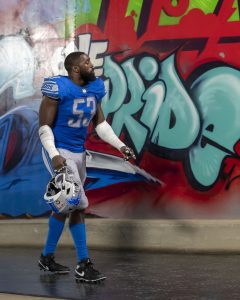 One way to minimize the weak spots in the second and (perhaps) third levels of coverage is to give opposing quarterbacks minimal time to throw, and to that end, the Lions retained Charles Harris, who was something of a revelation in 2021. A first-round pick of the Dolphins in 2017, Harris never made much of an impact in Miami and was dealt to Atlanta in May 2020 in exchange for a seventh-round pick. In his first season in Detroit, Harris appeared in all 17 games (14 starts) and notched 7.5 sacks after posting 6.5 total sacks over his first four professional seasons.
One way to minimize the weak spots in the second and (perhaps) third levels of coverage is to give opposing quarterbacks minimal time to throw, and to that end, the Lions retained Charles Harris, who was something of a revelation in 2021. A first-round pick of the Dolphins in 2017, Harris never made much of an impact in Miami and was dealt to Atlanta in May 2020 in exchange for a seventh-round pick. In his first season in Detroit, Harris appeared in all 17 games (14 starts) and notched 7.5 sacks after posting 6.5 total sacks over his first four professional seasons.
Harris and Hutchinson give the team a pair of young DE bookends with first-round pedigree, and after adding Paschal in the second round of this year’s draft and selecting players like NT Alim McNeill and DE Levi Onwuzurike with Day 2 selections in 2021, it has become clear that Holmes is taking the tried-and-true approach of building his defense from the inside out.
As noted above, however, Holmes has paid plenty of attention to his pass catchers. The GM was the Rams’ director of college scouting when Los Angeles selected Reynolds in the fourth round of the 2017 draft, and he claimed Reynolds off waivers from the Titans in November. The move reunited the Texas A&M product with Goff, and Reynolds rewarded his new team with a 19/306/2 line in seven games (five starts) to close out the season. The club also re-signed Raymond, who had made a name for himself as a return specialist for Tennessee in 2020 and who caught 48 passes for 576 yards and four TDs for the Lions in 2021, all of which were easily career-best marks. He also returned 21 punts, and considering the new additions to the WR room, he may asked to concentrate primarily on special teams, especially when Williams is healthy enough to play.
The Lions re-signed backup signal-callers Blough and Boyle this offseason but ended up parting ways with both of them. Sudfeld, signed on August 31 after being released by the 49ers, will operate as Goff’s clipboard holder.
Notable losses:
A silver lining of having a 3-13-1 season is that there are not many difficult departures to endure in the ensuing offseason. Far and away the biggest name on this list of notable losses is Flowers, who signed a massive five-year, $90MM contract in 2019, a deal authorized by the Lions’ previous regime. Flowers did record seven sacks in his first Detroit season, but he played in just seven games in each of the subsequent two campaigns due to injury. The move saddled the Lions with a significant dead money charge, although the cap savings of $10.4MM made it an easy decision. Flowers did not generate much reported interest this offseason, and he signed with the Dolphins at the end of August.
Campbell expressed a desire to retain Reeves-Maybin, which makes sense given the aforementioned lack of LB talent. Detroit’s 2017 fourth-rounder, who played 62% of the club’s defensive snaps in 2021 after operating primarily as an ST player over his first four NFL seasons, decided to head south instead, signing a two-year, $7.5MM pact with the Texans.
Draft:
- Round 1: No. 2 Aidan Hutchinson, DE (Michigan)
- Round 1: No. 12 (from Vikings) Jameson Williams, WR (Alabama)
- Round 2: No. 46 (from Vikings) Josh Paschal, DE (Kentucky)
- Round 3: No. 97 Kerby Joseph, S (Illinois)
- Round 5: No. 177 James Mitchell, TE (Virginia Tech)
- Round 6: No. 188 (from Seahawks through Jaguars and Eagles) Malcolm Rodriguez, LB (Oklahoma State)
- Round 6: No. 217 James Houston, DE (Jackson State)
- Round 7: No. 237 (from Saints through Eagles) Chase Lucas, CB (Arizona State)
Other:
Considering the Lions’ offensive struggles in 2021 and the fact that Campbell took over play-calling duties from Lynn in November, it was no surprise to see the team move on from Lynn. Johnson worked as an offensive quality control coach in 2019 before becoming tight ends coach in 2020, and he saw expanded responsibilities once Campbell became the play-caller. Johnson will have a little more talent to work with than Lynn did, and it is clear the current brain trust — which retained Johnson even though he was originally hired by the prior administration — thinks highly of his abilities.
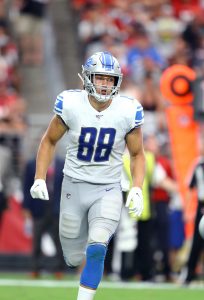 One of the bright spots on the offensive side of the ball during the past several seasons has been Hockenson, who earned a Pro Bowl bid in 2020 after posting a 67/723/6 line that year. A thumb injury cost him the final fives games of the 2021 season, but he was on pace to match or exceed his 2020 totals, and the team exercised his fifth-year option. That locks Hockenson in to a $9.39MM salary for 2023, although player and team may well hammer out an extension before then.
One of the bright spots on the offensive side of the ball during the past several seasons has been Hockenson, who earned a Pro Bowl bid in 2020 after posting a 67/723/6 line that year. A thumb injury cost him the final fives games of the 2021 season, but he was on pace to match or exceed his 2020 totals, and the team exercised his fifth-year option. That locks Hockenson in to a $9.39MM salary for 2023, although player and team may well hammer out an extension before then.
In addition to a new deal for Hockenson, Holmes is also prioritizing a re-up for Oruwariye, who enjoyed a breakout in 2021. A fifth-round pick in 2019, Oruwariye picked off six passes last season, and while PFF assigned him a mediocre 59.0 overall grade for his efforts — which was only marginally better than his 50.4 mark in 2020, his first year as a full-time starter — he allowed a meager 74.1 QB rating as the closest defender. This appears to be an instance where a player’s PFF grade is not reflective of his actual performance, and it seems the Lions will be relying heavily on Oruwariye to lock down one boundary for the foreseeable future.
Starting opposite Oruwariye will be Jeff Okudah, the No. 3 overall pick in 2020 who missed seven games as a rookie and then suffered a torn Achilles during Detroit’s season opener last year. There was some question as to whether Okudah would beat out Harris for a starting job, and considering his draft status, it would have been hugely demoralizing if he had been unable to do so. Luckily, Campbell has stated that Okudah has been “trending in the right direction” in recent weeks, so he will get another shot to prove his worth. His 2022 performance will doubtlessly have a significant impact on how Holmes addresses his secondary in 2023.
Top 10 cap charges for 2022:
- Jared Goff, QB. $31.15MM.
- Taylor Decker, LT. $14.4MM (via 9/3/22 restructure).
- Jeff Okudah, CB. $9.14MM.
- Michael Brockers, DT. $8.98MM.
- Halapoulivaati Vaitai, G. $8.73MM.
- Frank Ragnow, C. $7.55MM.
- T.J. Hockenson, TE. $6.51MM.
- Aidan Hutchinson, DE. $6.49MM.
- Penei Sewell, RT. $5.48MM.
- Jamaal Williams, RB. $4.63MM.
Goff guided the Rams to a Super Bowl LIII appearance at the end of the 2018 season, a campaign in which he earned his second consecutive Pro Bowl nod. It appeared that he and Rams HC Sean McVay were in the early stages of a long and fruitful relationship, and Los Angeles handed Goff a four-year, $134MM ($110MM guaranteed) contract in advance of the 2019 season. Goff, however, was unable to replicate his 2017-18 success over the 2019-20 campaigns, and his relationship with McVay eroded over time.
When Holmes swung the Stafford/Goff trade last year, he was clear that he took on Goff’s contract not just as a means to pry additional draft capital from the Rams, but also because he believed Goff could return to his Pro Bowl level of performance. Of course, the No. 1 overall pick of the 2016 draft was unable to approach anything close to those heights in 2021, and while the lack of offensive talent surrounding him is certainly a major reason for that, it might not be a stretch to characterize 2022 as a make-or-break year for Goff.
Although the dead money ramifications of a release made it all but certain that Goff would return this season, the Lions can release him in 2023 and save over $20MM against the cap, with a palatable $10MM dead money charge. If he struggles in 2022, he may well be on his way out of Detroit. On the other hand, his $20.6MM base salary next year would represent a bargain for a Pro Bowl passer, so if the team’s improved weaponry leads to better results, it is certainly possible that Holmes will bring him back. With the 2023 collegiate class of QBs considered to be much stronger than this year’s class, though, Holmes could have a career-defining decision to make if he is in position to select one of those players.
By Ben Levine |
at September 3, 2022 10:00 pm
Following a 2020 campaign that saw them win 13 games before losing in the AFC Championship Game, the Bills were primed for a Super Bow run in 2021. Unfortunately, the team couldn’t match that success; after winning 11 games during the regular season and destroying the Patriots in the wild-card round, they fell to the Chiefs during the divisional round.
After falling short in two straight postseasons, the Bills are all-in, and that was clear from their moves this offseason. The team committed a lot of money and years to Von Miller, who provides both a pass-rushing prowess and a championship pedigree. Otherwise, the Bills were able to capitalize on their contender status and ink a number of starting-worthy players to reasonable contracts. Yes, the Bills did lose a number of contributors, but when the dust settled, GM Brandon Beane was able to fill most of those vacancies via free agent and the draft.
The Bills have loaded up and are ready to make a run to the Super Bowl. If they do make it, then the organization’s offseason maneuverings will have surely played a major role in that accomplishment:
Trades:
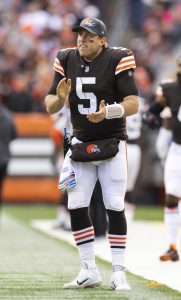 With Mitchell Trubisky off to Pittsburgh, the Bills needed a backup for Josh Allen. The team opted for Case Keenum, acquiring the veteran QB from the Browns for a seventh-round pick. The former starter served as a backup to Baker Mayfield over the past two seasons in Cleveland, with the Browns winning each of his two starts with the franchise. Keenum will slide in between Allen and Matt Barkley (who is currently stashed on the practice squad) on the depth chart.
With Mitchell Trubisky off to Pittsburgh, the Bills needed a backup for Josh Allen. The team opted for Case Keenum, acquiring the veteran QB from the Browns for a seventh-round pick. The former starter served as a backup to Baker Mayfield over the past two seasons in Cleveland, with the Browns winning each of his two starts with the franchise. Keenum will slide in between Allen and Matt Barkley (who is currently stashed on the practice squad) on the depth chart.
Cody Ford was a second-round pick by the Bills in 2019. He started 15 of his 16 appearances as a rookie, but after being limited to only seven games in 2020, the lineman was in and out of the starting lineup in 2021. His inability to play offensive tackle ultimately cost him a spot on the Bills roster, but Buffalo was fortunate to receive a draft pick instead of outright cutting him.
Notable signings:
- Matt Barkley, QB. One year, $1.14MM.
- Jamison Crowder, WR. One year, $2MM.
- Duke Johnson, RB. One year, $1.27MM.
- DaQuan Jones, DL. Two years, $14MM.
- Shaq Lawson, DE. One year, $1.18MM.
- Von Miller, LB. Six years, $120MM.
- Jordan Phillips, DL. One year, $5MM.
- David Quessenberry, OL. One year, $1.25MM.
- Rodger Saffold, G. One year, $6.25MM.
- Tim Settle, DT. Two years, $9MM.
- Greg Van Roten, G. One year, $1.27MM.
The Bills made one of the biggest free agent splashes of the offseason when they landed future Hall of Fame pass rusher Von Miller. Following a half-season stint with the Rams that saw him earn his second Super Bowl ring, Miller inked a $120MM deal to help guide the Bills to at least their first AFC Championship win since 1993. Miller, 33, missed the entire 2020 season and suffered a midseason injury to close out his Broncos tenure in 2021. However, following his midseason trade, he bolstered his value considerably with the Rams, recording nine sacks across the team’s final eight games, including two in Super Bowl LVI. His championship pedigree and pass-rushing ability should go a long way in Buffalo, and while the significant investment is certainly risky considering the edge rusher’s age and recent injury history, it’ll all be worth it if he leads the Bills to the promised land.
Rams that saw him earn his second Super Bowl ring, Miller inked a $120MM deal to help guide the Bills to at least their first AFC Championship win since 1993. Miller, 33, missed the entire 2020 season and suffered a midseason injury to close out his Broncos tenure in 2021. However, following his midseason trade, he bolstered his value considerably with the Rams, recording nine sacks across the team’s final eight games, including two in Super Bowl LVI. His championship pedigree and pass-rushing ability should go a long way in Buffalo, and while the significant investment is certainly risky considering the edge rusher’s age and recent injury history, it’ll all be worth it if he leads the Bills to the promised land.
Other than their acquisition of Miller, the Bills stuck to one- or two-year deals for their other free agent acquisitions. DaQuan Jones is the best bet among those signings to see a significant role on defense. In seven seasons with the Titans, Jones started 93 of his 99 appearances, collecting 273 tackles and 10 sacks. He also saw time in four playoff games, collecting another nine tackles and 1.5 sacks. He joined the Panthers last offseason and started all 17 games for his new squad, ranking 34th among 108 qualifying interior defenders, per Pro Football Focus. Tim Settle will likely serve as one of the DT backups, with the former fifth-round pick compiling seven sacks during his four season with Washington.
Elsewhere on defense, the Bills welcomed back a pair of former defenders. Shaq Lawson was a first-round pick by the Bills back in 2016, racking up 16.5 sacks during his four years in Buffalo. He inked a three-year deal with the Dolphins in 2020, but he didn’t come close to matching his previous production and was shipped to Houston one year later. He didn’t even suit up for the Texans before he was shipped to the Jets, where he managed one sack before earning his walking papers. Jordan Phillips also left Buffalo in 2020 following a career year where he led the Bills with 9.5 sacks. That performance landed him a $30MM deal from Cardinals, but he only got into 18 games between two seasons with the organization before getting cut. The two veterans ultimately made the 53-man roster and will presumably provide some extra depth up front.
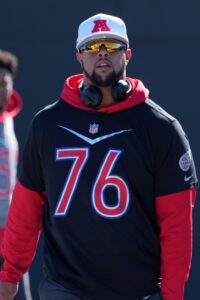 On offense, the team’s most notable changes came to their offensive line, with Rodger Saffold and David Quessenberry expected to slide into the starting lineup. Saffold has started 157 games during his 12-year career, and he earned his first career Pro Bowl nod in 2021 after starting 15 games for the Titans. PFF ended up ranking the veteran 31st among 82 qualifying offensive guards in 2022, and they gave him a particularly high grade on his run-blocking ability. Saffold ranked in or close to the top-10 in previous seasons, so it remains to be seen if the drop in 2021 was just an off year or an indication that age is catching up to him. Quessenberry also comes over from Tennessee following a 2021 campaign where he started a career-high 17 games. PFF was fond of his performance, ranking him 18th among 83 qualifying offensive tackles. Securing the duo on one-year pacts was a major win for the Bills. Greg Van Roten provides the team with some additional starting experience on the offensive line, with the veteran expected to serve as Buffalo’s swing guard.
On offense, the team’s most notable changes came to their offensive line, with Rodger Saffold and David Quessenberry expected to slide into the starting lineup. Saffold has started 157 games during his 12-year career, and he earned his first career Pro Bowl nod in 2021 after starting 15 games for the Titans. PFF ended up ranking the veteran 31st among 82 qualifying offensive guards in 2022, and they gave him a particularly high grade on his run-blocking ability. Saffold ranked in or close to the top-10 in previous seasons, so it remains to be seen if the drop in 2021 was just an off year or an indication that age is catching up to him. Quessenberry also comes over from Tennessee following a 2021 campaign where he started a career-high 17 games. PFF was fond of his performance, ranking him 18th among 83 qualifying offensive tackles. Securing the duo on one-year pacts was a major win for the Bills. Greg Van Roten provides the team with some additional starting experience on the offensive line, with the veteran expected to serve as Buffalo’s swing guard.
Jamison Crowder had more than 50 catches in each of his three seasons with the Jets, and he was brought in to Buffalo to potentially fill the void left by Cole Beasley. That role ended up going to Isaiah McKenzie, leading some to wonder if Crowder’s roster spot could be in doubt. Instead, he’ll be sticking around to provide some veteran depth at the bottom of the depth chart. The same goes for Duke Johnson, although the veteran RB will have to wait for his turn while sitting on Buffalo’s practice squad.
Notable losses:
- Mario Addison, DE
- Cole Beasley, WR (released)
- Jon Feliciano, G (released)
- Jerry Hughes, DE
- A.J. Klein, LB (released)
- Star Lotulelei, DT (released)
- Harrison Phillips, DT
- Emmanuel Sanders, WR
- Mitchell Trubisky, QB
- Levi Wallace, CB
- Daryl Williams, OT (released)
The Bills did an admirable job accounting for their major losses. Mario Addison had seven sacks for the Bills in 2021, but he played fewer than half the team’s defensive snaps while serving as a situational pass-rusher. Jerry Hughes got the majority of the starts on the edge, but he finished last year with only a pair of sacks. Von Miller obviously can’t replace two players, but his pass-rushing ability should more than make up for the departure of the two defensive ends. 2021 first-round pick Greg Rousseau will start opposite Miller, with former second-round picks Boogie Basham and A.J. Epenesa expected to slide into Addison’s situational role.
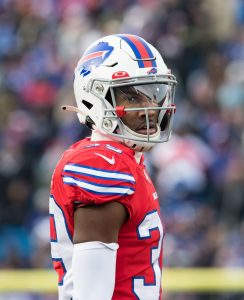 Levi Wallace can’t match his now-former teammate Tre’Davious White‘s impact on defense, but he still started each of his 45 games over the past three seasons. Former seventh-round pick Dane Jackson seems to be the best bet to temporarily replace Wallace in the starting lineup, but rookie first-round pick Kaiir Elam should eventually slide in opposite White. Free agent signing DaQuan Jones is expected to slide in at defensive tackle next to Ed Oliver, replacing Harrison Phillips and Star Lotulelei, who basically split that role in 2021. A.J. Klein saw a reduced role during his second season in Buffalo, and after starting only four games in 2021, he earned his walking papers.
Levi Wallace can’t match his now-former teammate Tre’Davious White‘s impact on defense, but he still started each of his 45 games over the past three seasons. Former seventh-round pick Dane Jackson seems to be the best bet to temporarily replace Wallace in the starting lineup, but rookie first-round pick Kaiir Elam should eventually slide in opposite White. Free agent signing DaQuan Jones is expected to slide in at defensive tackle next to Ed Oliver, replacing Harrison Phillips and Star Lotulelei, who basically split that role in 2021. A.J. Klein saw a reduced role during his second season in Buffalo, and after starting only four games in 2021, he earned his walking papers.
Daryl Williams started every game for the Bills during his two seasons in Buffalo, but the team ended up saving some money after his play slipped. Jon Feliciano was also a consistent starter during his three seasons in Buffalo, but he was released following a 2021 campaign where he was limited to nine games (six starts). Rodger Saffold presents a potential upgrade to both of those departed players, although the team will have to rely on an inexperienced guard (like Ryan Bates) opposite the free agent acquisition. David Quessenberry doesn’t offer the same versatility of Williams, but the free agent addition is a capable starting tackle.
On offense, the team’s most notable departure was wideout Cole Beasley, who was released following three seasons in Buffalo. The veteran had 82 receptions in each of the past two seasons, but despite getting into 16 games in 2021 (the most during his Bills tenure), he had the fewest receiving yards (693) and touchdowns (one) during his Bills tenure. Emmanuel Sanders also produced for the Bills last season, hauling in 42 receptions for 626 yards and four touchdowns. The Bills are turning to internal options to replace the duo, with Gabriel Davis and Isaiah McKenzie expected to see larger roles in 2022.
Re-signed:
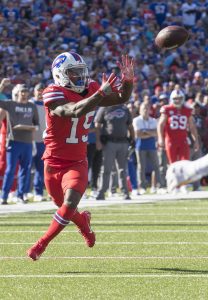 While the Bills had a long list of departed free agents, they did make sure to retain a handful of players. After inking a one-year deal to stick in Buffalo during the 2021 season, Isaiah McKenzie got a two-year pact this time around. The wideout hasn’t put up big numbers during his three-plus seasons in Buffalo, and his 2021 campaign was actually his worst in regards to counting stats (20 receptions, 178 receiving yards, one touchdown). However, the team clearly believes in his talent, and he’ll be counted on to contribute in 2022 following the departures of Cole Beasley and Emmanuel Sanders.
While the Bills had a long list of departed free agents, they did make sure to retain a handful of players. After inking a one-year deal to stick in Buffalo during the 2021 season, Isaiah McKenzie got a two-year pact this time around. The wideout hasn’t put up big numbers during his three-plus seasons in Buffalo, and his 2021 campaign was actually his worst in regards to counting stats (20 receptions, 178 receiving yards, one touchdown). However, the team clearly believes in his talent, and he’ll be counted on to contribute in 2022 following the departures of Cole Beasley and Emmanuel Sanders.
Ike Boettger was also brought back after starting 17 games for the team over the past two seasons. The offensive lineman tore his Achilles in late December, and he naturally landed on injured reserve to being the campaign, knocking him out for at least the first four games of the season. However, when he comes back, he’ll provide the coaching staff with another experienced option on the offensive line.
Siran Neal has only missed one game for the Bills over the past four seasons, and he’s turned into one of the team’s most reliable special teams players. He’ll continue to see a secondary role on defense as a backup nickelback in 2022. Taiwan Jones has also mostly played special teams for the Bills over the past two seasons, garnering only five offensive snaps. Bobby Hart joined the Bills late during the 2021 campaign, his third stint with the organization. Despite re-signing with the organization, he may have a tough time sticking around for the entirety of the 2022 campaign.
Draft picks:
1-23:Kaiir Elam, CB (Florida)
2-63: James Cook, RB (Georgia)
3-89: Terrel Bernard, LB (Baylor)
5-148: Khalil Shakir, WR (Boise State)
6-180: Matt Araiza, P (San Diego State)
6-185: Christian Benford, CB (Villanova)
6-209: Luke Tenuta, OT (Virginia Tech)
7-231: Baylon Spector, LB (Clemson)
The Bills moved up two spots during the draft to select Florida cornerback Kaiir Elam, with GM Brandon Beane declaring the prospect as the last remaining player on their draft board with a first-round grade. It’s not hard to see why; Elam finished his Gators career with five interceptions, and he’s armed with a pro-ready frame (six-foot-two, 195 pounds). With Levi Wallace out of the picture, Elam could find himself playing a significant role sooner than later.
Read more
In the second round, the Bills added James Cook to a crowded RB room, joining former third rounders Devin Singletary (2019) and Zack Moss (2020). Cook had a breakout season at Georgia in 2021, finishing with 1,012 yards from scrimmage and 11 touchdowns. The Bills aren’t afraid of using all their RBs, but Cook’s second-round pedigree suggests the team may have some big plans for the RB down the road. Terrel Bernard was the team’s final pick in the top-100. The Baylor linebacker earned first team All-Big 12 honors in 2021 after finishing with 106 tackles, 7.5 sacks, and 12.5 tackles for loss. The rookie will have a tough time knocking Tremaine Edmunds and Matt Milano out of the lineup, but if either of those two go down, Bernard won’t see much competition for increased reps.
There’s little chance Buffalo’s either rookies see a direct path to playing time. Khalil Shakir provides some intrigue at wide receiver, but he’ll likely be buried on the depth chart unless he can supplant Jake Kumerow or Jamison Crowder as the WR4. Christian Benford is expected to be the team’s fourth outside CB to start the season, but with Buffalo committing a first-round pick to Elam, the Villanova product will need some luck to get extended run on defense.
Matt Araiza was recently included in a civil lawsuit accusing the former San Diego State punter of gang rape. The rookie sixth-round pick was later cut by Buffalo.
Other:
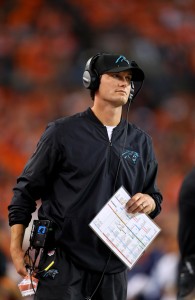 To replace former offensive coordinator Brian Daboll, who took the head coaching gig with the Giants, the Bills hired from within. The organization turned to quarterbacks coach and passing game coordinator Ken Dorsey to fill the void. This wasn’t a shocking move considering the coach’s familiarity with the organization. Dorsey has been with the Bills since 2019, beginning with the same QBs coach role he held for five years with the Panthers. For the past two seasons, he had the added title of passing game coordinator, helping guide the team to a third-place finish in points per game in 2021. More generally, he has played a crucial role in developing Josh Allen into an MVP candidate following the accuracy concerns surrounding the QB early in his career. To that, Joe Brady will now serve as Allen’s quarterbacks coach following a two-year stint as the Panthers offensive coordinator.
To replace former offensive coordinator Brian Daboll, who took the head coaching gig with the Giants, the Bills hired from within. The organization turned to quarterbacks coach and passing game coordinator Ken Dorsey to fill the void. This wasn’t a shocking move considering the coach’s familiarity with the organization. Dorsey has been with the Bills since 2019, beginning with the same QBs coach role he held for five years with the Panthers. For the past two seasons, he had the added title of passing game coordinator, helping guide the team to a third-place finish in points per game in 2021. More generally, he has played a crucial role in developing Josh Allen into an MVP candidate following the accuracy concerns surrounding the QB early in his career. To that, Joe Brady will now serve as Allen’s quarterbacks coach following a two-year stint as the Panthers offensive coordinator.
The team also committed to two key offensive players. After a handful of top receivers earned new deals, wide receiver Stefon Diggs got his pay day, including $70MM in guaranteed money. The wideout has earned Pro Bowl nods in each of his two seasons in Buffalo, and he finished the 2021 campaign having hauled in a career-high 10 touchdowns. Meanwhile, Mitch Morse has started all 47 of his appearances for the Bills over the past two years, including 17 this past year. Pro Football Focus ranked him only 24th among 39 qualifying centers last season, but his top-notch ability in pass protection makes him especially useful on a squad that lacks a consistent running attack.
Defensive lineman Ed Oliver is sticking around for the 2023 campaign after the organization picked up his fifth-year option. The former first-round has only put up modest numbers in his career, including a 2021 campaign where he finished with 41 tackles, four sacks, 12 QB hits, and 10 tackles for loss. However, Pro Football Focus considers him one of the most impactful interior defenders in the NFL (23rd among 108 qualifiers), and they graded him as the league’s best ID in coverage. Meanwhile, the Bills matched the offer sheet that offensive lineman Ryan Bates received from the Bears, assuring the fourth-year player sticks around for the upcoming season. Despite only having four career starts, Bates is projected to start during the upcoming season.
The Bills also had a handful of disappointments during the offseason. The Bills reportedly had a committment to add J.D. McKissic to their running backs room, with the pass-catching back adding Allen with another useful target. However, the running back ended up backing out of his deal and re-signing with Washington. Andre Smith has seen time in 27 games for the Bills over the past two seasons, primarily appearing on special teams. He’ll miss the first six games of the upcoming season while serving a suspension for violating the NFL’s performance-enhancing drug policy.
Top 10 cap charges for 2022:
- Josh Allen, QB: $16.3MM
- Tremaine Edmunds, LB: $12.7MM
- Stefon Diggs, WR: $11.7MM
- Jordan Poyer, S: $10.7MM
- Mitch Morse, C: $8MM
- Dion Dawkins, LT: $7MM
- Ed Oliver, DT: $6.2MM
- Micah Hyde, S: $5.6MM
- Von Miller, LB: $5.1MM
- Matt Milano, LB: $4.9MMit’s
The Bills are the favorites to win the Super Bowl in 2022, and for good reason. Following an offseason that saw them upgrade a number of positions, they’ll be primed for a deep playoff run. Considering the depth of the AFC, it certainly won’t be an easy path for Buffalo, but the team has as good a chance as any to be holding the Lombardi Trophy at season’s end.
By Sam Robinson |
at September 3, 2022 8:30 am
After steering a shorthanded team to the AFC’s No. 1 seed, Mike Vrabel looks to face another difficult task in 2022. The roster the fifth-year Titans HC will carry into Week 1 looks worse than the one he took into the divisional round in January. The losses of young standouts A.J. Brown and Harold Landry will create an uphill battle for a team that has aging offensive centerpieces. In an AFC that looks deeper than it was in 2021, can Tennessee craft another unlikely charge to prime playoff real estate?
Trades:
Ahead of Ryan Tannehill‘s age-34 season and with Derrick Henry turning 29 before this season’s conclusion, the Titans had Brown going into the final season of his rookie contract. They faced the same quandary the other teams that obtained No. 1-caliber wideout talent in a deep 2019 receiver draft did: pay the new going rate or sell high. While the Titans did collect quality assets for Brown, their move turned out to be a zag compared to how most of the teams in this position played their hand this offseason. Did Tennessee make the right call?
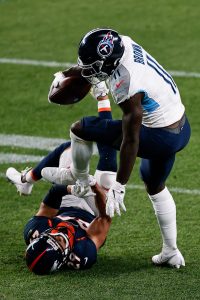 Vrabel and GM Jon Robinson each expressed a desire to have Brown in the fold long-term, and the parties began negotiations in late March. These talks started at a strange point on the receiver timeline, coming just as the Raiders and Dolphins changed the receiver market with $28MM-per-year and $30MM-AAV deals for Davante Adams and Tyreek Hill, respectively. Although each of those contracts feature final-year money that inflates the AAV, the receiver market was encountering turbulence. Just as Adams’ deal affected the Chiefs, the Titans soon saw those contracts impact their receiver situation.
Vrabel and GM Jon Robinson each expressed a desire to have Brown in the fold long-term, and the parties began negotiations in late March. These talks started at a strange point on the receiver timeline, coming just as the Raiders and Dolphins changed the receiver market with $28MM-per-year and $30MM-AAV deals for Davante Adams and Tyreek Hill, respectively. Although each of those contracts feature final-year money that inflates the AAV, the receiver market was encountering turbulence. Just as Adams’ deal affected the Chiefs, the Titans soon saw those contracts impact their receiver situation.
As it turned out, the Titans and Brown were never especially close on terms, leading Tennessee to follow the lead of Green Bay and Kansas City. The difference here is the Titans bailed on a 25-year-old playmaker whose prime should be ahead. The Packers and Chiefs traded late-20-somethings whose best years have probably already occurred. Brown said he would not have wanted out had the Titans offered $22MM per year, but the former second-round pick said Tennessee was offering a deal with a base value in the range of $16MM per year. Conflicting reports emerged about where the Titans were willing to go, but it was clear they were not hitting the price point the Eagles did. In terms of fully guaranteed money, no one has. Brown’s four-year, $100MM Philly pact contains a receiver-high $56MM guaranteed at signing.
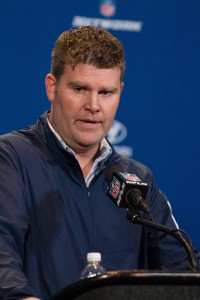 The Eagles effectively set the market for the 2019 receiver class (save for Diontae Johnson, who signed for a bit less to stay with the Steelers). The Commanders, Seahawks and 49ers each had wideouts (Terry McLaurin, D.K. Metcalf, Deebo Samuel) run the non-participation gamut Brown also threatened, with the NFC trio either skipping OTAs, no-showing for minicamp and/or turning to the newly popular hold-in tactic. But each team, with Brown’s Eagles deal as a starter kit, paid up. McLaurin, Metcalf and Samuel each inked a three-year extension worth between $23.3MM and $24MM per year. Despite finding Brown at No. 51 overall and seeing him pass Corey Davis as the team’s top target, the Titans decided the new market did not add up and started over with Treylon Burks.
The Eagles effectively set the market for the 2019 receiver class (save for Diontae Johnson, who signed for a bit less to stay with the Steelers). The Commanders, Seahawks and 49ers each had wideouts (Terry McLaurin, D.K. Metcalf, Deebo Samuel) run the non-participation gamut Brown also threatened, with the NFC trio either skipping OTAs, no-showing for minicamp and/or turning to the newly popular hold-in tactic. But each team, with Brown’s Eagles deal as a starter kit, paid up. McLaurin, Metcalf and Samuel each inked a three-year extension worth between $23.3MM and $24MM per year. Despite finding Brown at No. 51 overall and seeing him pass Corey Davis as the team’s top target, the Titans decided the new market did not add up and started over with Treylon Burks.
With Burks submitting an uneven offseason, the Titans could be scrutinized for bailing on Brown three years in. The team had a rookie-contract salary and a 2023 franchise tag as leverage. Brown had dealt with injury issues that sidelined him for six games between 2020 and ’21 and prevented him practicing at points at a young age, so the Eagles acquisition is no sure thing. But Philadelphia now rosters one of the league’s most physically imposing receivers — a player whose quick ascent helped the Titans to the 2019 AFC title game — and Tennessee will count on a raw rookie and a veteran coming off a major injury.
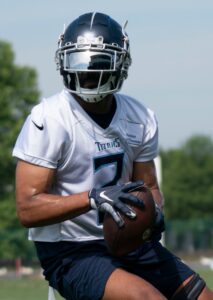 The Rams worked with Woods to find a fit, and for a brief stretch, it looked like the veteran would replace Julio Jones as Brown’s top sidekick. The draft-night trade changed the equation, and a player coming off a November ACL tear moved into the Titans’ WR1 spot. Tennessee took on Woods’ full contract — a $16.25MM-per-year deal agreed to in September 2020 — after Allen Robinson replaced Woods in Los Angeles, where Odell Beckham Jr. remains (for months now) on the horizon.
The Rams worked with Woods to find a fit, and for a brief stretch, it looked like the veteran would replace Julio Jones as Brown’s top sidekick. The draft-night trade changed the equation, and a player coming off a November ACL tear moved into the Titans’ WR1 spot. Tennessee took on Woods’ full contract — a $16.25MM-per-year deal agreed to in September 2020 — after Allen Robinson replaced Woods in Los Angeles, where Odell Beckham Jr. remains (for months now) on the horizon.
Prior to his knee injury, Woods was the steadiest wideout the Rams deployed under Sean McVay. The ex-Bills draftee became a solid all-around player, topping out below the Pro Bowl tier but posting back-to-back 1,100-yard seasons with Jared Goff (2018-19) as Cooper Kupp and Brandin Cooks battled injuries. The Titans can get out of Woods’ contract easily, as no guarantees remain after 2022. But with Brown gone and Burks not certain to play a big role early, the Titans need the 10th-year vet to find his old form — one undoubtedly boosted by McVay’s play-calling — fast.
Both Amadi and Lonnie Johnson relocated twice this offseason, the former being traded by both the Seahawks and Eagles and the latter — a former Texans second-rounder — dealt to the Chiefs and later waived. Each is a Titans backup. A sixth-round Panthers pick chosen before Matt Rhule‘s arrival, Daley (21 career starts, including nine in 2021) has a bit more experience than expected left guard starter Aaron Brewer (a UDFA with six career starts). Though more than half of those starts have come at left tackle (another seven came at left guard), Daley could be a guard option at some point in his contract year. He otherwise represents decent swing depth.
Free agency additions:
Quiet in terms of outside additions, the Titans did add a formerly well-paid tight end. Hooper made waves in 2020, signing a four-year, $42MM deal that at the time made him the highest-paid tight end in NFL history. As strange as that sounds, Hooper was coming off a 787-yard Pro Bowl year with the Falcons. And the Browns had money to spend. Hooper, 27, did not fare as well in Cleveland (780 yards from 2020-21) and became a cap casualty after two seasons.
Considering the Titans’ wideout situation, Hooper should be a bigger part of Tennessee’s passing attack than he was in Cleveland. The Titans opted not to tag Jonnu Smith last year and did not have a tight end clear 300 receiving yards. They need Hooper, a former third-round pick, to rediscover his Falcons form.
Re-signings:
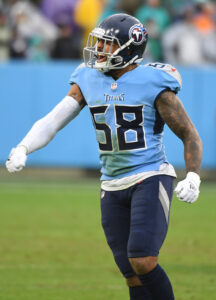 At the time of signing, it looked like Landry accepted a Titans-friendly deal. While not in the same class as the T.J. Watt–Joey Bosa–Myles Garrett trio whose $25MM-plus-AAV contracts may or may not have led to Aaron Donald‘s retirement threat, Landry still signed for $6MM less than Maxx Crosby ended up receiving three days later. The Titans’ edge anchor, who is coming off his first Pro Bowl year, is earning $20.25MM in his first season and does currently have a deal that ranks sixth among edges. But the second tier of this market, with cap growth restored, should be in for a spike soon. As that happens, having Landry tied to this deal should be valuable for Tennessee.
At the time of signing, it looked like Landry accepted a Titans-friendly deal. While not in the same class as the T.J. Watt–Joey Bosa–Myles Garrett trio whose $25MM-plus-AAV contracts may or may not have led to Aaron Donald‘s retirement threat, Landry still signed for $6MM less than Maxx Crosby ended up receiving three days later. The Titans’ edge anchor, who is coming off his first Pro Bowl year, is earning $20.25MM in his first season and does currently have a deal that ranks sixth among edges. But the second tier of this market, with cap growth restored, should be in for a spike soon. As that happens, having Landry tied to this deal should be valuable for Tennessee.
This week’s development — a Landry ACL tear sustained in practice — clouds both the optimism associated with this contract and could significantly impact Tennessee’s defensive capabilities. Robinson kept trying to address his OLB position opposite Landry, but his swings for Cameron Wake, Vic Beasley and Jadeveon Clowney each missed. Those failures led to Bud Dupree scoring a surprising (considering his November 2020 ACL tear) $16.5MM-per-year deal with $32.25MM fully guaranteed. Dupree totaled three sacks and eight QB hits last season, missing six games. Landry continued to provide cover, tallying a career-high 12 sacks and 22 QB knockdowns. Not having him this season will place a lot on Dupree’s shoulders and should force the Titans to make another move.
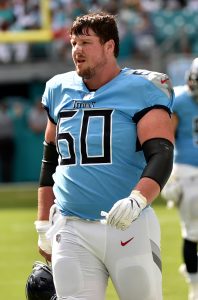 Beyond Jason Pierre-Paul (33) and Everson Griffen (34) and, to a lesser degree, Takkarist McKinley, who is coming off a December Achilles tear, the market — as should be expected in early September — is lean on edges. Will this be the Robert Quinn team? It now makes a lot of sense to discuss the out-of-place D-end with the rebuilding Bears. Even though the Pro Bowler (Bears-record 18.5 sacks in 2021) said he would not be thrilled with being traded a third time, the Titans are in a better position to contend compared to the Bears. Had Landry’s injury happened last week, now-Steeler Malik Reed was there for the taking from Denver.
Beyond Jason Pierre-Paul (33) and Everson Griffen (34) and, to a lesser degree, Takkarist McKinley, who is coming off a December Achilles tear, the market — as should be expected in early September — is lean on edges. Will this be the Robert Quinn team? It now makes a lot of sense to discuss the out-of-place D-end with the rebuilding Bears. Even though the Pro Bowler (Bears-record 18.5 sacks in 2021) said he would not be thrilled with being traded a third time, the Titans are in a better position to contend compared to the Bears. Had Landry’s injury happened last week, now-Steeler Malik Reed was there for the taking from Denver.
If the Titans do not make a move now, they are a team to watch for an early-season addition. Their backups (2021 fourth-rounder Rashad Weaver, who played 12 defensive snaps as a rookie), ex-Steeler UDFA Ola Adeniyi (2.5 sacks as a 2021 Titans backup) and Friday waiver claim Derrek Tuszka — cut by the Steelers this week — obviously represent a steep drop-off.
This is Jones’ third Titans contract. Signed as a free agent from the Texans in 2016, Jones and Taylor Lewan have been the constants during Henry’s All-Pro surge. Jones has become one of Robinson’s top moves, arriving during the GM’s first offseason and missing only one game in six seasons. Pro Football Focus has rated Jones as a top-11 center in each of his past five seasons, coinciding with Henry’s success and Tannehill’s midcareer turnaround.
The Titans managing to re-sign Jones on $6.75MM-per-year and $7MM-AAV deals since 2019 has represented excellent value. This middle-class contract could help the team keep rising right guard Nate Davis off the 2023 market, though that will be costly.
Notable losses:
- Jayon Brown, LB
- Darrynton Evans, RB (waived)
- Rashaan Evans, LB
- Anthony Firkser, TE
- D’Onta Foreman, RB
- Jackrabbit Jenkins, CB (released)
- Julio Jones, WR (released)
- Brett Kern, P (released)
- Kendall Lamm, T (released)
- David Quessenberry, OL
- Rodger Saffold, G (released)
- Buster Skrine, CB (retired)
 Saffold’s $12.8MM 2022 cap hit was an issue, and his release came two days after Landry’s extension. Were the Titans budgeting for a Brown extension at the time (March 10) as well? It is interesting Saffold became a cap casualty days before the Adams-Hill transactions changed the receiver market, thus leading Brown out of town.
Saffold’s $12.8MM 2022 cap hit was an issue, and his release came two days after Landry’s extension. Were the Titans budgeting for a Brown extension at the time (March 10) as well? It is interesting Saffold became a cap casualty days before the Adams-Hill transactions changed the receiver market, thus leading Brown out of town.
The Titans do have other players (Davis, Jeffery Simmons, Amani Hooker) on the extension radar, so keeping a veteran guard going into his age-34 season might have been a luxury. But Saffold was there for both Henry rushing-title seasons and graded as a top-12 PFF guard during those slates. The Bills will see how much the 13th-year blocker has left. For 2022 alone, this could be a tough loss for the Titans, who are set to go with a former UDFA (Brewer) as Saffold’s successor.
Julio Jones will be in the Hall of Fame early in his eligibility period, but there will not be many Titans highlights — perhaps the sideline catch against the Bills — on his Canton reel. Although the move produced more (434 yards, one touchdown) than the Titans’ largely forgotten but statistically brutal Randy Moss period, that 2010 pickup only cost a waiver claim. Acquiring Jones cost a second-round pick. Jones’ hamstring trouble has become chronic, and his seven missed games helped turn the Titans into a skeleton skill crew for a stretch last season.
Read more
 Drafted in Round 3 to be Henry’s top backup, Evans could not stay healthy. When Henry broke down last season, Foreman became an unlikely producer. Overtaking a shot Adrian Peterson, Foreman matched Henry in yards per carry (4.3) — albeit on 86 fewer totes — and produced three 100-yard outings despite making only three starts. The Titans let Foreman sign a low-cost Panthers deal and brought back Hilliard, who averaged 6.3 yards per carry (on 56 handoffs), for less. Given Henry’s status, Hilliard and fourth-rounder Hassan Haskins are on standby.
Drafted in Round 3 to be Henry’s top backup, Evans could not stay healthy. When Henry broke down last season, Foreman became an unlikely producer. Overtaking a shot Adrian Peterson, Foreman matched Henry in yards per carry (4.3) — albeit on 86 fewer totes — and produced three 100-yard outings despite making only three starts. The Titans let Foreman sign a low-cost Panthers deal and brought back Hilliard, who averaged 6.3 yards per carry (on 56 handoffs), for less. Given Henry’s status, Hilliard and fourth-rounder Hassan Haskins are on standby.
Jenkins, whose name change seemingly received less attention than Shaquille Leonard‘s less dramatic adjustment or Robbie Anderson merely changing the ending to his, remains unsigned. The 33-year-old defender has been with three teams over the past two seasons. He did give the Titans 13 starts in his one-and-done tenure; PFF graded Jenkins as the top Titans corner. But Tennessee has drafted first- or second-round corners in three straight years. Skrine’s summer retirement clears the way for the Titans to go full-speed with rookie-contract corners, with 2021 third-rounder Elijah Molden figuring to man the slot alongside the higher-drafted players.
Draft:
Nick Westbrook-Ikhine stands to be Woods’ outside complement; Burks will be a situational player to start the season, The Athletic’s John Rexrode writes. Somewhat of a raw talent who had weight issues at Arkansas, playing north of 240 pounds at points, Burks will need to move into the starting lineup as a rookie. By 2023, the ex-Razorback star should be expected to be the centerpiece of the Titans’ aerial attack.
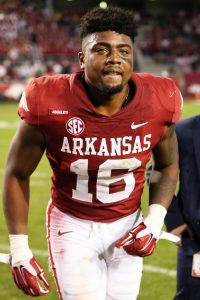 Burks produced a 1,104-yard junior season — including a 179-yard display against Alabama — and became this year’s sixth wideout drafted. Burks compounded his rawness by missing stretches of Tennessee’s offseason program; receivers coach Rob Moore confirmed Burks deals with asthma. The ceiling here is undeniable, but the Titans exchanging a proven pass catcher for one who obviously needs time to grow into that status does concern for the current team’s prospects.
Burks produced a 1,104-yard junior season — including a 179-yard display against Alabama — and became this year’s sixth wideout drafted. Burks compounded his rawness by missing stretches of Tennessee’s offseason program; receivers coach Rob Moore confirmed Burks deals with asthma. The ceiling here is undeniable, but the Titans exchanging a proven pass catcher for one who obviously needs time to grow into that status does concern for the current team’s prospects.
It will be unusual to see a team’s fifth-round receiver play more often than the player chosen in Round 1, but that may well take place. After a strong offseason, Philips is set to have a regular role as a slot target from the start. Philips produced back-to-back 700-plus-yard seasons as a Bruins upperclassman.
Tennessee ranked 25th in pass defense last season, and PFF did not rank any of its returning corners among the top 50 at the position. The team was missing 2021 first-rounder Caleb Farley, and 2020 second-rounder Kristian Fulton performed better than he did in an abbreviated rookie season. McCreary impressed in training camp and rounds out an intriguing quartet of Titans corners. All of them have at least two seasons remaining on their rookie contracts, creating the potential for the Fulton-Farley-Molden-McCreary group to play together through at least 2023. More tape than measurables, the 6-foot rookie — fresh off a first-team All-American season — could be eased into action as a pro as well. That will depend on Farley’s return from an ACL tear.
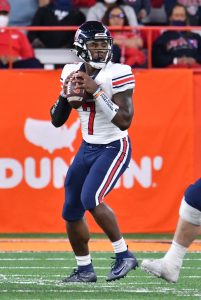 Petit-Frere has beaten out Radunz for the Titans’ right tackle gig. He will be the team’s fourth primary right tackle in four seasons, following Jack Conklin, Dennis Kelly and David Quessenberry. The Titans declining Conklin’s fifth-year option set them adrift at this position, and the Isaiah Wilson debacle doubles as one of the worst draft misses in recent memory. A second-rounder out of North Dakota State, Radunz has been unable to commandeer the gig for which he was drafted. The onus shifts to Petit-Frere — a first-team All-Big Ten right tackle in 2021 and the Buckeyes’ two-year starter there — to stop the revolving door.
Petit-Frere has beaten out Radunz for the Titans’ right tackle gig. He will be the team’s fourth primary right tackle in four seasons, following Jack Conklin, Dennis Kelly and David Quessenberry. The Titans declining Conklin’s fifth-year option set them adrift at this position, and the Isaiah Wilson debacle doubles as one of the worst draft misses in recent memory. A second-rounder out of North Dakota State, Radunz has been unable to commandeer the gig for which he was drafted. The onus shifts to Petit-Frere — a first-team All-Big Ten right tackle in 2021 and the Buckeyes’ two-year starter there — to stop the revolving door.
Willis’ slide to Round 3 is one of the most memorable in modern draft history, considering the first-round connections the small-school quarterback generated. The dual-threat QB seems no rival for Tannehill in 2022, being viewed as a project and being yanked from a preseason game for running too much. But Willis did win the backup job over Logan Woodside.
The Auburn transfer’s college resume (1,822 rushing yards, 27 TDs in two seasons at Liberty) will probably come up if Tannehill struggles, as young QB investments are rather popular among fans of teams with non-elite passers. But this seems like a multiyear training program for a player teams let fall to No. 86 overall. Still, Tannehill was a severe injury risk in Miami (25 missed games from 2016-18) due mostly to knee trouble. Since taking over for Marcus Mariota in October 2019, Tannehill has perfect attendance. But it would be interesting to see what the Titans do if their starter’s run of good health suddenly stops.
Extensions and restructures:
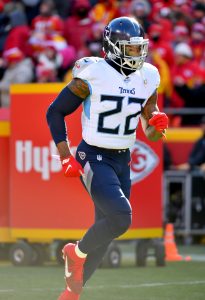 Henry now leads all running backs in cash for 2022, but the Titans put half of his raise into per-game roster bonuses. This potential $2MM bump is a nice carrot that can be interpreted in multiple ways.
Henry now leads all running backs in cash for 2022, but the Titans put half of his raise into per-game roster bonuses. This potential $2MM bump is a nice carrot that can be interpreted in multiple ways.
The Titans are considering another extension for their superstar back, despite a 2021 Jones fracture costing him eight games. Henry’s importance to Tennessee’s offense notwithstanding, teams do not make a habit of doling out big contracts to 29-year-old running backs. Henry, who will turn 29 in January, is still signed through 2023. The former Heisman recipient would be a remarkable winner among modern backs were he to secure a second lucrative extension at that age.
This week’s transaction also made Henry’s contract tougher to shed. After less than $4MM in dead money would have come with a Henry 2023 release, the restructure — which added three void years to Henry’s contract — now involves a $10.2MM dead-money hit. Talk of a Henry release is obviously premature, given his onslaught over the past three years. But if he suffered another major injury this season, the Titans could be thinking of getting out of the four-year, $50MM deal they authorized at the 2020 tag deadline.
Henry was cruising toward a Jim Brown-esque third straight rushing title and still finished as a top-10 rusher last season, but even as he missed the eight games, the Titans put 900 carries on his odometer from 2019-21. That leads the NFL by 89 in that span. Collecting an additional $2MM is a nice bonus for one of the great players in the franchise’s Tennessee history, because recent running back history tells us Henry probably does not have much longer to be a high-earning player. Henry might only be still able to be penciled in for a monster workload because of the two years spent as DeMarco Murray‘s wingman to start his career.
Other:
Following a run of three consecutive playoff berths — the franchise’s first such accomplishment since Warren Moon‘s Run and Shoot Oilers operation went to seven straight postseasons from 1987-93 — Robinson and Vrabel were extension locks. This is Robinson’s third Titans contract and Vrabel’s second, and considering what the pair has achieved despite not employing a top-end quarterback or elite defense, the additional commitment is certainly earned.
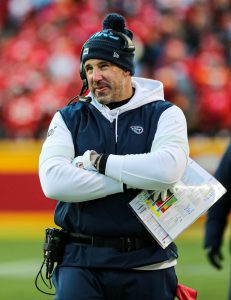 Vrabel, 47, and Matt LaFleur helmed shorthanded teams to No. 1 seeds last season, but LaFleur had Aaron Rodgers buttressing that effort. At one point, Vrabel’s team was playing without Henry, A.J. Brown and Julio Jones. Each also missed parts of other games, yet the Titans ripped through a stretch in which they won five straight games against teams that went to the 2020 playoffs. Vrabel does not call plays, but there is now an extended sample size of Tennessee reeling off winning seasons — the last two producing more than nine victories, an ever-present Titans hurdle during the late 2010s — that cannot be ignored when discussing Vrabel’s value.
Vrabel, 47, and Matt LaFleur helmed shorthanded teams to No. 1 seeds last season, but LaFleur had Aaron Rodgers buttressing that effort. At one point, Vrabel’s team was playing without Henry, A.J. Brown and Julio Jones. Each also missed parts of other games, yet the Titans ripped through a stretch in which they won five straight games against teams that went to the 2020 playoffs. Vrabel does not call plays, but there is now an extended sample size of Tennessee reeling off winning seasons — the last two producing more than nine victories, an ever-present Titans hurdle during the late 2010s — that cannot be ignored when discussing Vrabel’s value.
Robinson hired Vrabel despite the ex-Patriot linebacker/goal-line specialist only having one year of NFL coordinator experience, and that season came when the Texans’ defense struggled. The hire has proven to be a good one. As for Robinson, the ex-Buccaneers and Patriots exec has hits and misses.
The Titans withstood the Wilson whiff, the group of OLB misfires and managed to secure a bye despite the Jones deal not panning out. This season may provide the verdict if the Henry extension was right, but that may already be a win considering 2020’s 2,000-yard showing. Taking Tannehill off the Dolphins’ payroll for fourth- and seventh-round picks was easier as Miami was gutting its roster in 2019, but the former first-rounder has done the most to keep the Titans afloat after Marcus Mariota‘s injury-aided descent. How the Brown-for-Burks call goes will be another key Robinson legacy point, however.
While edge defenders passed Aaron Donald on his previous Rams contract, no interior D-lineman did. Donald’s new deal ($31.6MM per year) has created a gargantuan gulf between one player and the field at a position. Just as the quarterback market did when Patrick Mahomes was tied to a deal $10MM north of anyone else (due to a 10-year contract), Donald being $10MM north of the rest of the NFL’s D-tackles will not last. The Titans look to have the player set to bridge the gap.
After his first Pro Bowl season, Simmons is set to command a contract that could approach $25MM per annum. His minicamp hold-in effort signaled a desire for a new deal now, but for players with fifth-year options, teams like to wait until after Year 4 for extensions. The 2019 first-rounder broke through for 8.5 regular-season sacks and 12 tackles for loss, before destroying the beleaguered Bengals interior O-line for three more sacks in the playoffs. Simmons, 25, profiles as the top candidate to bring the D-tackle field closer to Donald, creating potential complications when his negotiations begin. Leonard Williams and DeForest Buckner are currently the second-highest-paid interior D-linemen, tied to $21MM-AAV accords.
Top 10 cap charges for 2022:
- Ryan Tannehill, QB: $38.6MM
- Bud Dupree, OLB: $19.2MM
- Taylor Lewan, T: $14.7MM
- Robert Woods, WR: $10MM
- Derrick Henry, RB: $9.8MM
- Denico Autry, DL: $8.65MM
- Kevin Byard, S: $7.06MM
- Harold Landry, OLB: $5.1MM
- Jeffery Simmons, DL: $4.1MM
- Zach Cunningham, LB: $3.99MM
After the Falcons, Packers and Vikings adjusted their quarterbacks’ cap hits, Atlanta doing so by trading Matt Ryan, no NFLer’s 2022 cap figure tops Tannehill’s. The 11th-year QB counted only $11.1MM toward Tennesse’s cap in 2021. Two seasons remain on his four-year, $118MM extension — now a lower-middle-class QB contract. But the deal does call for big cap hits in 2022 and ’23 ($36.6MM). Tannehill’s 2022 season will probably determine if he receives another Titans extension, while obviously playing the lead role in this year’s team overcoming a tough offseason.
From Simmons to Byard to a cornerback group full of highly touted prospects, young talent is present in Tennessee. While the AFC South is either this year’s third- or fourth-strongest AFC division, higher hurdles exist between the Brown- and Landry-less Titans and an approach of last year’s 12-5 record. If the new faces at receiver and on the O-line cause a Tannehill step back, the Titans could be in line for a major roster shift in 2023.
 Jim Irsay had made it no secret he wanted Wentz gone, limiting Colts GM Chris Ballard’s leverage. It is not known what other teams were in the Wentz market. Despite what appeared to be a limited market, Indianapolis sent Wentz to Washington for a surprising haul. The Commanders initially offered fourth- and sixth-rounders for Wentz, but Ballard drove them to a third, a conditional third that could climb to a second, and a 2022 Round 2 pick swap that allowed the Colts to move up five spots. Similar to the terms of 2021’s Eagles-Colts Wentz deal, if the QB plays 70% of the Commanders’ snaps this year, the 2023 pick becomes a second-rounder.
Jim Irsay had made it no secret he wanted Wentz gone, limiting Colts GM Chris Ballard’s leverage. It is not known what other teams were in the Wentz market. Despite what appeared to be a limited market, Indianapolis sent Wentz to Washington for a surprising haul. The Commanders initially offered fourth- and sixth-rounders for Wentz, but Ballard drove them to a third, a conditional third that could climb to a second, and a 2022 Round 2 pick swap that allowed the Colts to move up five spots. Similar to the terms of 2021’s Eagles-Colts Wentz deal, if the QB plays 70% of the Commanders’ snaps this year, the 2023 pick becomes a second-rounder. Taking issue with Wentz’s leadership, erratic play and refusal to be vaccinated against COVID-19, issues leading to a late-season Colts collapse, Irsay ordered his staff to ditch the six-year veteran — who cost Indy first- and second-round picks. Although the Commanders were high on Wentz’s arm strength and 6-foot-5 frame, he was far from their first choice. Wilson and Aaron Rodgers could not be acquired, and Washington even sent out an Andrew Luck feeler. The former Colts star appears to be content in retirement. In Wentz, however, the team probably has its best quarterback since before a pre-injury Alex Smith.
Taking issue with Wentz’s leadership, erratic play and refusal to be vaccinated against COVID-19, issues leading to a late-season Colts collapse, Irsay ordered his staff to ditch the six-year veteran — who cost Indy first- and second-round picks. Although the Commanders were high on Wentz’s arm strength and 6-foot-5 frame, he was far from their first choice. Wilson and Aaron Rodgers could not be acquired, and Washington even sent out an Andrew Luck feeler. The former Colts star appears to be content in retirement. In Wentz, however, the team probably has its best quarterback since before a pre-injury Alex Smith. Norwell, 30, fetched a monster free agency deal from the Jaguars in 2018. That came after the Panthers prioritized Turner — via a four-year, $45MM deal — and let Norwell walk. Jacksonville did not see Norwell replicate his contract-year All-Pro season, but Pro Football Focus still gave the former UDFA top-30 grades from 2018-20. Norwell nevertheless took a pay cut after the 2020 season. Last year, Norwell dropped outside PFF’s top 40 at guard.
Norwell, 30, fetched a monster free agency deal from the Jaguars in 2018. That came after the Panthers prioritized Turner — via a four-year, $45MM deal — and let Norwell walk. Jacksonville did not see Norwell replicate his contract-year All-Pro season, but Pro Football Focus still gave the former UDFA top-30 grades from 2018-20. Norwell nevertheless took a pay cut after the 2020 season. Last year, Norwell dropped outside PFF’s top 40 at guard. PFF’s numbers are not the end-all, be-all, but the advanced metrics site gave Leno a career-high grade and slotted him as its 12th-best tackle last season. That marked a staggering bounce-back year for the longtime Bears left tackle, whom Chicago cut shortly after the 2021 draft. Washington took a $5MM flier on Leno last year and will now look to him to be a longer-term answer. Washington had cycled through blindsides since the 2019 Trent Williams fiasco, going from Donald Penn to Lucas to Leno. The former Bears seventh-rounder started 17 Washington games and, reminding of Morgan Moses, has not missed a contest since his 2014 rookie year.
PFF’s numbers are not the end-all, be-all, but the advanced metrics site gave Leno a career-high grade and slotted him as its 12th-best tackle last season. That marked a staggering bounce-back year for the longtime Bears left tackle, whom Chicago cut shortly after the 2021 draft. Washington took a $5MM flier on Leno last year and will now look to him to be a longer-term answer. Washington had cycled through blindsides since the 2019 Trent Williams fiasco, going from Donald Penn to Lucas to Leno. The former Bears seventh-rounder started 17 Washington games and, reminding of Morgan Moses, has not missed a contest since his 2014 rookie year. Later in the offseason, the Buccaneers managed to add another former Falcons wideout in Julio Jones. The former All-Pro receiver hasn’t compiled more than 1,000 yards since 2019, and his numbers dropped off during his only season in Tennessee in 2021, as the veteran finished with career-lows across the board (31 receptions, 434 yards, one touchdown). Still, his track record should give him the nod on the depth chart ahead of Gage. Either way, when considering Godwin’s ongoing recovery from his ACL tear, it’s clear why the organization wasn’t going to deny too much depth at the position.
Later in the offseason, the Buccaneers managed to add another former Falcons wideout in Julio Jones. The former All-Pro receiver hasn’t compiled more than 1,000 yards since 2019, and his numbers dropped off during his only season in Tennessee in 2021, as the veteran finished with career-lows across the board (31 receptions, 434 yards, one touchdown). Still, his track record should give him the nod on the depth chart ahead of Gage. Either way, when considering Godwin’s ongoing recovery from his ACL tear, it’s clear why the organization wasn’t going to deny too much depth at the position. Whlle Tom Brady and his top two receivers will be back in 2022, the offense will look a bit different. The biggest loss comes at tight end, as future Hall of Famer Rob Gronkowski decided to call it a career. After returning from a brief retirement to appear in 16 games for the Bucs in 2020, Gronk once again dealt with injuries in 2021. Despite sitting out five games, the tight end still managed to finish the season with 802 receiving yards, his highest total since the 2017 season. Gronk also continued being a force in the end zone, hauling in six touchdowns. While O.J. Howard never really clicked with Brady, he’s another notable loss at the position, and the Buccaneers will be hoping some newcomers (primarily veteran Kyle Rudolph and rookie Cade Otton) can pick up some of the slack in 2022.
Whlle Tom Brady and his top two receivers will be back in 2022, the offense will look a bit different. The biggest loss comes at tight end, as future Hall of Famer Rob Gronkowski decided to call it a career. After returning from a brief retirement to appear in 16 games for the Bucs in 2020, Gronk once again dealt with injuries in 2021. Despite sitting out five games, the tight end still managed to finish the season with 802 receiving yards, his highest total since the 2017 season. Gronk also continued being a force in the end zone, hauling in six touchdowns. While O.J. Howard never really clicked with Brady, he’s another notable loss at the position, and the Buccaneers will be hoping some newcomers (primarily veteran Kyle Rudolph and rookie Cade Otton) can pick up some of the slack in 2022. On the offensive line, Brady will have to get used to a pair of new starting offensive guards. Despite earning his first career Pro Bowl nod in 2021, Ali Marpet decided to retire after seven NFL seasons. The offensive guard started each of his 16 games in 2021, with Pro Football Focus grading him as the NFL’s seventh-best guard. Alex Cappa, who started 17 games last season, was 19th on that same list, and that’s a big reason why the former third-round pick was able to secure a $35MM deal from the Bengals. Trade acquisition Shaq Mason will slide into one of the starting guard spots, with rookie second-round pick Luke Goedeke also getting a nod.
On the offensive line, Brady will have to get used to a pair of new starting offensive guards. Despite earning his first career Pro Bowl nod in 2021, Ali Marpet decided to retire after seven NFL seasons. The offensive guard started each of his 16 games in 2021, with Pro Football Focus grading him as the NFL’s seventh-best guard. Alex Cappa, who started 17 games last season, was 19th on that same list, and that’s a big reason why the former third-round pick was able to secure a $35MM deal from the Bengals. Trade acquisition Shaq Mason will slide into one of the starting guard spots, with rookie second-round pick Luke Goedeke also getting a nod. While the Buccaneers let a lot of players walk, they also made sure to maintain some continuity on both sides of the ball. The most notable re-signing was wideout Chris Godwin, who has transformed into one of the NFL’s most consistent receivers and one of Tom Brady‘s preferred targets. Despite an ACL tear that ended his 2021 season prematurely (and could end up lingering into the 2022 campaign), the organization still felt comfortable giving him a three-year deal worth $60MM, including $40MM guaranteed. Assuming Godwin fully recovers from his injury, that contract could prove to be a bargain in later years.
While the Buccaneers let a lot of players walk, they also made sure to maintain some continuity on both sides of the ball. The most notable re-signing was wideout Chris Godwin, who has transformed into one of the NFL’s most consistent receivers and one of Tom Brady‘s preferred targets. Despite an ACL tear that ended his 2021 season prematurely (and could end up lingering into the 2022 campaign), the organization still felt comfortable giving him a three-year deal worth $60MM, including $40MM guaranteed. Assuming Godwin fully recovers from his injury, that contract could prove to be a bargain in later years. The Cowboys have a few lucrative extensions on their books — most notably the deals doled out to Dak Prescott and Ezekiel Elliott — and have needed to get out on certain players mid-prime. Byron Jones left in 2020; the team turned out to be wise not to beat out the Dolphins for him. Cooper is not positioned for immediate success, with Deshaun Watson‘s suspension leaving the Browns with their Jacoby Brissett backup plan for 11 games. But, as Michael Gallup‘s ACL rehab and James Washington‘s foot fracture leave the Cowboys without much experience at the position, Cooper’s $20MM salary would not appear too troublesome now.
The Cowboys have a few lucrative extensions on their books — most notably the deals doled out to Dak Prescott and Ezekiel Elliott — and have needed to get out on certain players mid-prime. Byron Jones left in 2020; the team turned out to be wise not to beat out the Dolphins for him. Cooper is not positioned for immediate success, with Deshaun Watson‘s suspension leaving the Browns with their Jacoby Brissett backup plan for 11 games. But, as Michael Gallup‘s ACL rehab and James Washington‘s foot fracture leave the Cowboys without much experience at the position, Cooper’s $20MM salary would not appear too troublesome now. Peters’ P-squad status notwithstanding, this marks by far Dallas’ most important free agency add. Although the team is giving the likely Hall of Famer a ramp-up period, it will mark a bit of a strange turn if/when first-rounder Tyler Smith slides to left tackle for a one- or two-game period and then moves back to a position at which he has far less experience. Dallas drafted its younger Smith blocker as its left tackle of the future, and while the Tulsa product starting at two positions in his first NFL month will be odd, Peters’ presence should make that early instability worthwhile.
Peters’ P-squad status notwithstanding, this marks by far Dallas’ most important free agency add. Although the team is giving the likely Hall of Famer a ramp-up period, it will mark a bit of a strange turn if/when first-rounder Tyler Smith slides to left tackle for a one- or two-game period and then moves back to a position at which he has far less experience. Dallas drafted its younger Smith blocker as its left tackle of the future, and while the Tulsa product starting at two positions in his first NFL month will be odd, Peters’ presence should make that early instability worthwhile. Tyron’s injury will give Peters a chance to become the fourth tackle to play an age-40 season, following Hall of Famer Jackie Slater, 20-year veteran Ray Brown (1985-2004) and Andrew Whitworth. Peters (nine Pro Bowls, two first-team All-Pro nods) performing what could be his final NFL assignment well — for perhaps the NFL’s highest-profile team — will be an obvious boon for the 19th-year veteran’s chances at a first-ballot induction.
Tyron’s injury will give Peters a chance to become the fourth tackle to play an age-40 season, following Hall of Famer Jackie Slater, 20-year veteran Ray Brown (1985-2004) and Andrew Whitworth. Peters (nine Pro Bowls, two first-team All-Pro nods) performing what could be his final NFL assignment well — for perhaps the NFL’s highest-profile team — will be an obvious boon for the 19th-year veteran’s chances at a first-ballot induction. While the loose connections to Bobby Wagner generated interest, the Cowboys were not a serious contender for the future first-ballot Hall of Famer. Barr and Micah Parsons on the same defense nevertheless intrigues, though obviously not as much as it would have if Barr’s 2010s version were here. A college edge rusher, Barr transitioned to a 4-3 outside linebacker role under current Dallas assistant George Edwards in Minnesota. Parsons’ time as a rusher could open the door for more Barr looks on the second level.
While the loose connections to Bobby Wagner generated interest, the Cowboys were not a serious contender for the future first-ballot Hall of Famer. Barr and Micah Parsons on the same defense nevertheless intrigues, though obviously not as much as it would have if Barr’s 2010s version were here. A college edge rusher, Barr transitioned to a 4-3 outside linebacker role under current Dallas assistant George Edwards in Minnesota. Parsons’ time as a rusher could open the door for more Barr looks on the second level. The franchise’s only MVP winner, Ryan obviously holds countless franchise records. The former No. 3 overall pick performed admirably through Atlanta’s low seasons as well as its highs. Injuries and a lack of surrounding talent have limited his win totals over the years, but the resilient quarterback still managed to win 120 games over his 14 seasons. Ryan’s MVP season fueled his team to Super Bowl LI. He threw 38 touchdown passes to just seven interceptions en route to a league-leading marks in quarterback rating (117.1) and QBR (79.6) that year. Perhaps a perfect display of Ryan’s consistency amid his team’s shortcomings: two years later, Ryan nearly matched his MVP output with 35 TD passes and seven INTs. The team’s record that year: 7-9.
The franchise’s only MVP winner, Ryan obviously holds countless franchise records. The former No. 3 overall pick performed admirably through Atlanta’s low seasons as well as its highs. Injuries and a lack of surrounding talent have limited his win totals over the years, but the resilient quarterback still managed to win 120 games over his 14 seasons. Ryan’s MVP season fueled his team to Super Bowl LI. He threw 38 touchdown passes to just seven interceptions en route to a league-leading marks in quarterback rating (117.1) and QBR (79.6) that year. Perhaps a perfect display of Ryan’s consistency amid his team’s shortcomings: two years later, Ryan nearly matched his MVP output with 35 TD passes and seven INTs. The team’s record that year: 7-9. Now, the Falcons are staring at two possibilities concerning this season at quarterback. It could be territory the team has not traversed for most of the 21st century. Excluding a transitionary 2007 season that saw games started by quarterbacks Joey Harrington, Chris Redman, and Byron Leftwich, the Falcons have gone into 19 of their previous 20 seasons knowing that either Michael Vick or Ryan would be their starter. Atlanta will hope that 2022 is another transitory situation that will lead to the next long-tenured quarterback in red and black.
Now, the Falcons are staring at two possibilities concerning this season at quarterback. It could be territory the team has not traversed for most of the 21st century. Excluding a transitionary 2007 season that saw games started by quarterbacks Joey Harrington, Chris Redman, and Byron Leftwich, the Falcons have gone into 19 of their previous 20 seasons knowing that either Michael Vick or Ryan would be their starter. Atlanta will hope that 2022 is another transitory situation that will lead to the next long-tenured quarterback in red and black. Once again, the biggest headline here comes at quarterback. The Falcons reunited Mariota with Smith, the Titans’ offensive coordinator during the former No. 2 overall pick’s last season in Tennessee. The team signed the 28-year-old on the same day it traded away Ryan. The sequence of transactions made it clear that Mariota was brought in to be Ryan’s successor. The intention came to fruition when Mariota was named the team’s starting quarterback two weeks before the preseason.
Once again, the biggest headline here comes at quarterback. The Falcons reunited Mariota with Smith, the Titans’ offensive coordinator during the former No. 2 overall pick’s last season in Tennessee. The team signed the 28-year-old on the same day it traded away Ryan. The sequence of transactions made it clear that Mariota was brought in to be Ryan’s successor. The intention came to fruition when Mariota was named the team’s starting quarterback two weeks before the preseason. Carter is a younger defender who delivered decent production when healthy over his four years in New York. The former Giants third-round pick is expected to start alongside fellow free agent addition Evans and Mykal Walker. Evans was brought in to compete with and potentially replace Deion Jones. The latter’s IR stay, which comes after an offseason shoulder surgery, has tabled that matter until at least October. Evans was a full-time starter for much of his rookie contract after being drafted in the first round by Tennessee. As Mariota is reuniting with Smith on offense, Evans is linking back up with ex-Titans defensive coordinator Dean Pees.
Carter is a younger defender who delivered decent production when healthy over his four years in New York. The former Giants third-round pick is expected to start alongside fellow free agent addition Evans and Mykal Walker. Evans was brought in to compete with and potentially replace Deion Jones. The latter’s IR stay, which comes after an offseason shoulder surgery, has tabled that matter until at least October. Evans was a full-time starter for much of his rookie contract after being drafted in the first round by Tennessee. As Mariota is reuniting with Smith on offense, Evans is linking back up with ex-Titans defensive coordinator Dean Pees. Atlanta has experience in long-term relationships with kickers. The team enjoyed 11 strong years out of place kicker Matt Bryant and nine years with punter Matt Bosher, moving on from both in 2019. That year brought Koo’s Falcons introduction. Koo joined the team in Week 10 and, after converting 23 of his 26 field goal attempts, never relinquished the kicking job.
Atlanta has experience in long-term relationships with kickers. The team enjoyed 11 strong years out of place kicker Matt Bryant and nine years with punter Matt Bosher, moving on from both in 2019. That year brought Koo’s Falcons introduction. Koo joined the team in Week 10 and, after converting 23 of his 26 field goal attempts, never relinquished the kicking job. When Samuel fired off his trade request, no member of the talented sect of Day 2 receiver draftees from the 2019 class had landed extensions. The 49ers’ initial offer was believed to have come in south of $19MM per year. As Davante Adams and Tyreek Hill were resetting the market — an effort that trickled down to the lot of fourth-year receiver extension candidates — a line of disgruntled pass catchers formed. Samuel was connected to a $25MM-per-year demand weeks before A.J. Brown secured that payout after a trade, but the 49ers held firm to protect their star receiving talent.
When Samuel fired off his trade request, no member of the talented sect of Day 2 receiver draftees from the 2019 class had landed extensions. The 49ers’ initial offer was believed to have come in south of $19MM per year. As Davante Adams and Tyreek Hill were resetting the market — an effort that trickled down to the lot of fourth-year receiver extension candidates — a line of disgruntled pass catchers formed. Samuel was connected to a $25MM-per-year demand weeks before A.J. Brown secured that payout after a trade, but the 49ers held firm to protect their star receiving talent. When the 49ers finally extended Samuel, they still had Garoppolo’s $26.9MM cap number atop their payroll. But that number has since dropped below $14MM, giving the team much-needed flexibility entering the season. Although it took nearly the full offseason for the 49ers to find a solution, their creative Garoppolo plan may prove beneficial in more ways than one.
When the 49ers finally extended Samuel, they still had Garoppolo’s $26.9MM cap number atop their payroll. But that number has since dropped below $14MM, giving the team much-needed flexibility entering the season. Although it took nearly the full offseason for the 49ers to find a solution, their creative Garoppolo plan may prove beneficial in more ways than one. Seattle was rumored to be lingering as a free agency destination, and Cleveland — with Deshaun Watson‘s suspension increased to 11 games — did not get aggressive on Garoppolo to overtake Jacoby Brissett. This led to an outcome the 49ers teased but ultimately did not anticipate happening. Garoppolo’s $24.2MM base salary dropped to $6.5MM, with an incentive package allowing his reworked contract to max out at $15.45MM. Considering the incentives are tied to Garoppolo playing, his return for a sixth 49ers season invites questions about Trey Lance.
Seattle was rumored to be lingering as a free agency destination, and Cleveland — with Deshaun Watson‘s suspension increased to 11 games — did not get aggressive on Garoppolo to overtake Jacoby Brissett. This led to an outcome the 49ers teased but ultimately did not anticipate happening. Garoppolo’s $24.2MM base salary dropped to $6.5MM, with an incentive package allowing his reworked contract to max out at $15.45MM. Considering the incentives are tied to Garoppolo playing, his return for a sixth 49ers season invites questions about Trey Lance. Cooper Kupp and Odell Beckham Jr. carved up the 49ers’ secondary during the Rams’ NFC title game triumph, which reversed the Shanahan-over-Sean McVay trend that had formed in this rivalry. And Ward’s contract is the biggest cornerback deal the 49ers have authorized under the Shanahan-Lynch regime. The 49ers entered 2021 light at corner; their 2022 outlook is a bit rosier after poaching Ward from the Chiefs.
Cooper Kupp and Odell Beckham Jr. carved up the 49ers’ secondary during the Rams’ NFC title game triumph, which reversed the Shanahan-over-Sean McVay trend that had formed in this rivalry. And Ward’s contract is the biggest cornerback deal the 49ers have authorized under the Shanahan-Lynch regime. The 49ers entered 2021 light at corner; their 2022 outlook is a bit rosier after poaching Ward from the Chiefs. Ward’s struggles against Ja’Marr Chase became late-season highlight fodder, but he was one of the top corners on the market. Ward, 26, fetched the second-most money among UFA corners this offseason — behind only J.C. Jackson — and will be expected to anchor the 49ers’ coverage corps. Playing on a defense that houses Nick Bosa, Arik Armstead and Fred Warner stands to help Ward succeed in doing so.
Ward’s struggles against Ja’Marr Chase became late-season highlight fodder, but he was one of the top corners on the market. Ward, 26, fetched the second-most money among UFA corners this offseason — behind only J.C. Jackson — and will be expected to anchor the 49ers’ coverage corps. Playing on a defense that houses Nick Bosa, Arik Armstead and Fred Warner stands to help Ward succeed in doing so. The 49ers were able to bring back some key depth pieces and/or unexpected starters at league-minimum prices. Although Hurst is out for the season and Verrett has a strong case as the NFL’s most injury-prone player (he is on the team’s reserve/PUP list to start the season), the other returning role players figure to see frequent time.
The 49ers were able to bring back some key depth pieces and/or unexpected starters at league-minimum prices. Although Hurst is out for the season and Verrett has a strong case as the NFL’s most injury-prone player (he is on the team’s reserve/PUP list to start the season), the other returning role players figure to see frequent time. fact that they each went to safeties comes as little shock, with both starting spots needing to be filled. Mathieu spent much more time on the free agent market than his pedigree would have suggested, but he will still manage to reach the eight-figure-per-year mark with his hometown team should he maximize the pact’s incentives. The LSU alum and New Orleans native drew interest from teams like the Rams, Steelers and Eagles, but the Saints had long been considered his eventual landing spot in the buildup to his signing.
fact that they each went to safeties comes as little shock, with both starting spots needing to be filled. Mathieu spent much more time on the free agent market than his pedigree would have suggested, but he will still manage to reach the eight-figure-per-year mark with his hometown team should he maximize the pact’s incentives. The LSU alum and New Orleans native drew interest from teams like the Rams, Steelers and Eagles, but the Saints had long been considered his eventual landing spot in the buildup to his signing. Just as was the case with Mathieu, the Landry signing represented a homecoming. The LSU product’s deal also features incentives which can double its value; even in that event, the contract would fall well short of the $20MM per year he was once reported to be seeking. Still, the one-year pact gives Landry a chance to move forward from an injury-riddled final year with the Browns, re-establishing his worth as a dependable slot receiver. He will face notable competition for targets, but the former Pro Bowler (if healthy) could be in line for a productive season, and a resultant financial windfall.
Just as was the case with Mathieu, the Landry signing represented a homecoming. The LSU product’s deal also features incentives which can double its value; even in that event, the contract would fall well short of the $20MM per year he was once reported to be seeking. Still, the one-year pact gives Landry a chance to move forward from an injury-riddled final year with the Browns, re-establishing his worth as a dependable slot receiver. He will face notable competition for targets, but the former Pro Bowler (if healthy) could be in line for a productive season, and a resultant financial windfall.
 Watson signed a $39MM-per-year deal with the Texans in August 2020. Although that contract seems like it was authorized a decade ago, its extension years were set to begin in 2022. Watson played one season on what was a top-five QB contract over its first two years. Amid the early parts of a scandal that saw criminal and civil cases come from more than two dozen women accusing Watson of sexual misconduct and/or sexual assault during massage therapy sessions, the Texans then made him a 17-game healthy scratch. Despite Watson’s turmoil, quarterbacks of this caliber squarely in their primes are almost never available. Teams acted accordingly, and the Browns one-upped the field.
Watson signed a $39MM-per-year deal with the Texans in August 2020. Although that contract seems like it was authorized a decade ago, its extension years were set to begin in 2022. Watson played one season on what was a top-five QB contract over its first two years. Amid the early parts of a scandal that saw criminal and civil cases come from more than two dozen women accusing Watson of sexual misconduct and/or sexual assault during massage therapy sessions, the Texans then made him a 17-game healthy scratch. Despite Watson’s turmoil, quarterbacks of this caliber squarely in their primes are almost never available. Teams acted accordingly, and the Browns one-upped the field. The ire coming at the Browns from most of the NFL universe aside, Watson is probably still a top-10 quarterback or close to it. His three full seasons produced 13th-, seventh- and 12th-place QBR rankings. The Browns, who passed on the Clemson star two regimes ago by trading out of the No. 12 slot to send him to Houston, will upgrade from Baker Mayfield. Watson, 27 next week, led the NFL in passing yards two years ago and lifted flawed Texans teams to back-to-back playoff brackets.
The ire coming at the Browns from most of the NFL universe aside, Watson is probably still a top-10 quarterback or close to it. His three full seasons produced 13th-, seventh- and 12th-place QBR rankings. The Browns, who passed on the Clemson star two regimes ago by trading out of the No. 12 slot to send him to Houston, will upgrade from Baker Mayfield. Watson, 27 next week, led the NFL in passing yards two years ago and lifted flawed Texans teams to back-to-back playoff brackets. Mayfield’s on-field work in Cleveland produced wild inconsistency, leading to the franchise’s desperate play for Watson. The Browns’ radical trade/extension sequence ended Mayfield’s four-year Cleveland tenure, though the former playoff starter needed to wait almost three months for the cord cut. Panthers GM Scott Fitterer said his team’s Mayfield offer was better during the draft, but the Browns were not ready to pay as much of the quarterback’s contract as they ended up paying. Cleveland took on $10.5MM in dead money to collect a conditional 2024 Day 3 pick.
Mayfield’s on-field work in Cleveland produced wild inconsistency, leading to the franchise’s desperate play for Watson. The Browns’ radical trade/extension sequence ended Mayfield’s four-year Cleveland tenure, though the former playoff starter needed to wait almost three months for the cord cut. Panthers GM Scott Fitterer said his team’s Mayfield offer was better during the draft, but the Browns were not ready to pay as much of the quarterback’s contract as they ended up paying. Cleveland took on $10.5MM in dead money to collect a conditional 2024 Day 3 pick. Still, the juxtaposition of the “adult in the room” comment regarding Mayfield and the Watson acquisition displayed an alarming lack of self-awareness, and the Browns’ instability under the Haslams (six GMs, six full-time HCs since the owners’ 2012 arrival, 52-108-1 record) does not instill much confidence in their decision-making. Berry and Stefanski have thus far proven to be good hires. Berry not forcing the issue with a 2021 Mayfield extension proved to be the right call. Both will be thrust into a new spotlight, with Stefanski going from 2020 Coach of the Year to a leader that will be forced to keep answering Watson-related questions and make his offense work with Jacoby Brissett for 11 games.
Still, the juxtaposition of the “adult in the room” comment regarding Mayfield and the Watson acquisition displayed an alarming lack of self-awareness, and the Browns’ instability under the Haslams (six GMs, six full-time HCs since the owners’ 2012 arrival, 52-108-1 record) does not instill much confidence in their decision-making. Berry and Stefanski have thus far proven to be good hires. Berry not forcing the issue with a 2021 Mayfield extension proved to be the right call. Both will be thrust into a new spotlight, with Stefanski going from 2020 Coach of the Year to a leader that will be forced to keep answering Watson-related questions and make his offense work with Jacoby Brissett for 11 games. This is oddly the most time Brissett has had to prepare for a QB1 season. The Colts acquired him from the Patriots in September 2017, as Andrew Luck‘s mysterious shoulder injury led to a full-season absence. Brissett started 15 games that year. In 2019, Brissett became the Colts’ belated answer after Luck’s shocking late-summer retirement. With the Browns knowing Watson would be suspended, Stefanski has had months to prepare his fill-in starter.
This is oddly the most time Brissett has had to prepare for a QB1 season. The Colts acquired him from the Patriots in September 2017, as Andrew Luck‘s mysterious shoulder injury led to a full-season absence. Brissett started 15 games that year. In 2019, Brissett became the Colts’ belated answer after Luck’s shocking late-summer retirement. With the Browns knowing Watson would be suspended, Stefanski has had months to prepare his fill-in starter. Chark’s contract was far and away the biggest commitment that the Lions made to an outside free agent this offseason, and his signing, combined with the Williams selection and the re-signing of fellow wideout Josh Reynolds, demonstrated a clear organizational desire to stockpile skill-position talent (at one point this offseason, the team was rumored to be interested in swinging a trade for 49ers star Deebo Samuel). With Chark, St. Brown, Reynolds, tight end T.J. Hockenson, and (eventually) Williams on the field — to say nothing of a quality offensive line and a competent 1-2 punch of D’Andre Swift and Jamaal Williams in the backfield — the offense should be well-positioned to improve on its poor yards-per-game (322.6) and points-per-game (19.1) numbers in 2022.
Chark’s contract was far and away the biggest commitment that the Lions made to an outside free agent this offseason, and his signing, combined with the Williams selection and the re-signing of fellow wideout Josh Reynolds, demonstrated a clear organizational desire to stockpile skill-position talent (at one point this offseason, the team was rumored to be interested in swinging a trade for 49ers star Deebo Samuel). With Chark, St. Brown, Reynolds, tight end T.J. Hockenson, and (eventually) Williams on the field — to say nothing of a quality offensive line and a competent 1-2 punch of D’Andre Swift and Jamaal Williams in the backfield — the offense should be well-positioned to improve on its poor yards-per-game (322.6) and points-per-game (19.1) numbers in 2022. With Mitchell Trubisky off to Pittsburgh, the Bills needed a backup for Josh Allen. The team opted for Case Keenum, acquiring the veteran QB from the Browns for a seventh-round pick. The former starter served as a backup to Baker Mayfield over the past two seasons in Cleveland, with the Browns winning each of his two starts with the franchise. Keenum will slide in between Allen and Matt Barkley (who is currently stashed on the practice squad) on the depth chart.
With Mitchell Trubisky off to Pittsburgh, the Bills needed a backup for Josh Allen. The team opted for Case Keenum, acquiring the veteran QB from the Browns for a seventh-round pick. The former starter served as a backup to Baker Mayfield over the past two seasons in Cleveland, with the Browns winning each of his two starts with the franchise. Keenum will slide in between Allen and Matt Barkley (who is currently stashed on the practice squad) on the depth chart. Rams that saw him earn his second Super Bowl ring, Miller inked a $120MM deal to help guide the Bills to at least their first AFC Championship win since 1993. Miller, 33, missed the entire 2020 season and suffered a midseason injury to close out his Broncos tenure in 2021. However, following his midseason trade, he bolstered his value considerably with the Rams, recording nine sacks across the team’s final eight games, including two in Super Bowl LVI. His championship pedigree and pass-rushing ability should go a long way in Buffalo, and while the significant investment is certainly risky considering the edge rusher’s age and recent injury history, it’ll all be worth it if he leads the Bills to the promised land.
Rams that saw him earn his second Super Bowl ring, Miller inked a $120MM deal to help guide the Bills to at least their first AFC Championship win since 1993. Miller, 33, missed the entire 2020 season and suffered a midseason injury to close out his Broncos tenure in 2021. However, following his midseason trade, he bolstered his value considerably with the Rams, recording nine sacks across the team’s final eight games, including two in Super Bowl LVI. His championship pedigree and pass-rushing ability should go a long way in Buffalo, and while the significant investment is certainly risky considering the edge rusher’s age and recent injury history, it’ll all be worth it if he leads the Bills to the promised land. On offense, the team’s most notable changes came to their offensive line, with Rodger Saffold and David Quessenberry expected to slide into the starting lineup. Saffold has started 157 games during his 12-year career, and he earned his first career Pro Bowl nod in 2021 after starting 15 games for the Titans. PFF ended up ranking the veteran 31st among 82 qualifying offensive guards in 2022, and they gave him a particularly high grade on his run-blocking ability. Saffold ranked in or close to the top-10 in previous seasons, so it remains to be seen if the drop in 2021 was just an off year or an indication that age is catching up to him. Quessenberry also comes over from Tennessee following a 2021 campaign where he started a career-high 17 games. PFF was fond of his performance, ranking him 18th among 83 qualifying offensive tackles. Securing the duo on one-year pacts was a major win for the Bills. Greg Van Roten provides the team with some additional starting experience on the offensive line, with the veteran expected to serve as Buffalo’s swing guard.
On offense, the team’s most notable changes came to their offensive line, with Rodger Saffold and David Quessenberry expected to slide into the starting lineup. Saffold has started 157 games during his 12-year career, and he earned his first career Pro Bowl nod in 2021 after starting 15 games for the Titans. PFF ended up ranking the veteran 31st among 82 qualifying offensive guards in 2022, and they gave him a particularly high grade on his run-blocking ability. Saffold ranked in or close to the top-10 in previous seasons, so it remains to be seen if the drop in 2021 was just an off year or an indication that age is catching up to him. Quessenberry also comes over from Tennessee following a 2021 campaign where he started a career-high 17 games. PFF was fond of his performance, ranking him 18th among 83 qualifying offensive tackles. Securing the duo on one-year pacts was a major win for the Bills. Greg Van Roten provides the team with some additional starting experience on the offensive line, with the veteran expected to serve as Buffalo’s swing guard. Levi Wallace can’t match his now-former teammate Tre’Davious White‘s impact on defense, but he still started each of his 45 games over the past three seasons. Former seventh-round pick Dane Jackson seems to be the best bet to temporarily replace Wallace in the starting lineup, but rookie first-round pick Kaiir Elam should eventually slide in opposite White. Free agent signing DaQuan Jones is expected to slide in at defensive tackle next to Ed Oliver, replacing Harrison Phillips and Star Lotulelei, who basically split that role in 2021. A.J. Klein saw a reduced role during his second season in Buffalo, and after starting only four games in 2021, he earned his walking papers.
Levi Wallace can’t match his now-former teammate Tre’Davious White‘s impact on defense, but he still started each of his 45 games over the past three seasons. Former seventh-round pick Dane Jackson seems to be the best bet to temporarily replace Wallace in the starting lineup, but rookie first-round pick Kaiir Elam should eventually slide in opposite White. Free agent signing DaQuan Jones is expected to slide in at defensive tackle next to Ed Oliver, replacing Harrison Phillips and Star Lotulelei, who basically split that role in 2021. A.J. Klein saw a reduced role during his second season in Buffalo, and after starting only four games in 2021, he earned his walking papers. While the Bills had a long list of departed free agents, they did make sure to retain a handful of players. After inking a one-year deal to stick in Buffalo during the 2021 season, Isaiah McKenzie got a two-year pact this time around. The wideout hasn’t put up big numbers during his three-plus seasons in Buffalo, and his 2021 campaign was actually his worst in regards to counting stats (20 receptions, 178 receiving yards, one touchdown). However, the team clearly believes in his talent, and he’ll be counted on to contribute in 2022 following the departures of Cole Beasley and Emmanuel Sanders.
While the Bills had a long list of departed free agents, they did make sure to retain a handful of players. After inking a one-year deal to stick in Buffalo during the 2021 season, Isaiah McKenzie got a two-year pact this time around. The wideout hasn’t put up big numbers during his three-plus seasons in Buffalo, and his 2021 campaign was actually his worst in regards to counting stats (20 receptions, 178 receiving yards, one touchdown). However, the team clearly believes in his talent, and he’ll be counted on to contribute in 2022 following the departures of Cole Beasley and Emmanuel Sanders. Vrabel and GM Jon Robinson each expressed a desire to have Brown in the fold long-term, and the parties began negotiations in late March. These talks started at a strange point on the receiver timeline, coming just as the Raiders and Dolphins changed the receiver market with $28MM-per-year and $30MM-AAV deals for Davante Adams and Tyreek Hill, respectively. Although each of those contracts feature final-year money that inflates the AAV, the receiver market was encountering turbulence. Just as Adams’ deal affected the Chiefs, the Titans soon saw those contracts impact their receiver situation.
Vrabel and GM Jon Robinson each expressed a desire to have Brown in the fold long-term, and the parties began negotiations in late March. These talks started at a strange point on the receiver timeline, coming just as the Raiders and Dolphins changed the receiver market with $28MM-per-year and $30MM-AAV deals for Davante Adams and Tyreek Hill, respectively. Although each of those contracts feature final-year money that inflates the AAV, the receiver market was encountering turbulence. Just as Adams’ deal affected the Chiefs, the Titans soon saw those contracts impact their receiver situation. The Eagles effectively set the market for the 2019 receiver class (save for Diontae Johnson, who signed for a bit less to stay with the Steelers). The Commanders, Seahawks and 49ers each had wideouts (Terry McLaurin, D.K. Metcalf, Deebo Samuel) run the non-participation gamut Brown also threatened, with the NFC trio either skipping OTAs, no-showing for minicamp and/or turning to the newly popular hold-in tactic. But each team, with Brown’s Eagles deal as a starter kit, paid up. McLaurin, Metcalf and Samuel each inked a three-year extension worth between $23.3MM and $24MM per year. Despite finding Brown at No. 51 overall and seeing him pass Corey Davis as the team’s top target, the Titans decided the new market did not add up and started over with Treylon Burks.
The Eagles effectively set the market for the 2019 receiver class (save for Diontae Johnson, who signed for a bit less to stay with the Steelers). The Commanders, Seahawks and 49ers each had wideouts (Terry McLaurin, D.K. Metcalf, Deebo Samuel) run the non-participation gamut Brown also threatened, with the NFC trio either skipping OTAs, no-showing for minicamp and/or turning to the newly popular hold-in tactic. But each team, with Brown’s Eagles deal as a starter kit, paid up. McLaurin, Metcalf and Samuel each inked a three-year extension worth between $23.3MM and $24MM per year. Despite finding Brown at No. 51 overall and seeing him pass Corey Davis as the team’s top target, the Titans decided the new market did not add up and started over with Treylon Burks. The Rams worked with Woods to find a fit, and for a brief stretch, it looked like the veteran would replace Julio Jones as Brown’s top sidekick. The draft-night trade changed the equation, and a player coming off a November ACL tear moved into the Titans’ WR1 spot. Tennessee took on Woods’ full contract — a $16.25MM-per-year deal agreed to in September 2020 — after Allen Robinson replaced Woods in Los Angeles, where Odell Beckham Jr. remains (for months now) on the horizon.
The Rams worked with Woods to find a fit, and for a brief stretch, it looked like the veteran would replace Julio Jones as Brown’s top sidekick. The draft-night trade changed the equation, and a player coming off a November ACL tear moved into the Titans’ WR1 spot. Tennessee took on Woods’ full contract — a $16.25MM-per-year deal agreed to in September 2020 — after Allen Robinson replaced Woods in Los Angeles, where Odell Beckham Jr. remains (for months now) on the horizon. At the time of signing, it looked like Landry accepted a Titans-friendly deal. While not in the same class as the T.J. Watt–Joey Bosa–Myles Garrett trio whose $25MM-plus-AAV contracts may or may not have led to Aaron Donald‘s retirement threat, Landry still signed for $6MM less than Maxx Crosby ended up receiving three days later. The Titans’ edge anchor, who is coming off his first Pro Bowl year, is earning $20.25MM in his first season and does currently have a deal that ranks sixth among edges. But the second tier of this market, with cap growth restored, should be in for a spike soon. As that happens, having Landry tied to this deal should be valuable for Tennessee.
At the time of signing, it looked like Landry accepted a Titans-friendly deal. While not in the same class as the T.J. Watt–Joey Bosa–Myles Garrett trio whose $25MM-plus-AAV contracts may or may not have led to Aaron Donald‘s retirement threat, Landry still signed for $6MM less than Maxx Crosby ended up receiving three days later. The Titans’ edge anchor, who is coming off his first Pro Bowl year, is earning $20.25MM in his first season and does currently have a deal that ranks sixth among edges. But the second tier of this market, with cap growth restored, should be in for a spike soon. As that happens, having Landry tied to this deal should be valuable for Tennessee. Beyond Jason Pierre-Paul (33) and Everson Griffen (34) and, to a lesser degree, Takkarist McKinley, who is coming off a December Achilles tear, the market — as should be expected in early September — is lean on edges. Will this be the Robert Quinn team? It now makes a lot of sense to discuss the out-of-place D-end with the rebuilding Bears. Even though the Pro Bowler (Bears-record 18.5 sacks in 2021) said he would not be thrilled with being traded a third time, the Titans are in a better position to contend compared to the Bears. Had Landry’s injury happened last week, now-Steeler Malik Reed was there for the taking from Denver.
Beyond Jason Pierre-Paul (33) and Everson Griffen (34) and, to a lesser degree, Takkarist McKinley, who is coming off a December Achilles tear, the market — as should be expected in early September — is lean on edges. Will this be the Robert Quinn team? It now makes a lot of sense to discuss the out-of-place D-end with the rebuilding Bears. Even though the Pro Bowler (Bears-record 18.5 sacks in 2021) said he would not be thrilled with being traded a third time, the Titans are in a better position to contend compared to the Bears. Had Landry’s injury happened last week, now-Steeler Malik Reed was there for the taking from Denver. Saffold’s $12.8MM 2022 cap hit was an issue, and his release came two days after Landry’s extension. Were the Titans budgeting for a Brown extension at the time (March 10) as well? It is interesting Saffold became a cap casualty days before the Adams-Hill transactions changed the receiver market, thus leading Brown out of town.
Saffold’s $12.8MM 2022 cap hit was an issue, and his release came two days after Landry’s extension. Were the Titans budgeting for a Brown extension at the time (March 10) as well? It is interesting Saffold became a cap casualty days before the Adams-Hill transactions changed the receiver market, thus leading Brown out of town.
















































